Verity's Armoury
Jan 27, 2017 7:13:12 GMT
Post by Verity on Jan 27, 2017 7:13:12 GMT
Hi all,
I'll try to do this structured with individual photos and then some photographs showcasing how I have them displayed.
Table of Contents
Antiques
Valiant Armoury
Christian Fletcher
Angus Trim
Christian Fletcher & Angus Trim
Tomas Diamante & Green Shield Workshop
Fable Blades
Windlass Steelcrafts
Del Tin
HSTS
Hanwei
Huawei
Kawashima
Ten Ryu
Unknown
Antique Swords
My ancestral Prussian artillery saber (Preußen Artilleriesäbel n/A).This has been passed down from father to son through my family for a few generations. This is a family sword. Its origin goes back to the British 1796 light cavalry saber with evolutions occurring up through World War I. Many refer to this model as the 1896 or M96 artillery saber. Full history of this pattern of sword and its evolution has been fantastically compiled by another SBG member here.

Osafune Masamitsu Tachi. Signed “Bishu Osafune Masamitsu” and dated 1390 AD by the famous Bizen smith Osafune Masamitsu. Masamitsu was one of the greatest students of Osafune Kanemitsu who was one of Masamune's great 10 "Juttetsu" and the founder of the Soden Bizen style. This style seamlessly blended the Soshu elements of Masamune and the Bizen grand master Kagemitsu (who was Kanemitsu's father). Osafune Masamitsu had extant works spanning 40 years and has 48 pieces that are Juyo Token. This is an absolutely flawless Tachi representing his later career as he returned to the stylistic elements of the Kamakura period versus the massive blades typical of the Nanbokucho period. This blade is papered by both the NBTHK and NTHK. Suspended seashell in lacquer tachi mounts with signed tsuba and gold inlay/foil fittings.
Jirozaemon (no) jo Katsumitsu O-Wakizashi. Bizen koku ju Osasufune Jirozaemon (no) jo Katsumitsu was one of the greatest smiths of the Oei-Bizen period. Son of the grand master Ukyo no suke Katsumitsu, Jirozaemon had an active period in the early 1500s. He was ranked Saijo-saku (grand master) and his blades were ranked Ryowazamono for their famed cutting ability. This Smith worked during the warring states period of Japanese history when many blades were mass produced and famed smiths’ had their works forged by others, yielding many gimei that claimed famous names. This blade has been verified shoshin by the NBTHK and represents the signature style of Jirozaemon’s early works according to the Keikan Mei. Dated to February in the first year of Eisho (1504 AD), it is unclear whether this blade is a clear wakizashi or was originally an uchigatana for a smaller stature samurai. Uchigatana were in vogue during this period of time, sporting shorter blades and nakago (tangs) which were mounted for use in a single hand. This blade sits at 23” in length and could have been either an uchigatana or a wakizashi, originally. We’ll never know! Nonetheless, the beauty of this blade is irrefutable. Accompanied by Edo period koshirae including intact kozuka and kogatana as well as coral suspended in lacquer saya.
Sekishū Izuha Sadatsuna Katana. Sekishū Sadatsuna is the youngest son of the 1st generation Naotsuna, whom was one of the Juttetsu of Masamune or the "Great 10 Students." Naotsuna was from Iwami province and, like many others, came to study under the great Masamune to learn the Soshu techniques that Masamune perfected. Three generations of Naotsuna existed while the Shodai was one of the great ten students of Masamune. Similarly there also were multiple generations of Sadatsuna, with the first generation being the youngest son of the shodai Naotsuna and many pieces originally attributed to Sadatsuna are later discovered to be in actuality the work of the shodai Naotsuna. This blade is attributed to that first generation of Sadatsuna, the youngest son of the Juttetsu Naotsuna. O-suriage blade with distinct kamakura sugata and strong Soshu elements reminiscent of Masamune's work. This clearly is a remnant is his father's tutelage under the famous smith. Dated as an early work of Sekishū Izuha Sadatsuna dating to circa 1350 AD by the NBTHK. Both blade and tsuba of the beautiful mounts are papered.
Mutsu Aizu Unju Kanetomo Katana. This blade dates to the Shinshinto era and is in its original koshirae also dating to late Edo period. Both blade and koshirae are papered by the NTHK (blade is rated kanteisho and koshirae is rated shinteisho). Forged in 1861 just prior to the Boshin war signifying the sunset of the samurai. Kanetomo was a smith working in Mino province and he was the last of the Kanetomo line. Blade has a very tiny kirikomi (battle nick) on the ura side. Has no structural impairment and in fact demonstrates this blade was used in battle. Blade is ubu (not cut down) and mumei (unsigned).
Mutsu no Kami Tameyasu Wakizashi. This is presumed to be Ishido school (specifically Kii Ishido). Approximately 350 years old. I think the big debate is whether the sayagaki (stating "Bichu no Kami Yasuhiro") is correct and this is by Yasuhiro or whether the sayagaki is incorrect. My current thinking (and Aoi Japan’s) is this blade is actually Yasuhiro's older brother Mutsu no Kami Tameyasu. 2nd generation Tameyasu shared traits with his brother but had the Ichimonji style hamon and flamboyance from his father's work. The father was one of the founders of the Kii Ishido school based in Osaka. The two brothers became key and notable early smiths from this school and their work is oft indistinguishable aside from Tameyasu’s tendency to have more flamboyant Ichimonji like activity in his blades’ hamon.
Ko-Uda Wakizashi. Originally I had no idea as to what this was but suspected possibly Shinto Mino. Recently I took this blade in to Tatsuhiko Konno (a nearby friend who is also a longtime member of the NBTHK and one of the FEW certified NBTHK-sanctioned Togishi in the United States). He and another friend Stephen Colton (also a longtime member of the NBTHK and he does many lectures on nihonto) co-own a nearby Sword museum/gallery. Together they were able to provide me some shocking insights into this blade. It is older than Shinto. Much, much older. The blade is suspected to originate to EARLY KOTO and in fact the Nakago was misleading me due to the fact that IT was cut in during early Shinto. Presumably this was a much longer sword that broke and the blade was deemed valuable enough to convert into a wakizashi. This conversion occurred in early Shinto period but the blade steel and hada is Koto. Konno-san went so far as to surmise that this a Ko-Uda school piece.
Kaga Ko-wakizashi. Length right on the border defining tanto/wakizashi. I believe given overall sugata this is a wakizashi (probably best called a ko-wakizashi). Approximately 300-400 years old. I am waiting to get this one polished (presuming it can be)at which point a shirasaya and habaki will be made for it. The blade has some significant pits on the ura side so it is unclear whether this blade can be brought back. The investment was small however and at worst it makes a good study piece and/or polishing project (which I would never do unless I can confirm a togi cannot resurrect it and it can never be papered).

Modern Swords
Valiant Armoury - Castile. Not much to say here as their site has all the info, other than this is the new(er) type XII profile and not the original type X profile. Personally, I like that this sword uses the type XII profile. I think that change was a good one. This one is peened vs the nut construction.
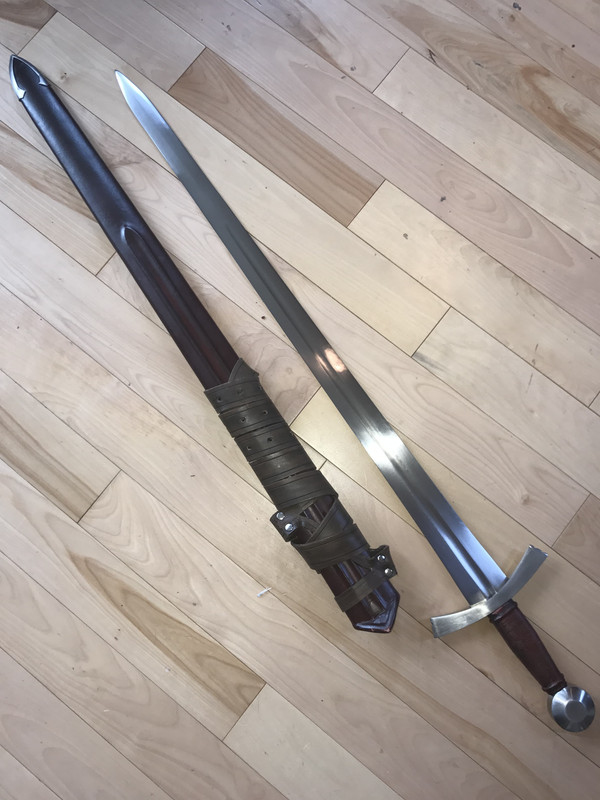
Valiant Armoury - Malatesta. Early version before they made the profile change in the blade. Hex nut construction. My "fastest" sword by far given the weight and balance. This is a fun fun cutter for light to medium targets and probably the one I would use if I wanted to overcome an opponent with sheer speed and agility in an unarmored dual.

Christian Fletcher - Winter Warden. I was the first to commission a complete kit for this, including it's specialized and dedicated scabbard. Incidentally his photos in his gallery are those of my exact sword.
Angus Trim - Type XIIa.4 (dubbed "Blackwater") hilted by Tom Kinder with scabbard by Jonathan Sarge (Crusader Monk). I am like the 8-9th owner of this as far as I have been able to determine. This beauty has improved with each owner and now sports a Lonely Wolf Forge "god-cutting" edge. You can read my full review of this sword here.
Angus Trim - XVIa.3. Considered one of the best Angus Trim blades for the Fiore style. This blade is elegant, long and extremely agile. I personally have tended to favor the Type XIIa style previously but, while XIIa is still my favorite type, this XVIa is purely a delight to handle.

Angus Trim - XIIa.2. My third Atrim and I absolutely love it. It is not as authoritative as my XIIa.4 nor as agile as my XVIa.3, but it sits somewhere in between and makes a nice midpoint between the massive war sword and the agile Fiore-suited longsword. Grip and scabbard are custom work by Sonny Suttles at Valiant Armoury’s custom sword shoppe.
Christian Fletcher - Original Borderwatch built on an Angus Trim 1313 blade. One of Christian’s original Borderwatch swords built on an Angus Trim 1313 type XIIa blade. These predate the move to Albion as a blade supplier as well as the blade type change to the XVIa we know and love today. The beauty of this sword is the insanity that was collaborations between these two masters, with Christian’s hilts and Angus’ amazing performing blades. Fun fact: This sword is “famous”. This exact sword was photographed and appears on the cover of this book.
(Better pics coming later)
Tomas Diamante & Green Shield Workshop - Elven sword. Custom leaf-bladed bastard sword by Tomas Diamante with brass inlay fittings. This is my first piece by Tomas and it does not disappoint. Very quick and agile this sword absolutely has a Lord of the Rings feel to it. My full review of this sword is available here.
FableBlades - Blade of Evil's Bane. The first "Legend of Zelda" Master Sword made by Brendan. He and I co-designed this sword and iterated on specifications based on my own initial concept sketches. More info on FableBlades' site. Additionally, my full review of this sword is available here.
FableBlades - Gladius Herois Aevi. The 2nd master sword made by Brendan. Upon its commission I got in touch with the owner and asked for first right of refusal if and when he ever sold it. When he did, I snatched it up. More info on FableBlades' site.
FableBlades - PeaceLily. The sword that made me notice Brendan's work to begin with. I recently was able to have a chance to acquire this fine blade and I jumped at it. I could not be more pleased. It handles like a dream and the fine details are amazing. I received it from its previous owner, polished her up some to clean off some tiny spots of rust and now she's looking once again pristine.
FableBlades - Saber and Dirk of Dúathg'aul. These swords were originally commisioned by our SBG's own Shadowhowler (which is the translation of "Dúathg'aul"). More info on FableBlades' site and review by Shadowhowler here.
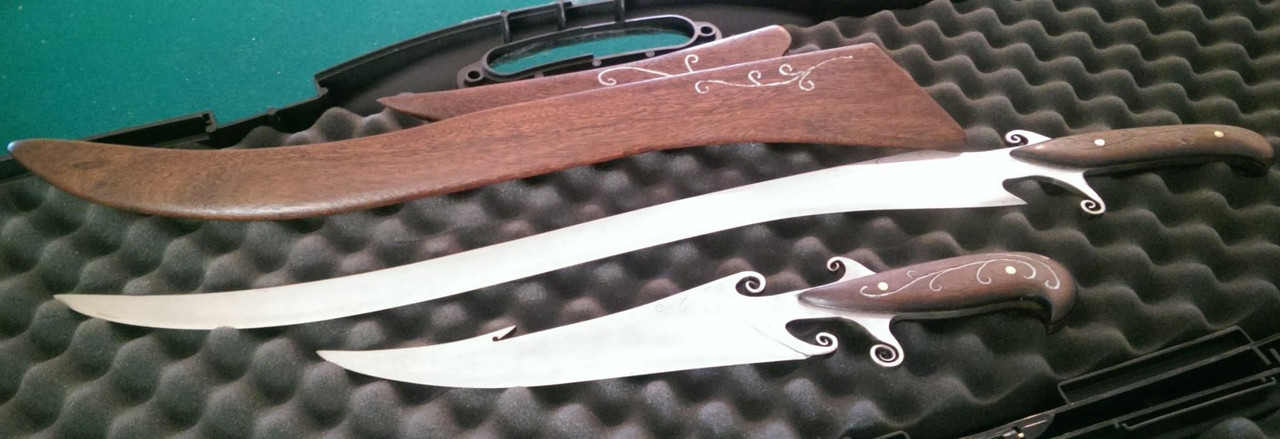
Windlass Steelcrafts - Knightly Hand & Half Sword. Old 90s era, purchased from MRL when I was younger. This sword will be the basis of a complete overhaul at some point to rehilt, build a scabbard. I am debating turning this into a Narsil (since I think it's probably better than a DSA one) and will likely be a revamp project in my future.
Del Tin - Unicorn Sword. The first sword I ever bought at age 12. Early MRL purchase that i saved ALL summer for working odd jobs. Made of CK-55 Krupp steel (I think a german AISI 1055 equivalent?). Fun little sword. Maybe will someday be a rehilt project as well but have been reticent to touch it because it was my first sword. You can read my full review of this sword here.
HSTS - Custom Katana. I'll not say much given conversation about this vendor is verboten, but some of my favorite reproduction katana. Differentially hardened 1095 steel with a good spring to help prevent taking a set. Excellent edge geometries. Very tight alternating ito with hishigami. Great cutters that have held up flawlessly.
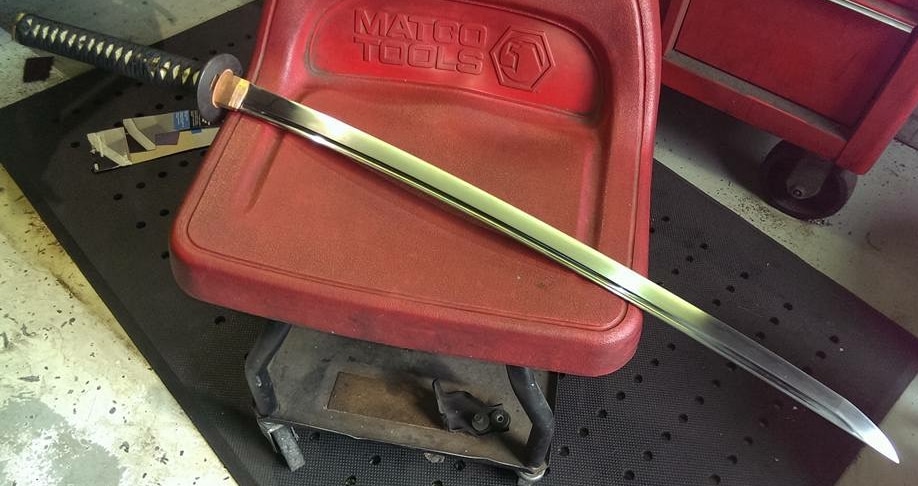
HSTS - 1095 Budget Cutter Katana.

Hanwei - Shinto Katana. Early 2000s model that was originally a shirasaya no-bohi version purchased by Sanmarc Forge. It then underwent a complete revamp by SlavEdge including a hamon re-etch and a longer custom tsuka. This blade cuts like a freaking LIGHTSABER. I LOVE this sword. Sanmarc loves Shintos so much he went out and bought a Manchurian steel prototype one.
Huawei - T-10 Katana. Not their highest end model, but a decent middle of the road one with "geometric yakote" (don't get me started, as I own multiple nihonto and what most forges call geometric yakote are not exactly correct, yes technically they have a geometry change, but definitely NOT exactly historical in correctness). A fabulous blade with a gunome/midare hamon and hishigami itomaki. Razor sharp and is a wonderful cutter that has held up flawlessly.

Kawashima - Ko-Katana. Unclear yet on manufacturer but clearly a higher end blade when compared to other reproductions. I'd say of equivalent quality to a high end Paul Chen or such. It's mono steel of some kind, from the luster I'd say probably 1095. The tsuka is well executed and ito is tight. The saya is well made and fits the blade perfectly and is accented with a nice rattan wrap that is lacquered. If anyone knows what this might be I'd love to hear opinions. I am currently thinking this is a Kawashima of some sort. Possibly a custom Kawashima.
Daishos
Ten Ryu - Daisho, Katana (model TR-004) and Wakizashi (TR-005). Personally my favorite sub $150 katana (these sell for about $125) and Wakizashi for under $100 ($85 current price). AISI 1045 differentially hardened steel so not the hardest, however, there are some details (most specifically the actual (magnetic) iron musashi style Tsuba which you NEVER find at this price point, a pretty decent hamon with lots of activity and while 1045 the heat treat seems solid. I've done lots of cutting with these and they are holding up VERY nicely.
Unknown Daisho. I don't know much about these, other than they are clearly through hardened, double pegged and have pretty inexpensive ito. The fittings are low-end but decent ones you find on chinese forged blades. (No pics handy but will update later with photos).
I've a modest collection of knives too but nothing particularly interesting I don't think. (unless you guys want to see them)
(unless you guys want to see them)
Display
Display-wise I tend to do the UV-protected case and a "picture collage" type wall layout in my home. This makes them nice displays and placates the Mrs. when it comes to swords everywhere (though she also likes swords, but wants our home to remain elegant looking). Also helps keep unwanted fingers off the blades.
Here are some examples of how I have my blades displayed:

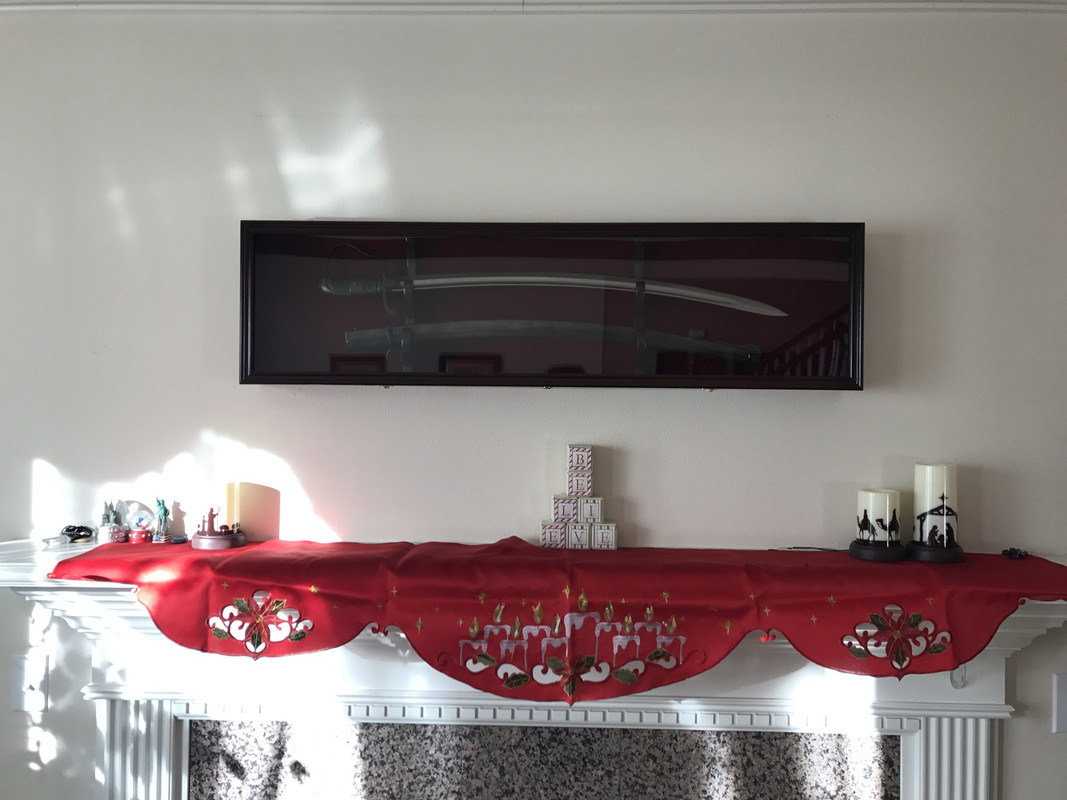
I'll try to do this structured with individual photos and then some photographs showcasing how I have them displayed.
Table of Contents
Antiques
- Preußen Artilleriesäbel n/A
- Bishu Osafune Masamitsu Tachi
- Jirozaemon (no) jo Katsumitsu O-Wakizashi
- Sekishū Izuha Sadatsuna Katana
- Mutsu Aizu Unju Kanetomo Katana
- Mutsu no Kami Tameyasu Wakizashi
- Ko-Uda Wakizashi
- Kaga ko-wakizashi
Valiant Armoury
Christian Fletcher
Angus Trim
Christian Fletcher & Angus Trim
Tomas Diamante & Green Shield Workshop
Fable Blades
Windlass Steelcrafts
Del Tin
HSTS
Hanwei
Huawei
Kawashima
Ten Ryu
Unknown
Antique Swords
My ancestral Prussian artillery saber (Preußen Artilleriesäbel n/A).This has been passed down from father to son through my family for a few generations. This is a family sword. Its origin goes back to the British 1796 light cavalry saber with evolutions occurring up through World War I. Many refer to this model as the 1896 or M96 artillery saber. Full history of this pattern of sword and its evolution has been fantastically compiled by another SBG member here.

Osafune Masamitsu Tachi. Signed “Bishu Osafune Masamitsu” and dated 1390 AD by the famous Bizen smith Osafune Masamitsu. Masamitsu was one of the greatest students of Osafune Kanemitsu who was one of Masamune's great 10 "Juttetsu" and the founder of the Soden Bizen style. This style seamlessly blended the Soshu elements of Masamune and the Bizen grand master Kagemitsu (who was Kanemitsu's father). Osafune Masamitsu had extant works spanning 40 years and has 48 pieces that are Juyo Token. This is an absolutely flawless Tachi representing his later career as he returned to the stylistic elements of the Kamakura period versus the massive blades typical of the Nanbokucho period. This blade is papered by both the NBTHK and NTHK. Suspended seashell in lacquer tachi mounts with signed tsuba and gold inlay/foil fittings.
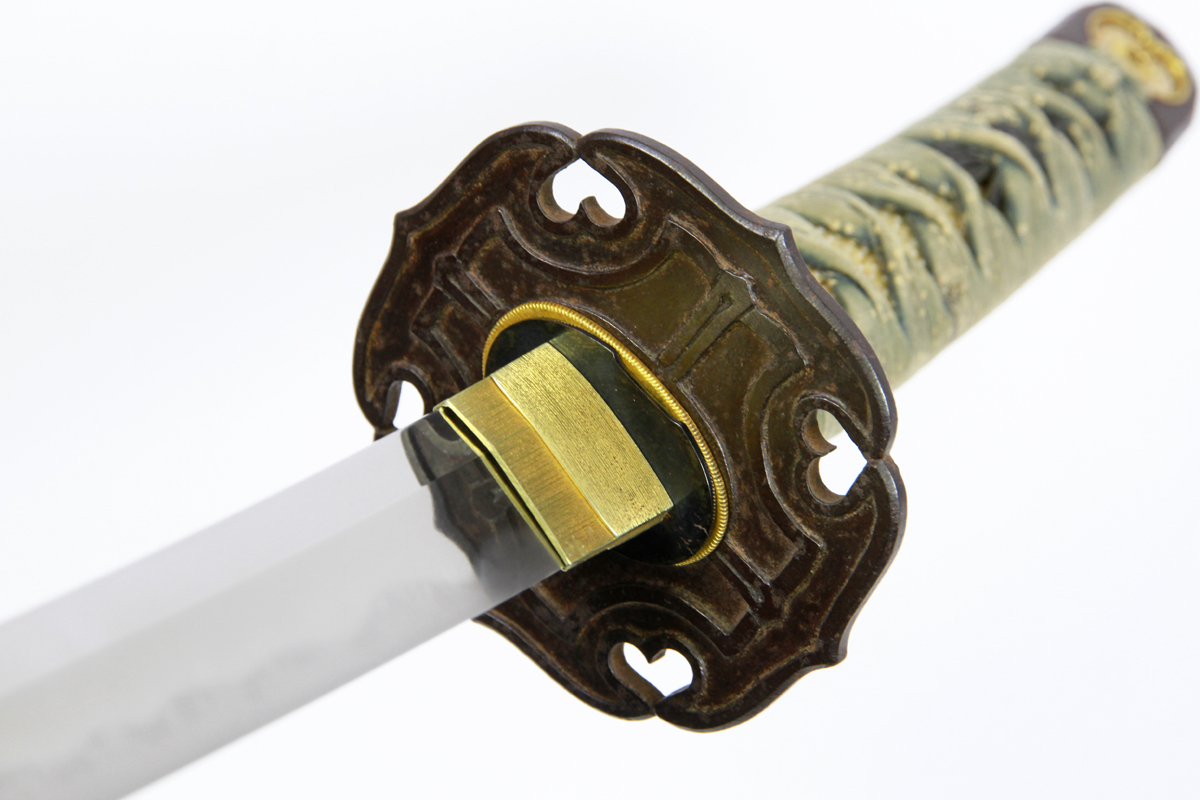 | |
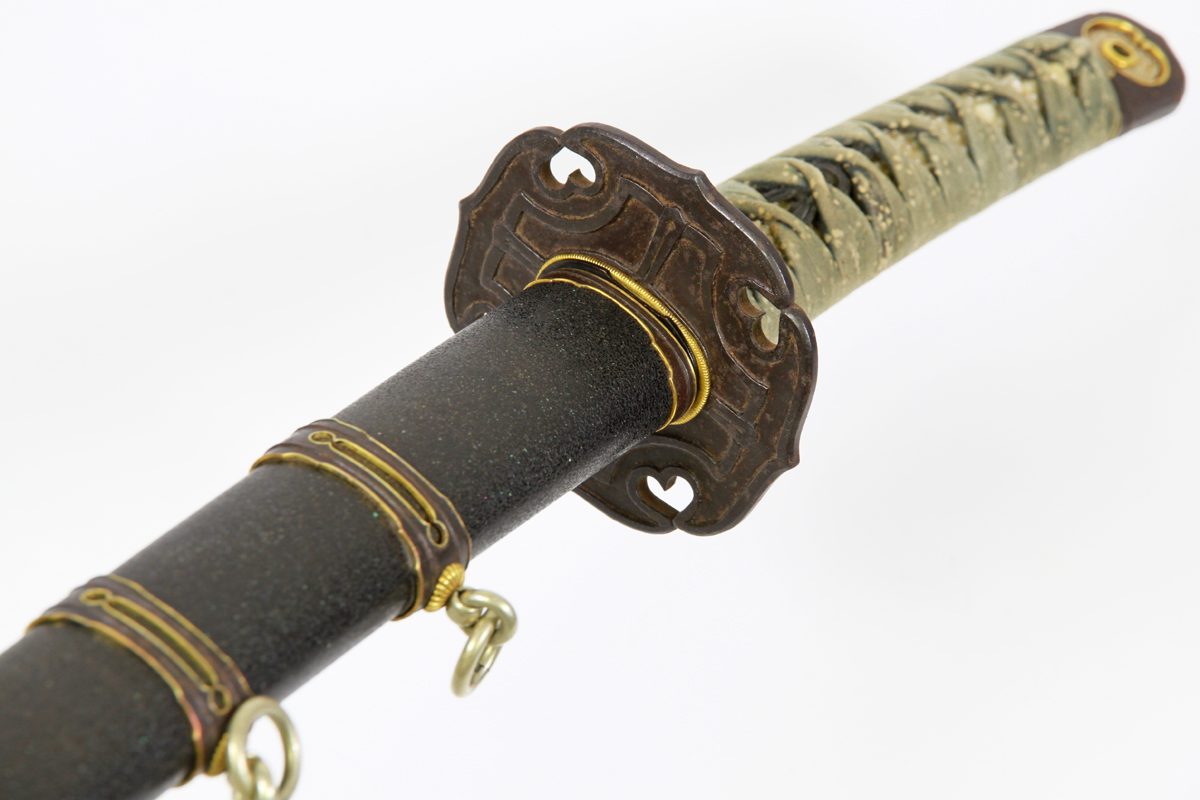 | 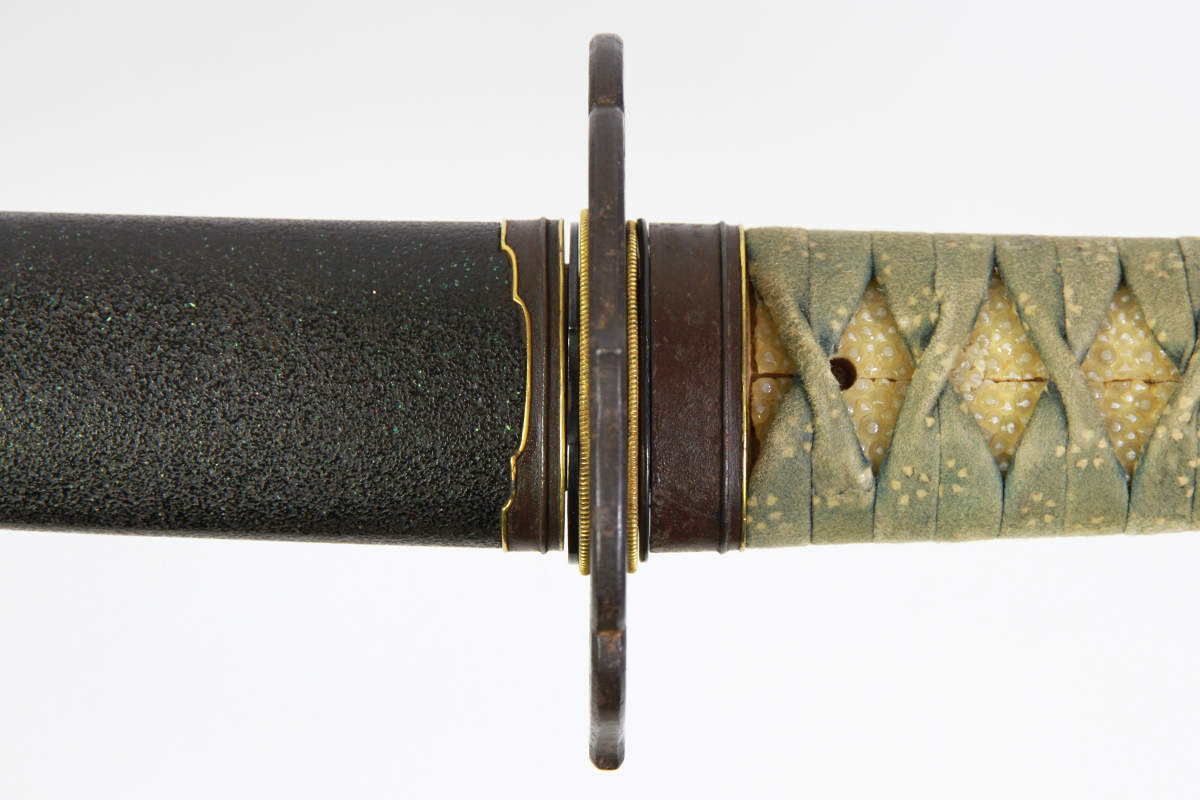 |
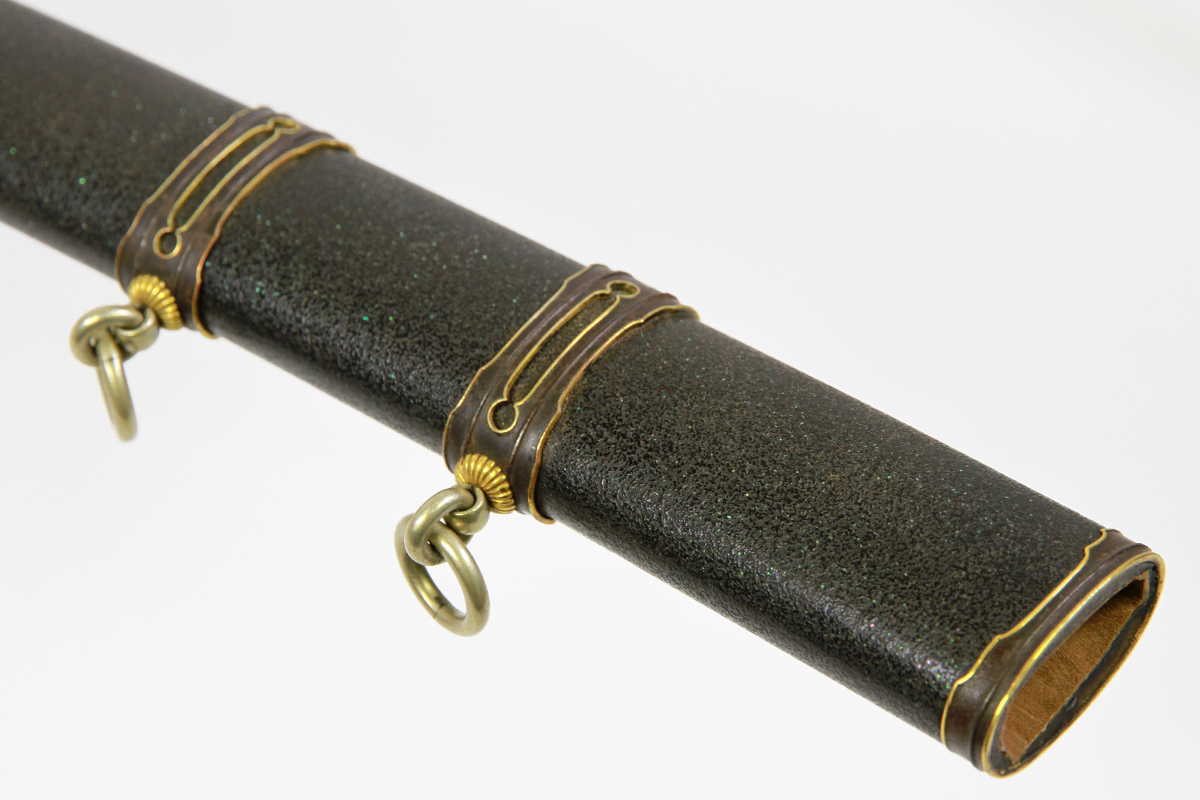 | 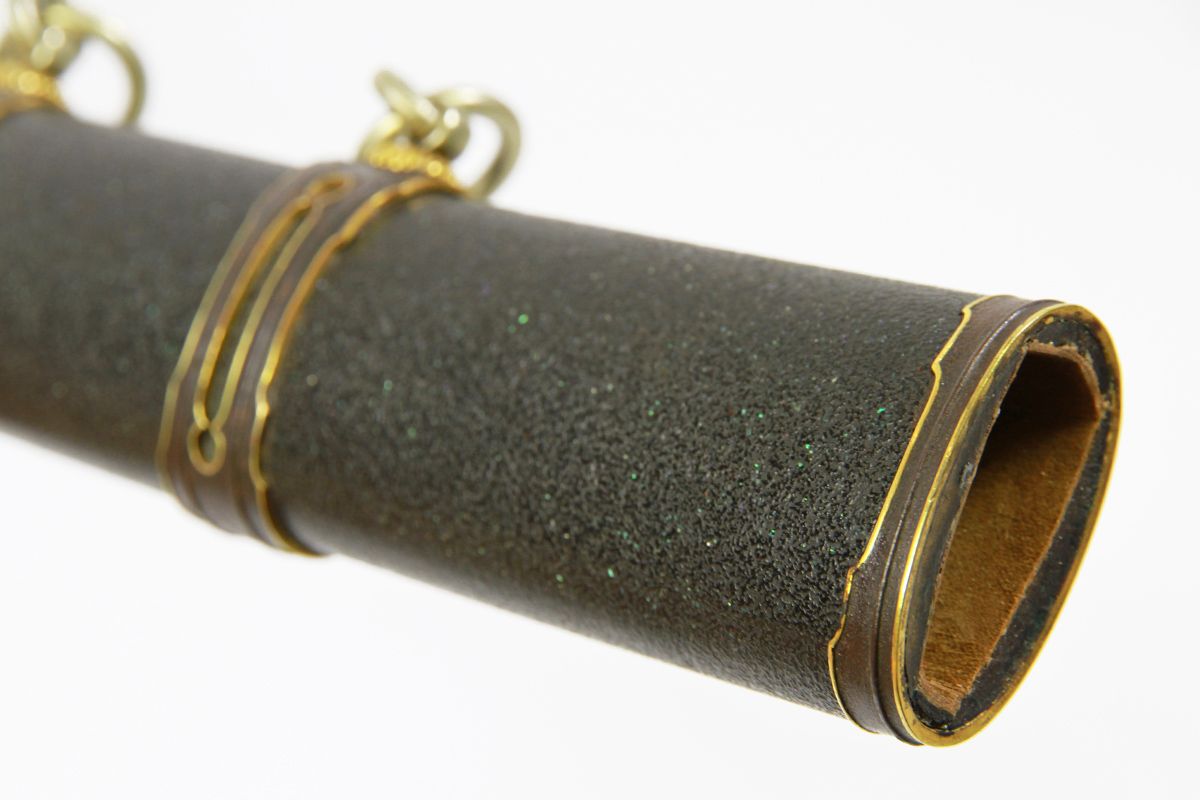 |
 | 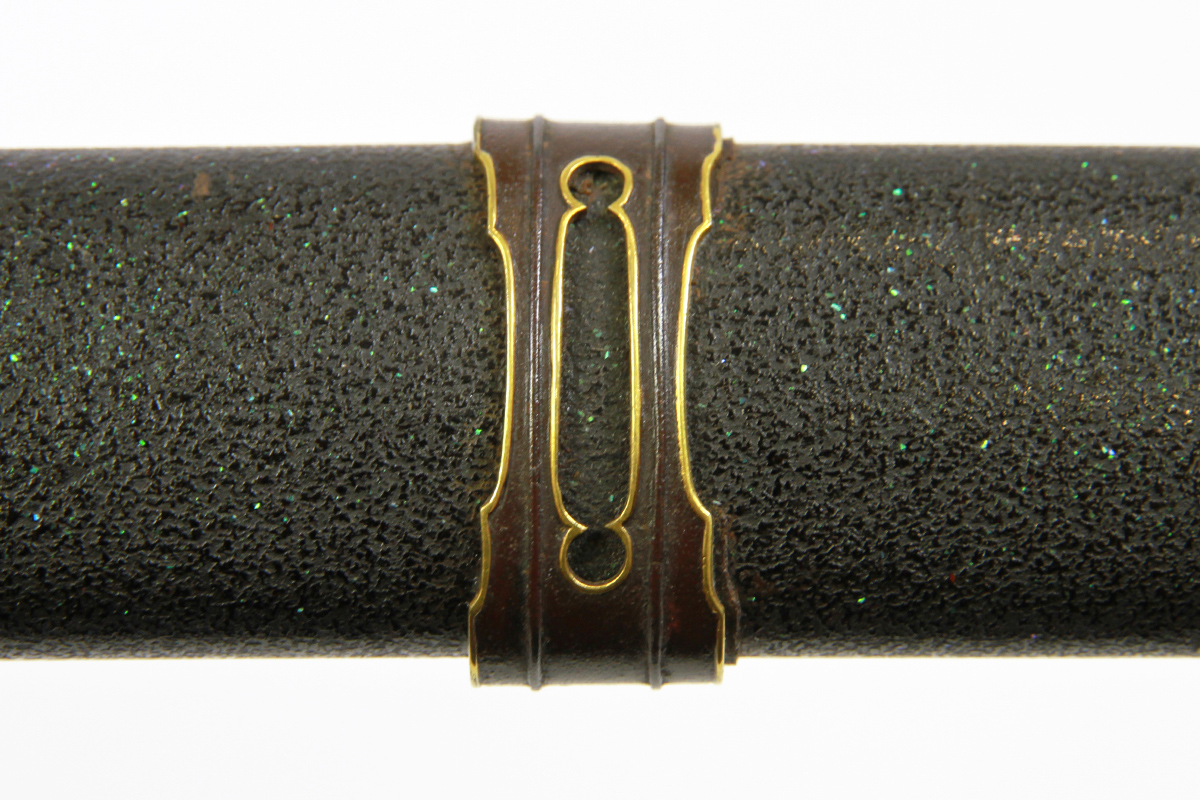 |
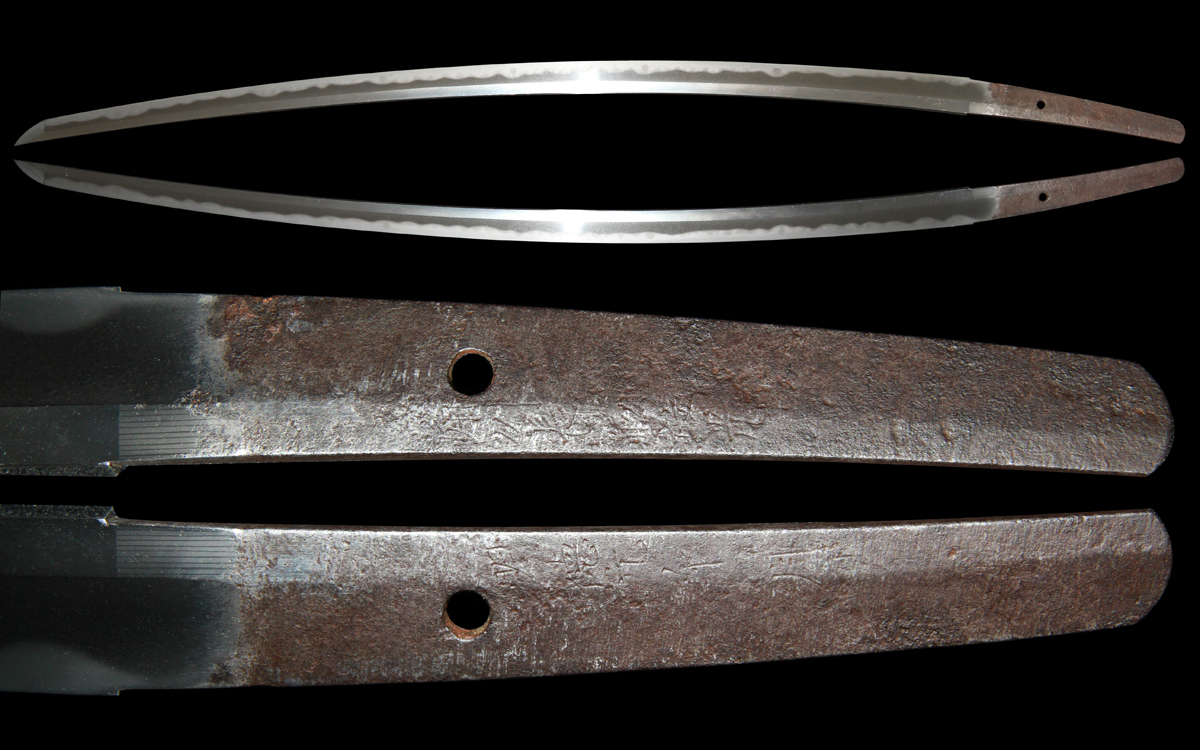 | |
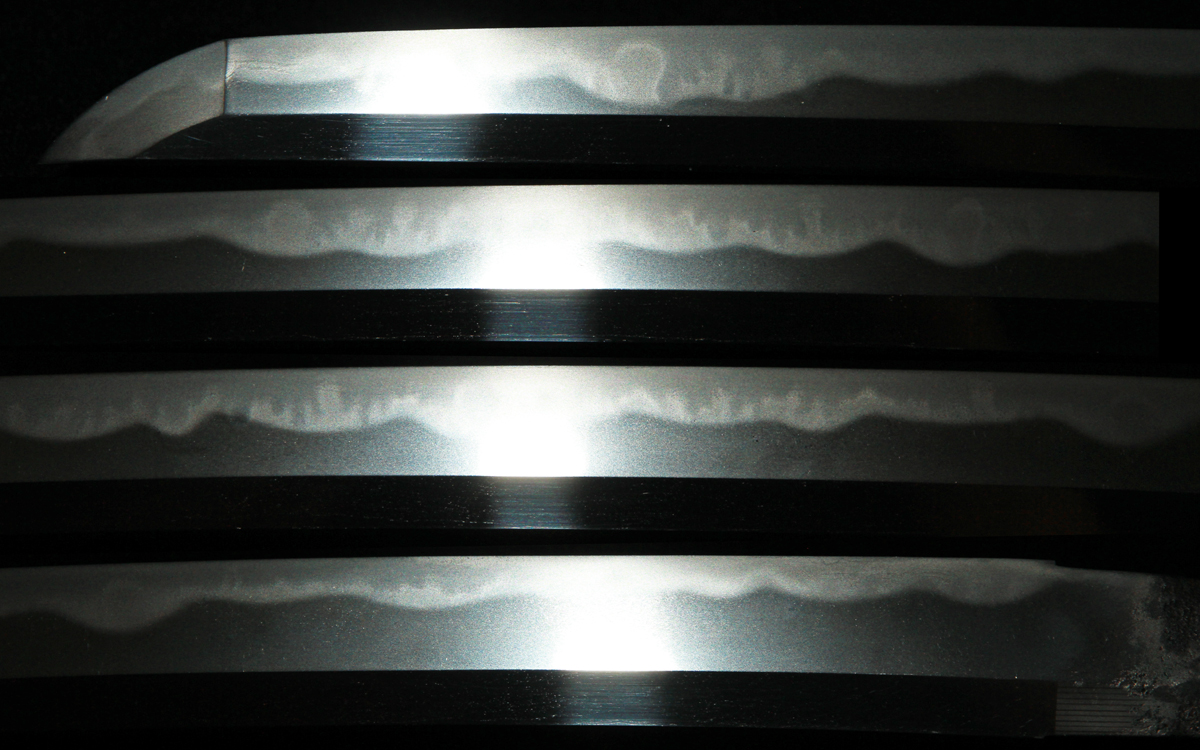 | 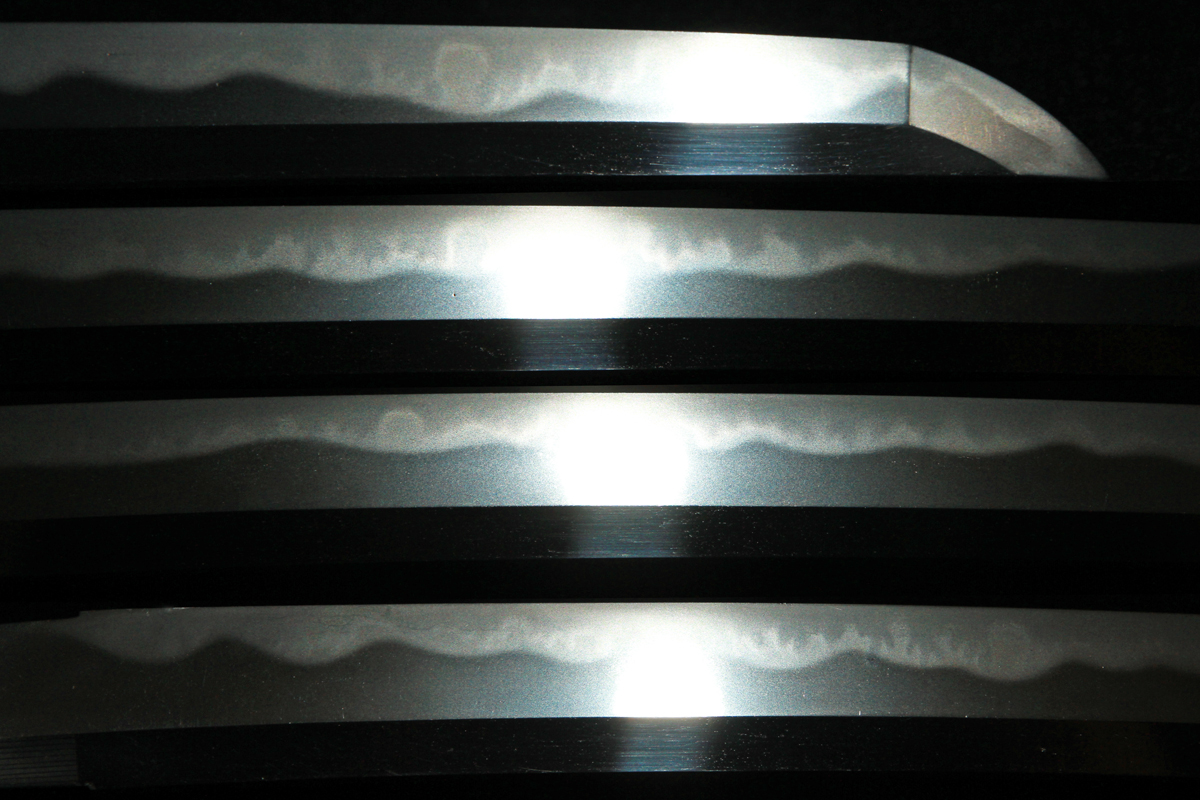 |
 |  |
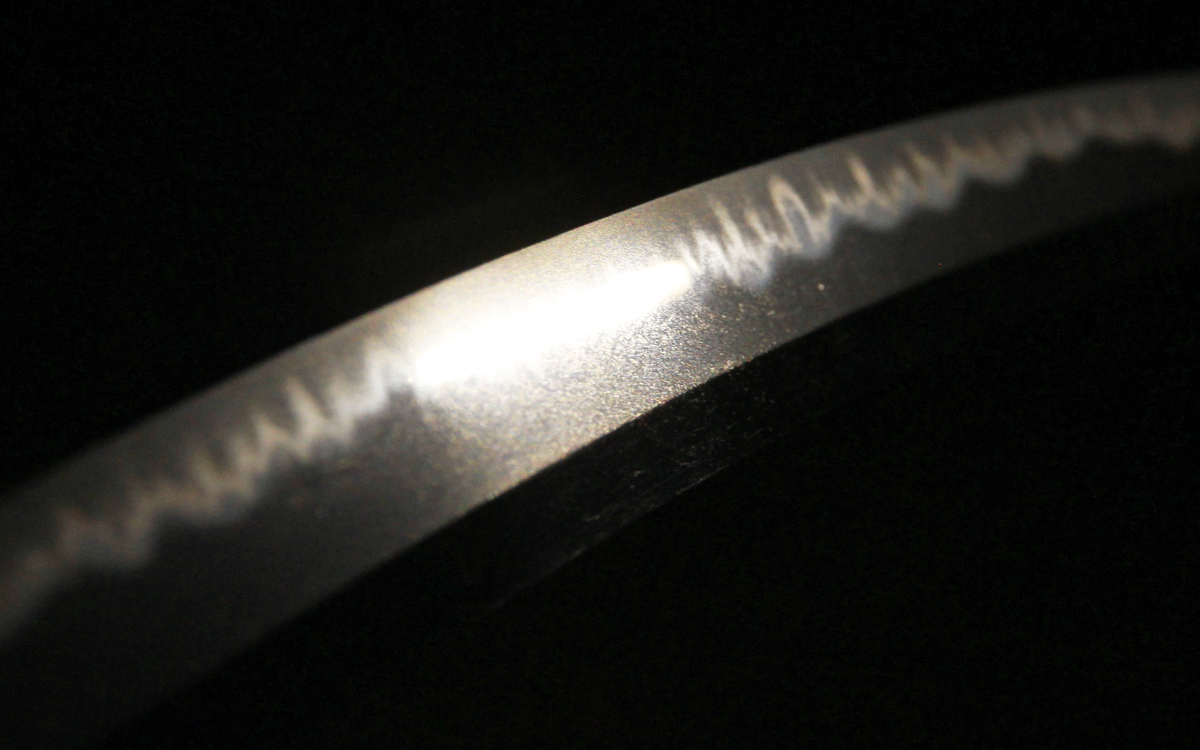 | 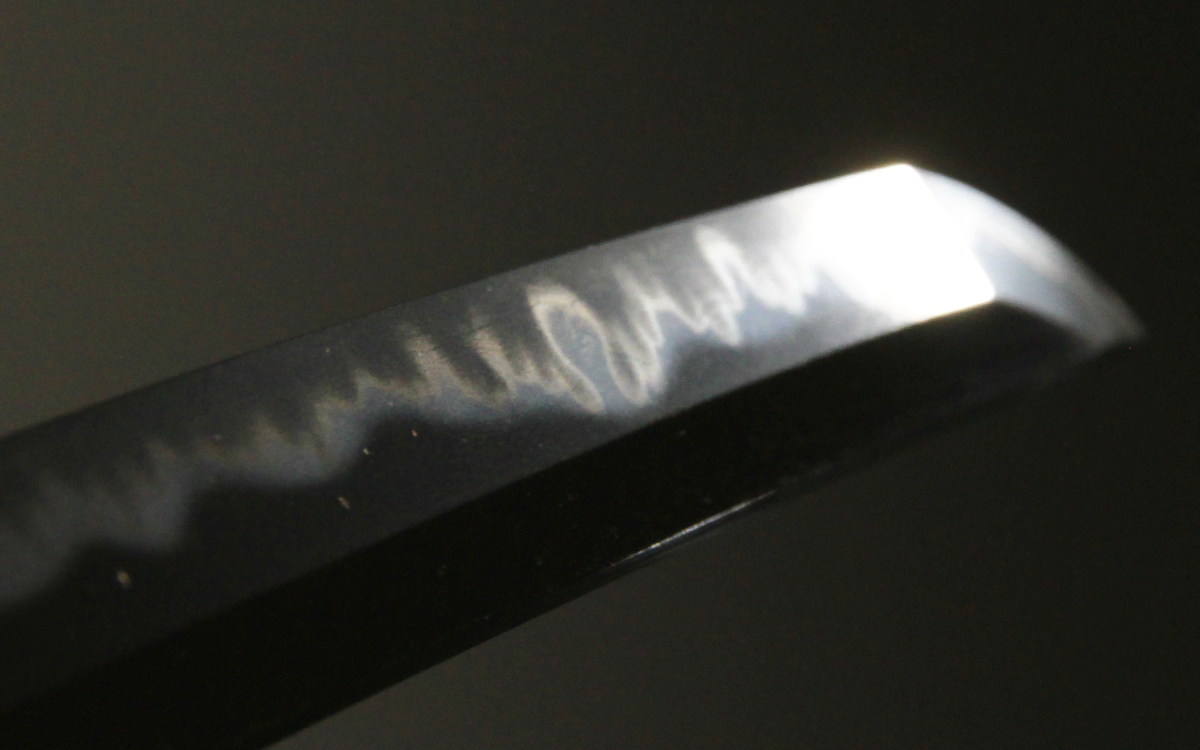 |
Jirozaemon (no) jo Katsumitsu O-Wakizashi. Bizen koku ju Osasufune Jirozaemon (no) jo Katsumitsu was one of the greatest smiths of the Oei-Bizen period. Son of the grand master Ukyo no suke Katsumitsu, Jirozaemon had an active period in the early 1500s. He was ranked Saijo-saku (grand master) and his blades were ranked Ryowazamono for their famed cutting ability. This Smith worked during the warring states period of Japanese history when many blades were mass produced and famed smiths’ had their works forged by others, yielding many gimei that claimed famous names. This blade has been verified shoshin by the NBTHK and represents the signature style of Jirozaemon’s early works according to the Keikan Mei. Dated to February in the first year of Eisho (1504 AD), it is unclear whether this blade is a clear wakizashi or was originally an uchigatana for a smaller stature samurai. Uchigatana were in vogue during this period of time, sporting shorter blades and nakago (tangs) which were mounted for use in a single hand. This blade sits at 23” in length and could have been either an uchigatana or a wakizashi, originally. We’ll never know! Nonetheless, the beauty of this blade is irrefutable. Accompanied by Edo period koshirae including intact kozuka and kogatana as well as coral suspended in lacquer saya.
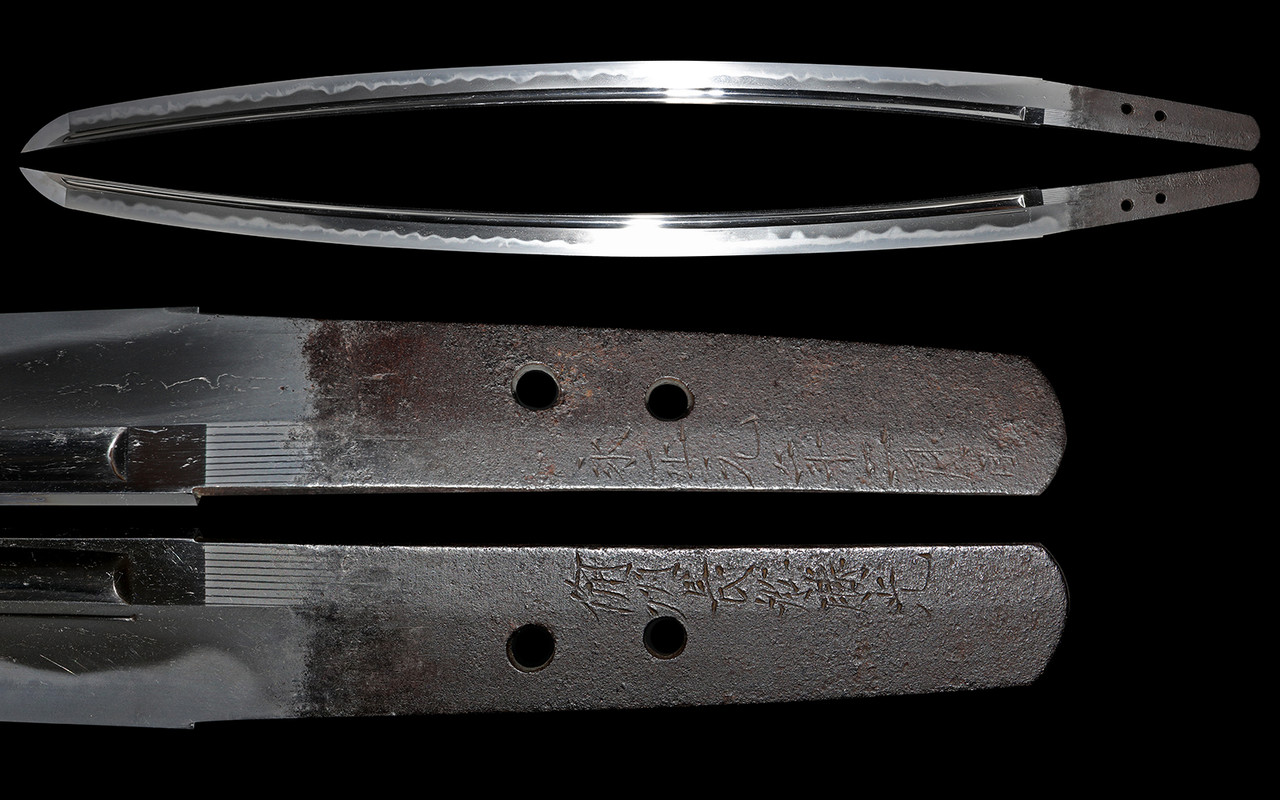 | |
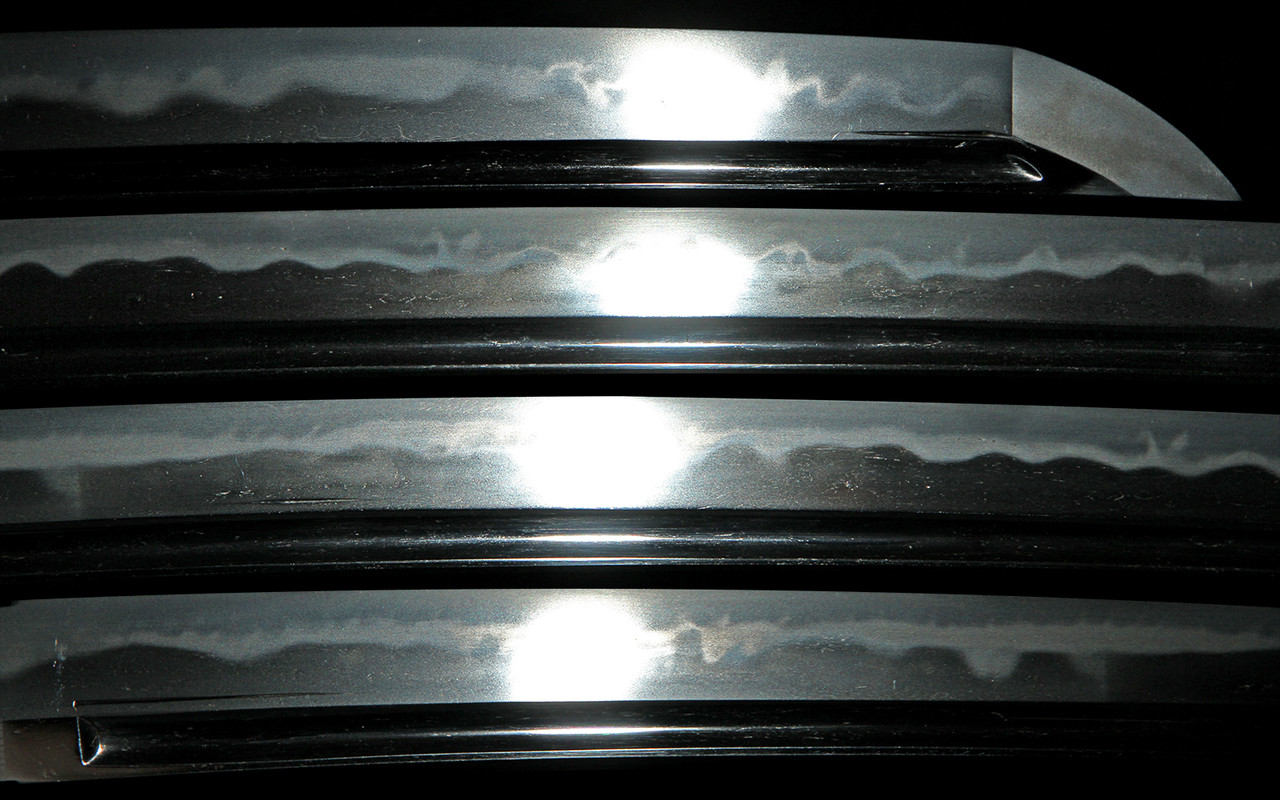 | 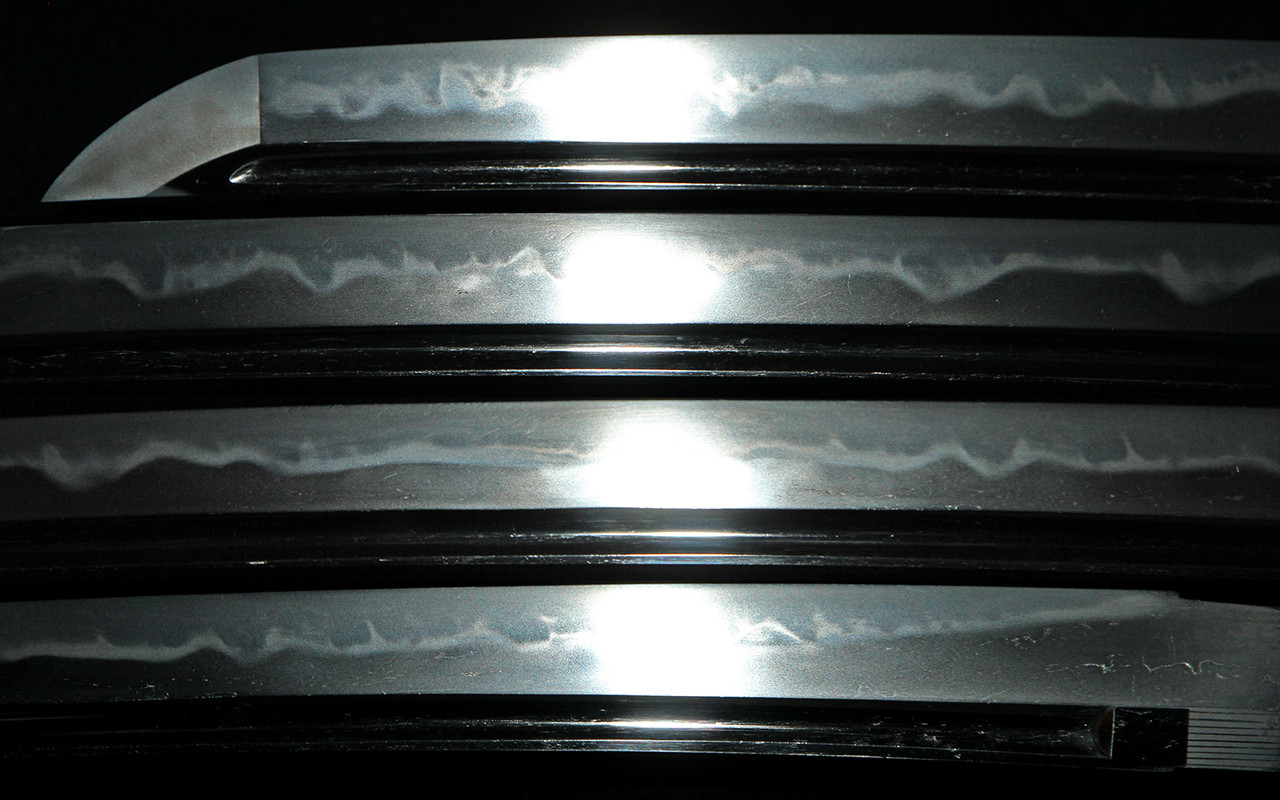 |
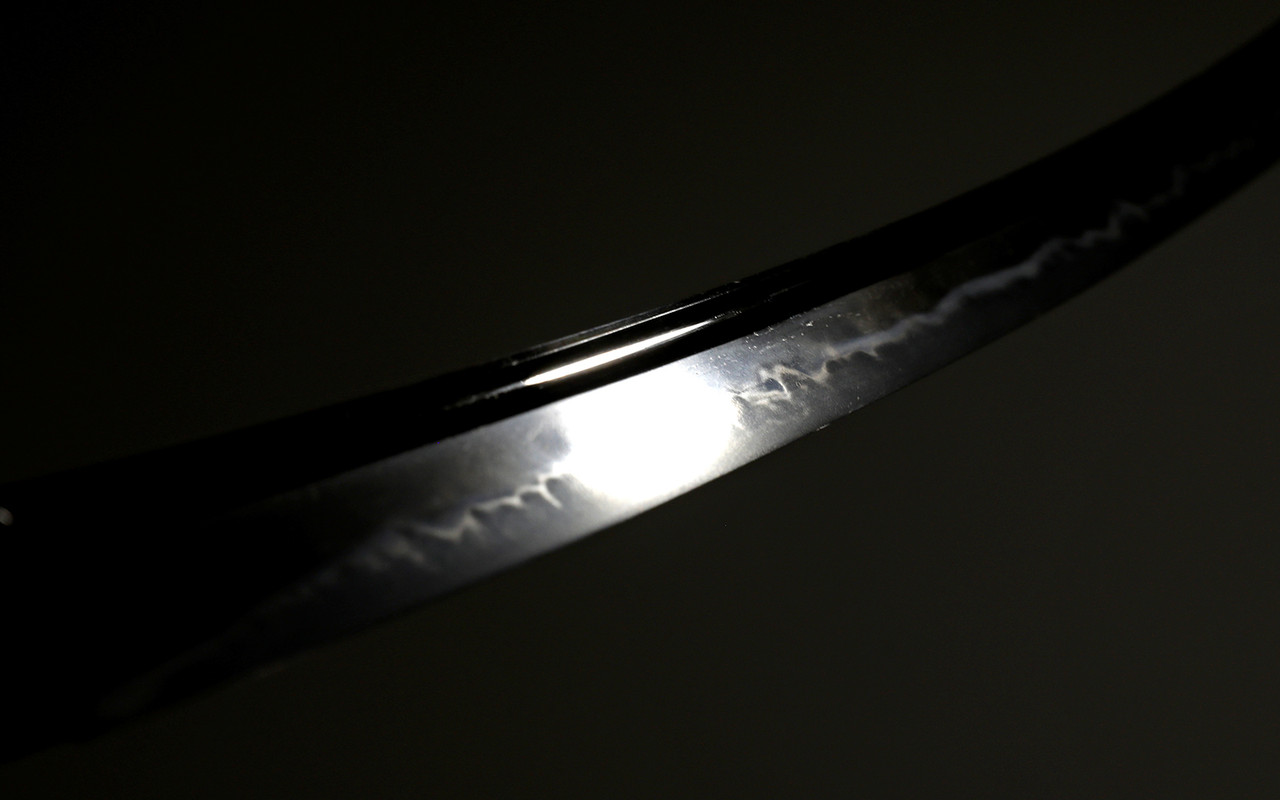 | 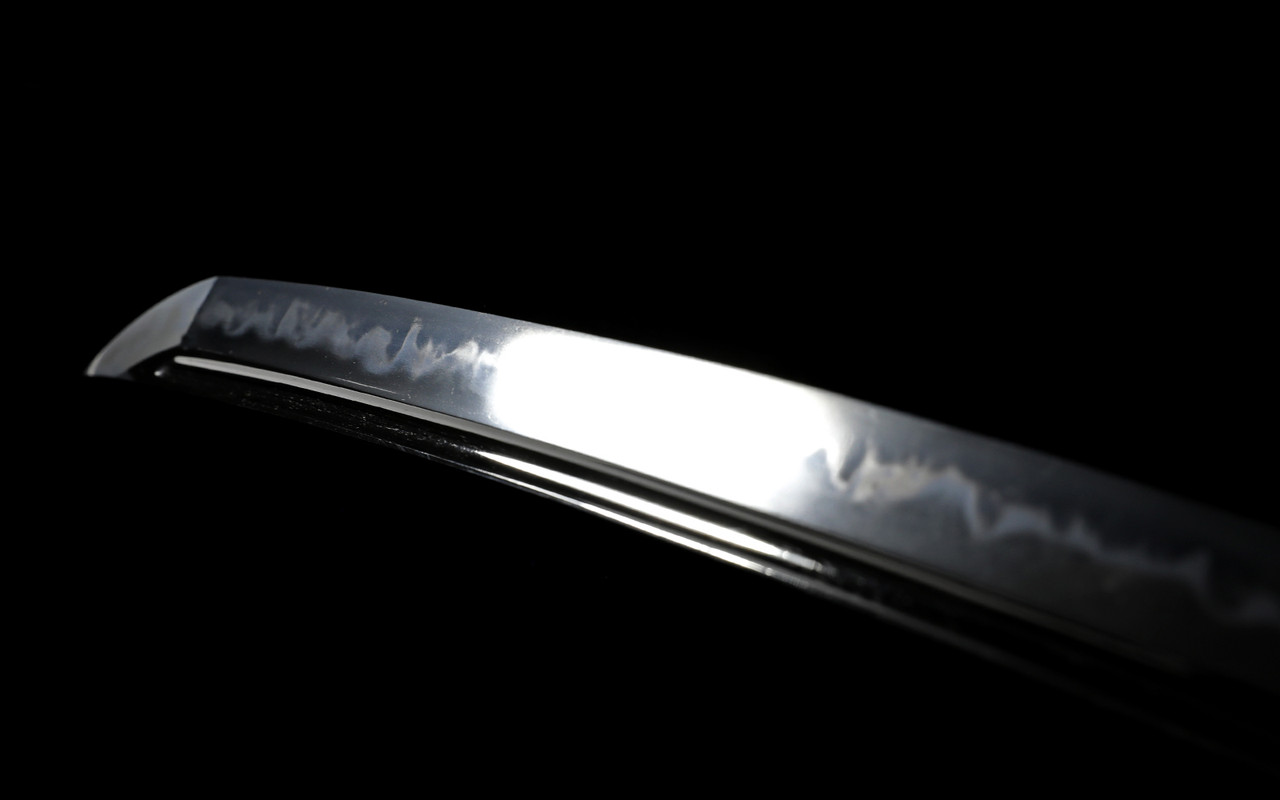 |
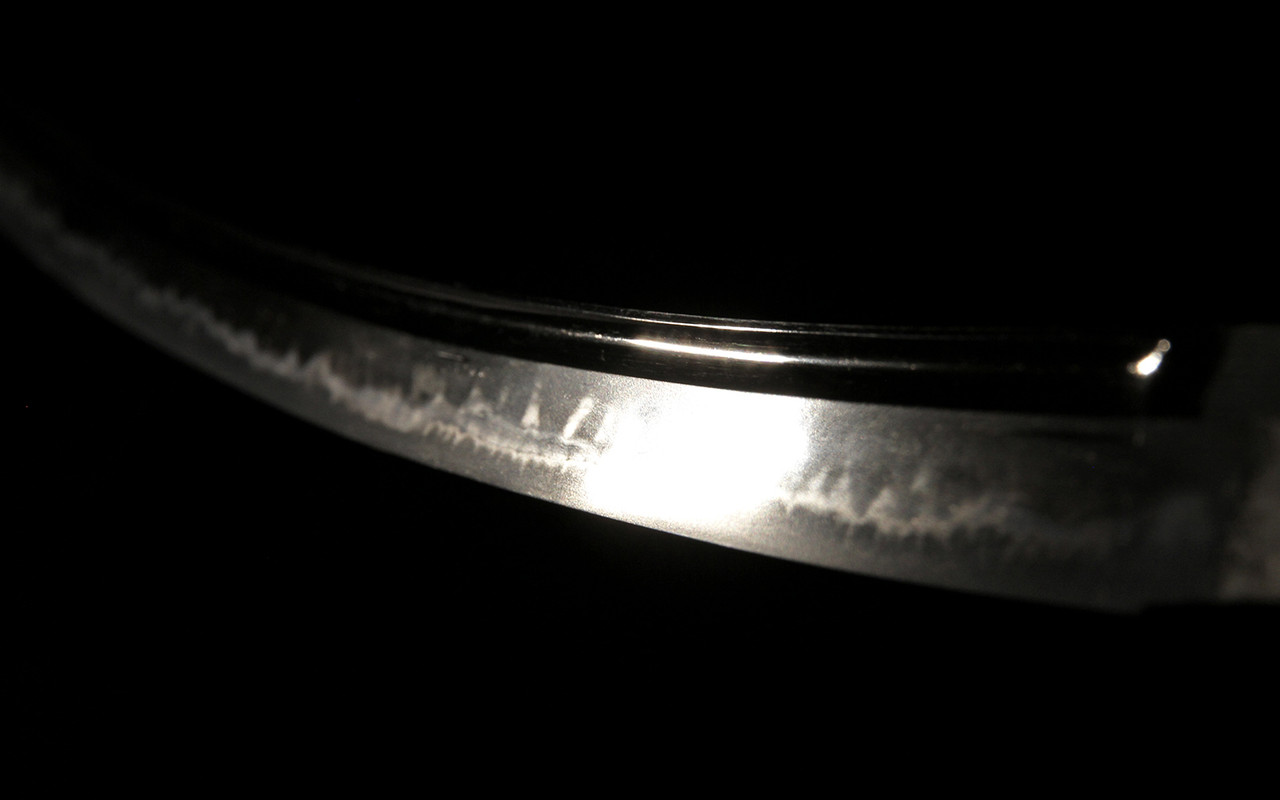 | 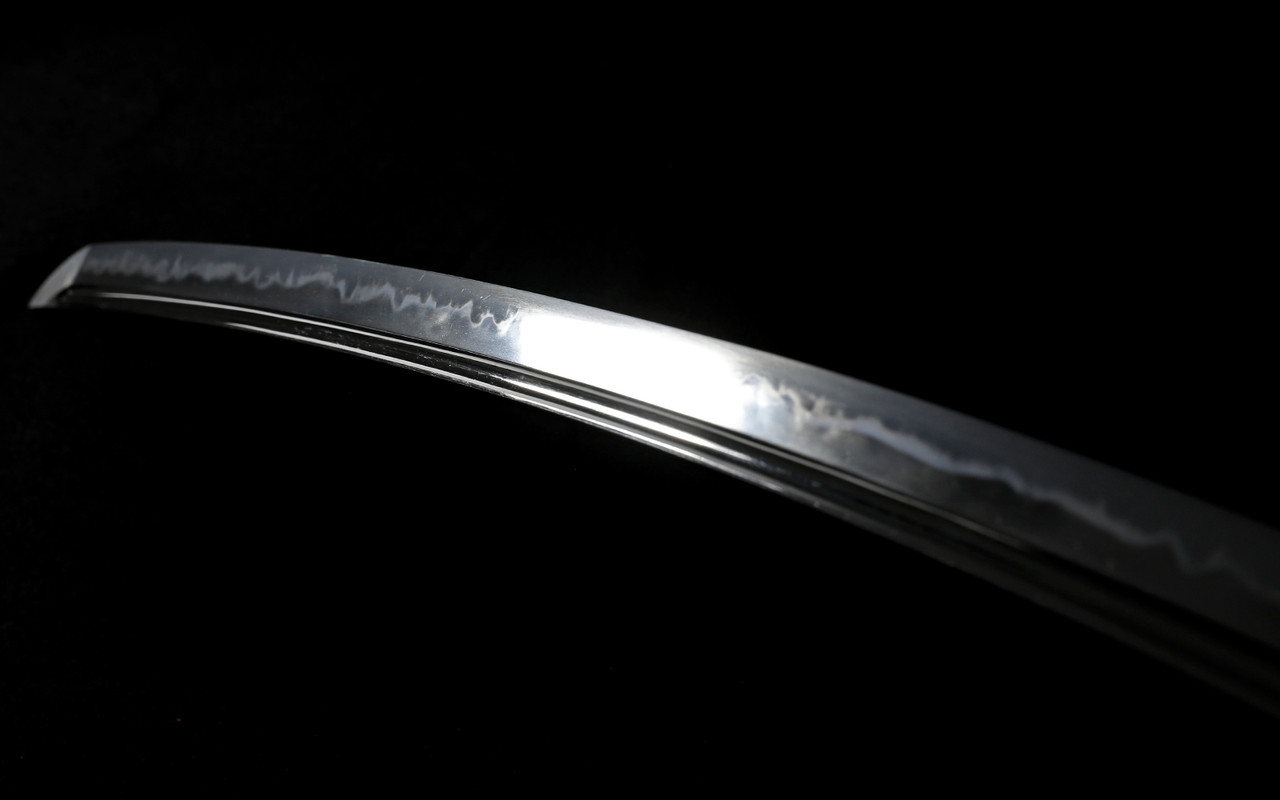 |
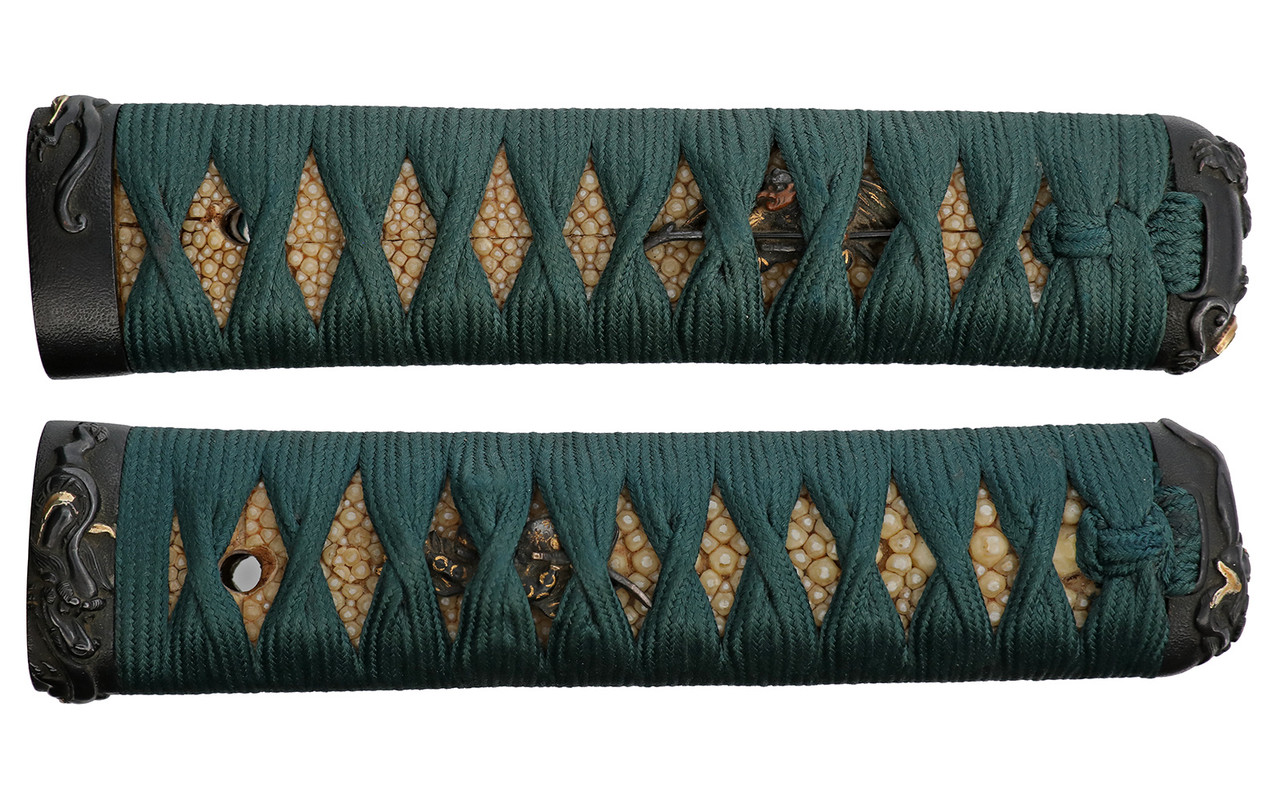 | 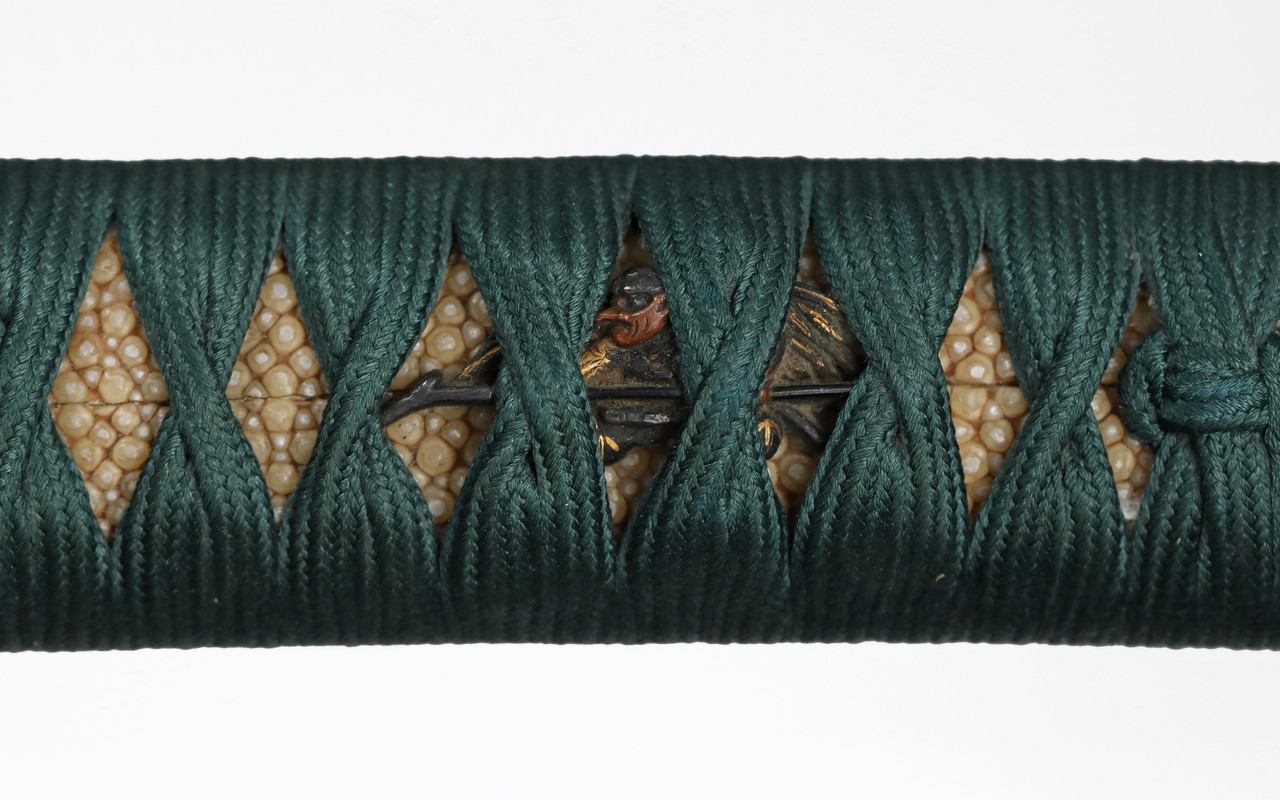 |
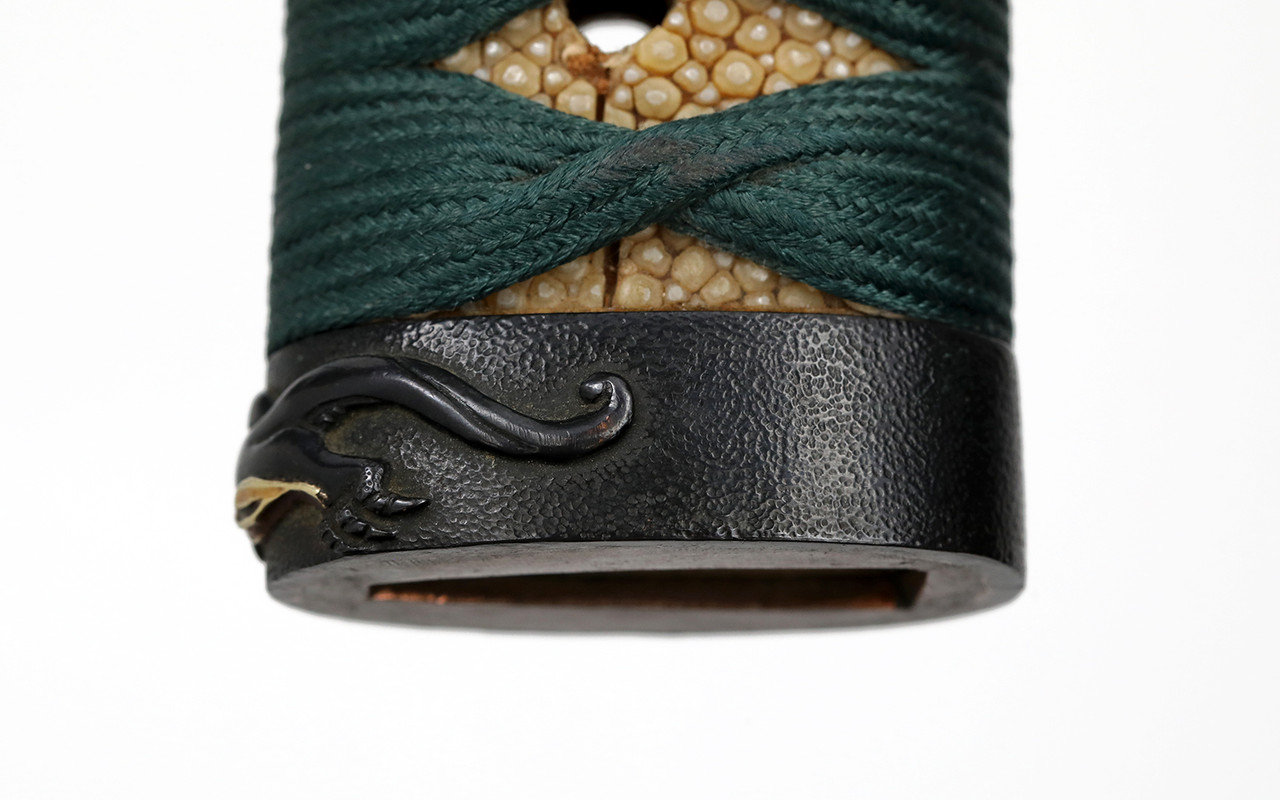 | 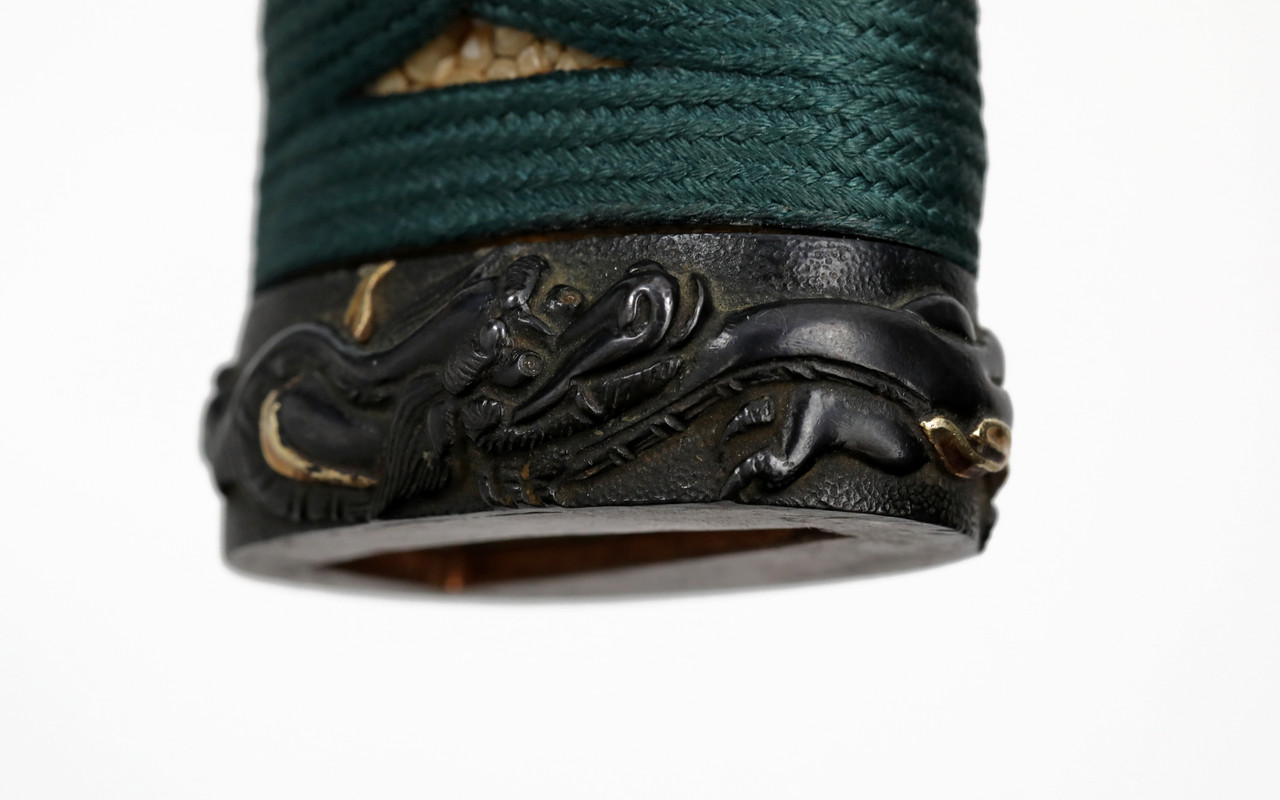 |
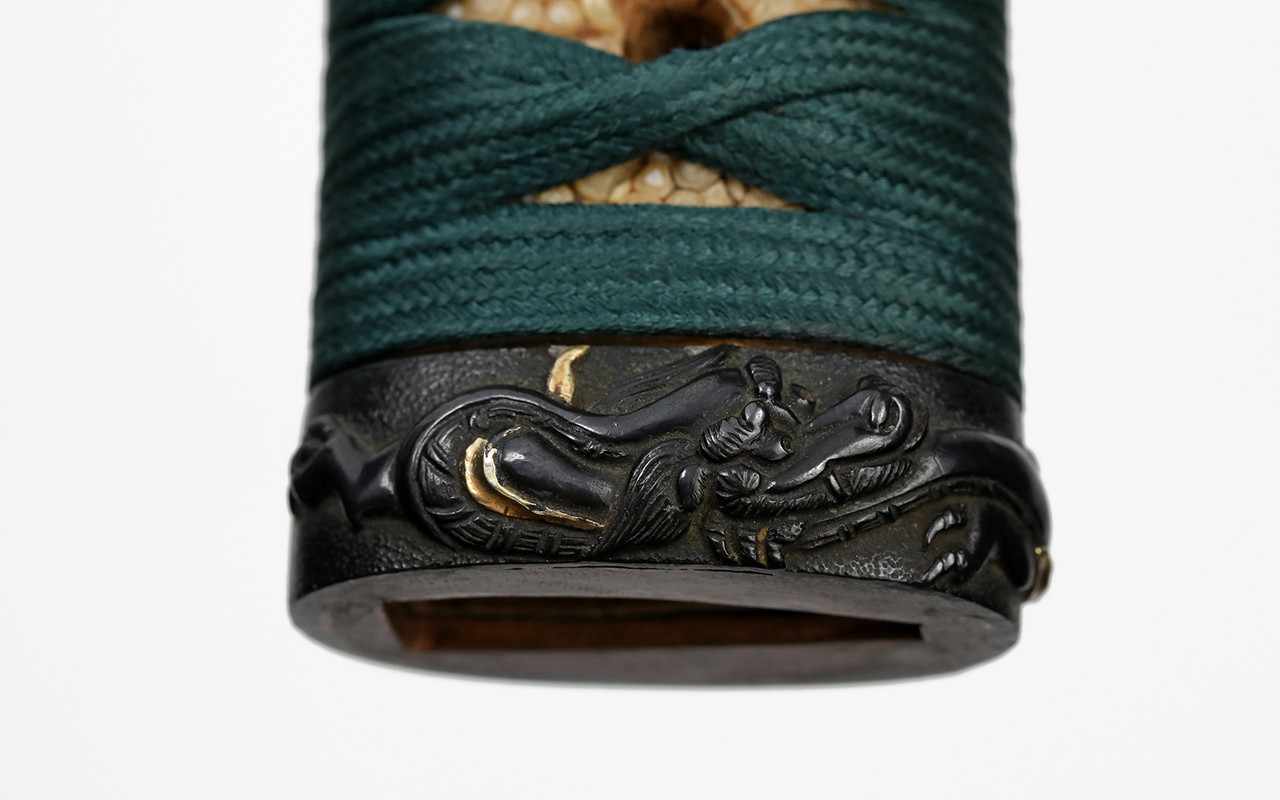 | 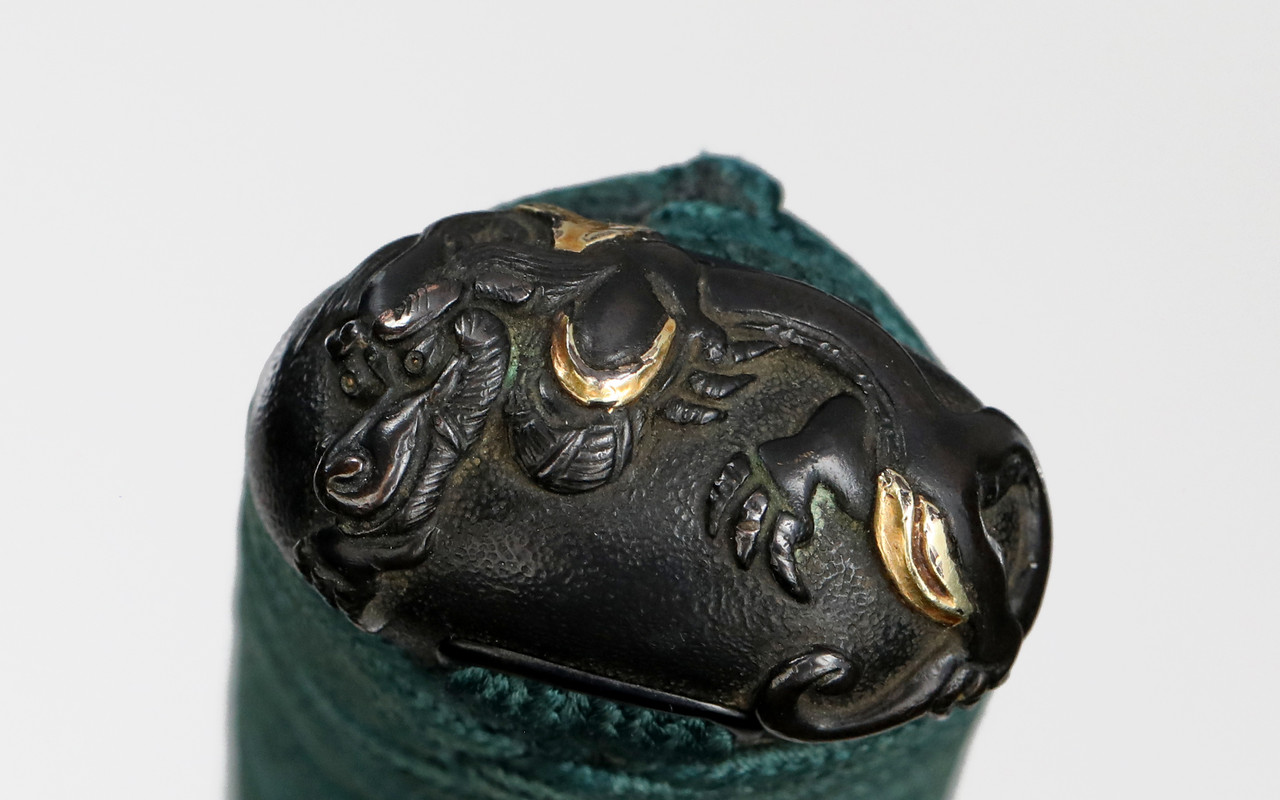 |
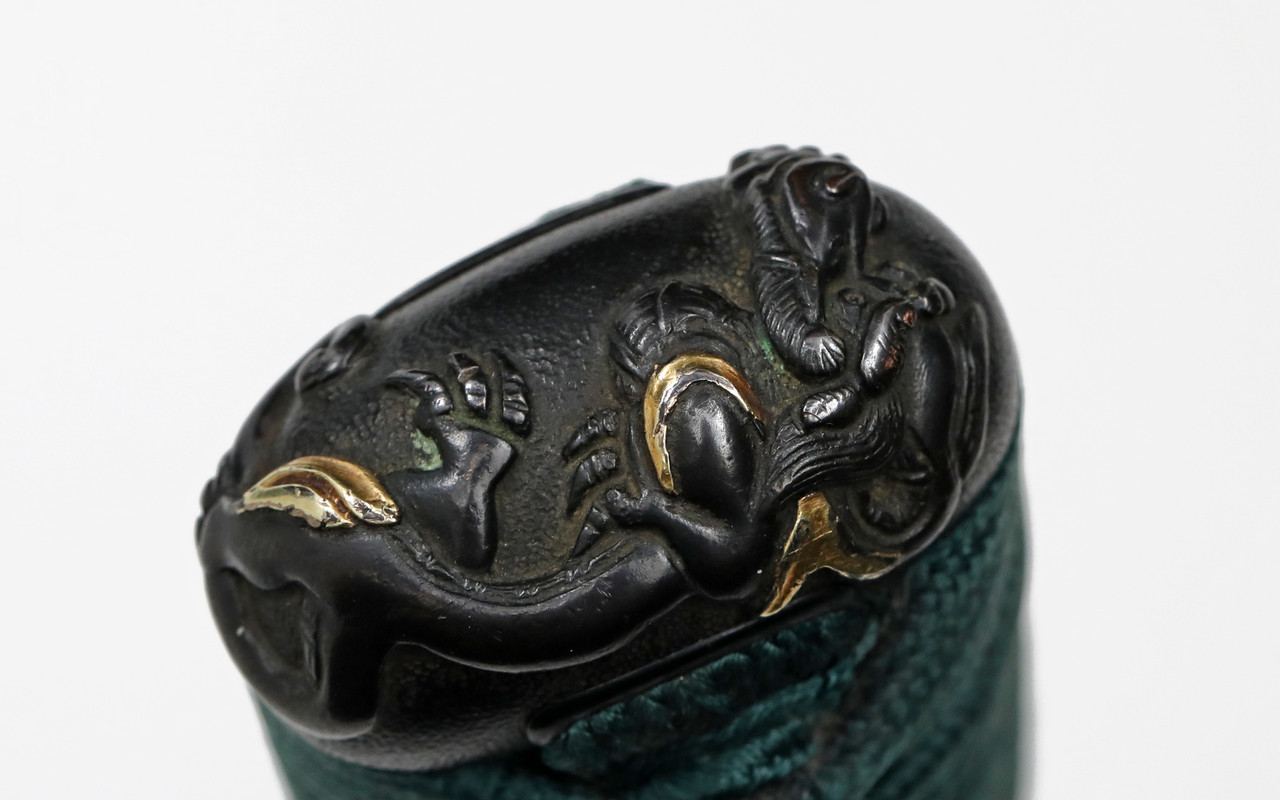 | 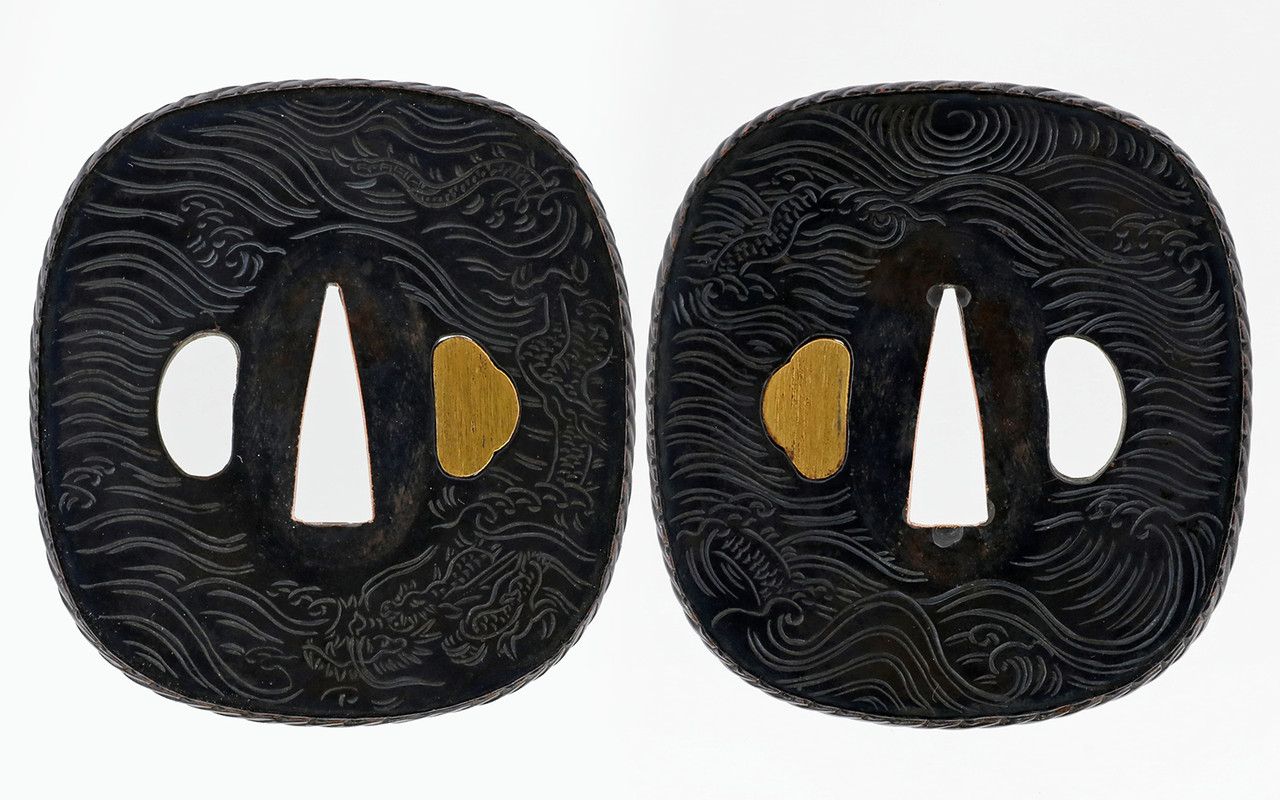 |
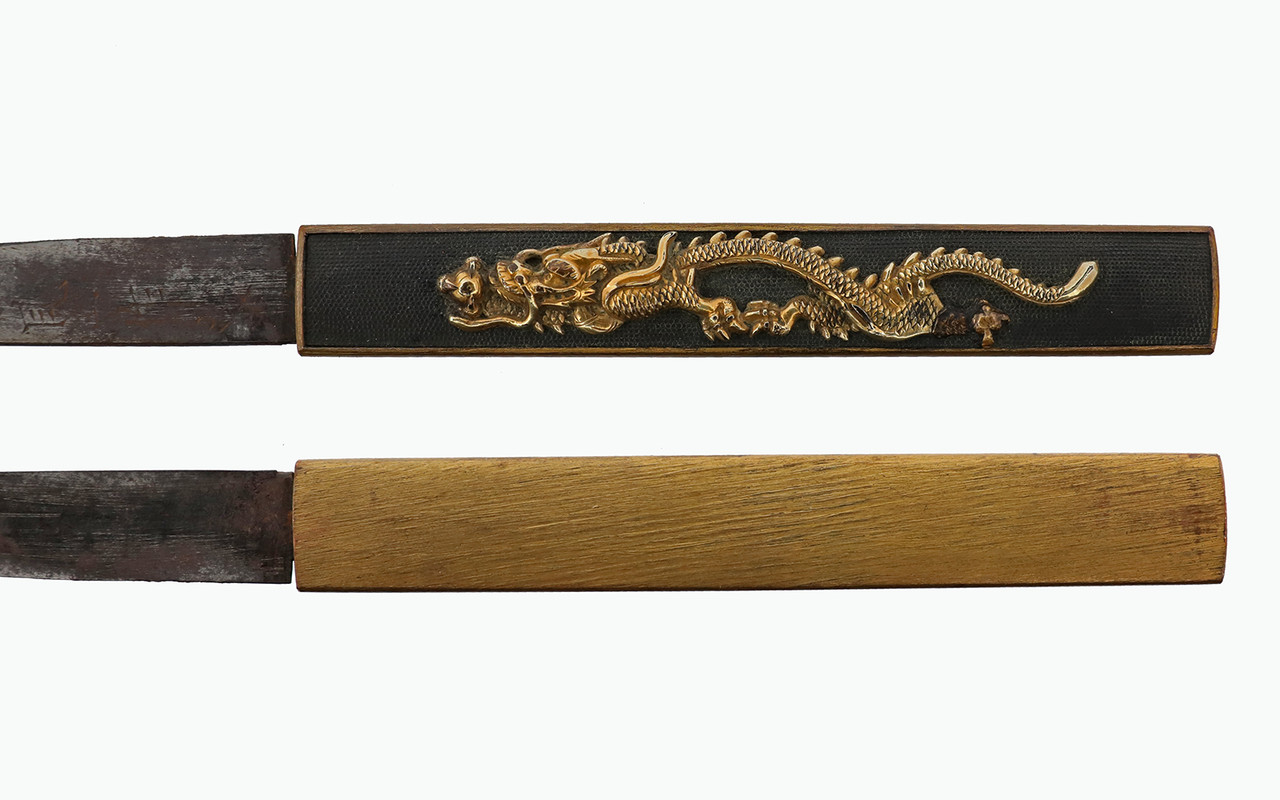 |  |
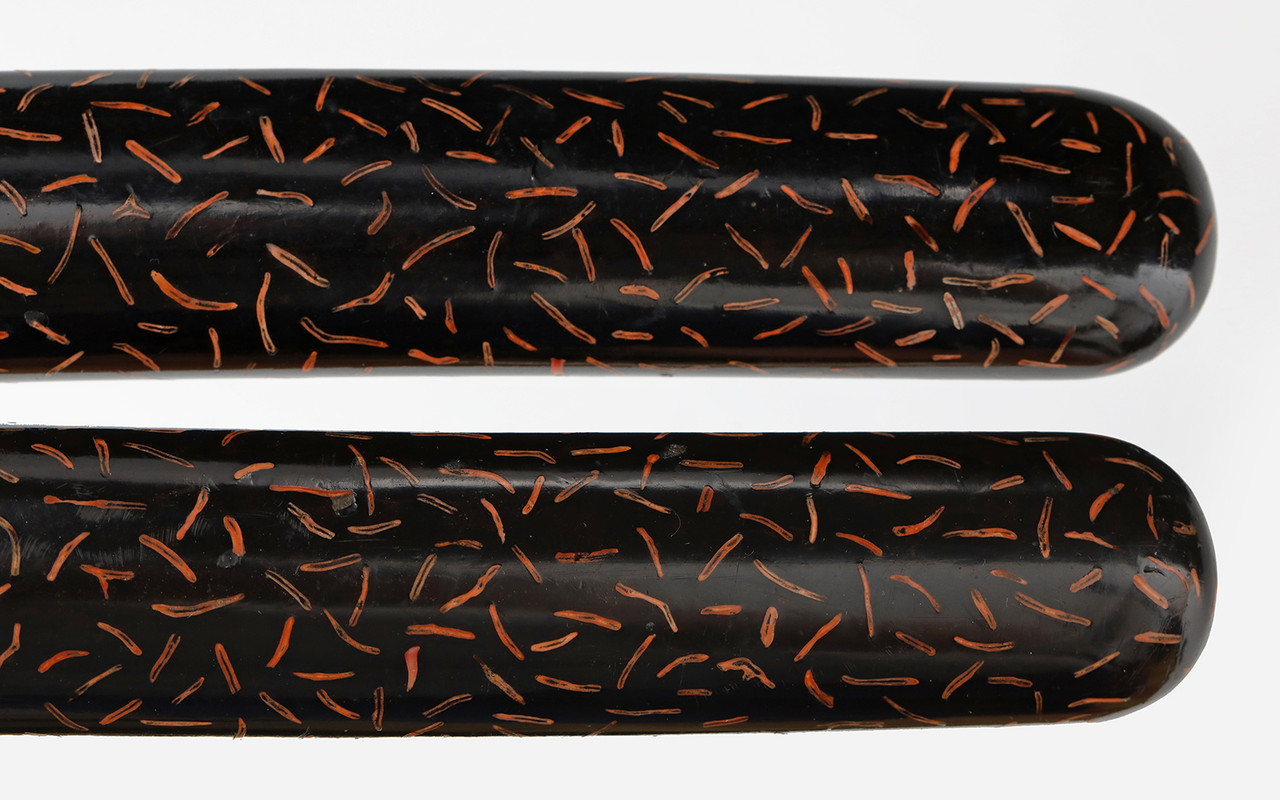 | |
Sekishū Izuha Sadatsuna Katana. Sekishū Sadatsuna is the youngest son of the 1st generation Naotsuna, whom was one of the Juttetsu of Masamune or the "Great 10 Students." Naotsuna was from Iwami province and, like many others, came to study under the great Masamune to learn the Soshu techniques that Masamune perfected. Three generations of Naotsuna existed while the Shodai was one of the great ten students of Masamune. Similarly there also were multiple generations of Sadatsuna, with the first generation being the youngest son of the shodai Naotsuna and many pieces originally attributed to Sadatsuna are later discovered to be in actuality the work of the shodai Naotsuna. This blade is attributed to that first generation of Sadatsuna, the youngest son of the Juttetsu Naotsuna. O-suriage blade with distinct kamakura sugata and strong Soshu elements reminiscent of Masamune's work. This clearly is a remnant is his father's tutelage under the famous smith. Dated as an early work of Sekishū Izuha Sadatsuna dating to circa 1350 AD by the NBTHK. Both blade and tsuba of the beautiful mounts are papered.
 | |
 |  |
 |  |
 |  |
 | |
 |  |
 | |
 |  |
 |  |
 |  |
Mutsu Aizu Unju Kanetomo Katana. This blade dates to the Shinshinto era and is in its original koshirae also dating to late Edo period. Both blade and koshirae are papered by the NTHK (blade is rated kanteisho and koshirae is rated shinteisho). Forged in 1861 just prior to the Boshin war signifying the sunset of the samurai. Kanetomo was a smith working in Mino province and he was the last of the Kanetomo line. Blade has a very tiny kirikomi (battle nick) on the ura side. Has no structural impairment and in fact demonstrates this blade was used in battle. Blade is ubu (not cut down) and mumei (unsigned).
 |  | 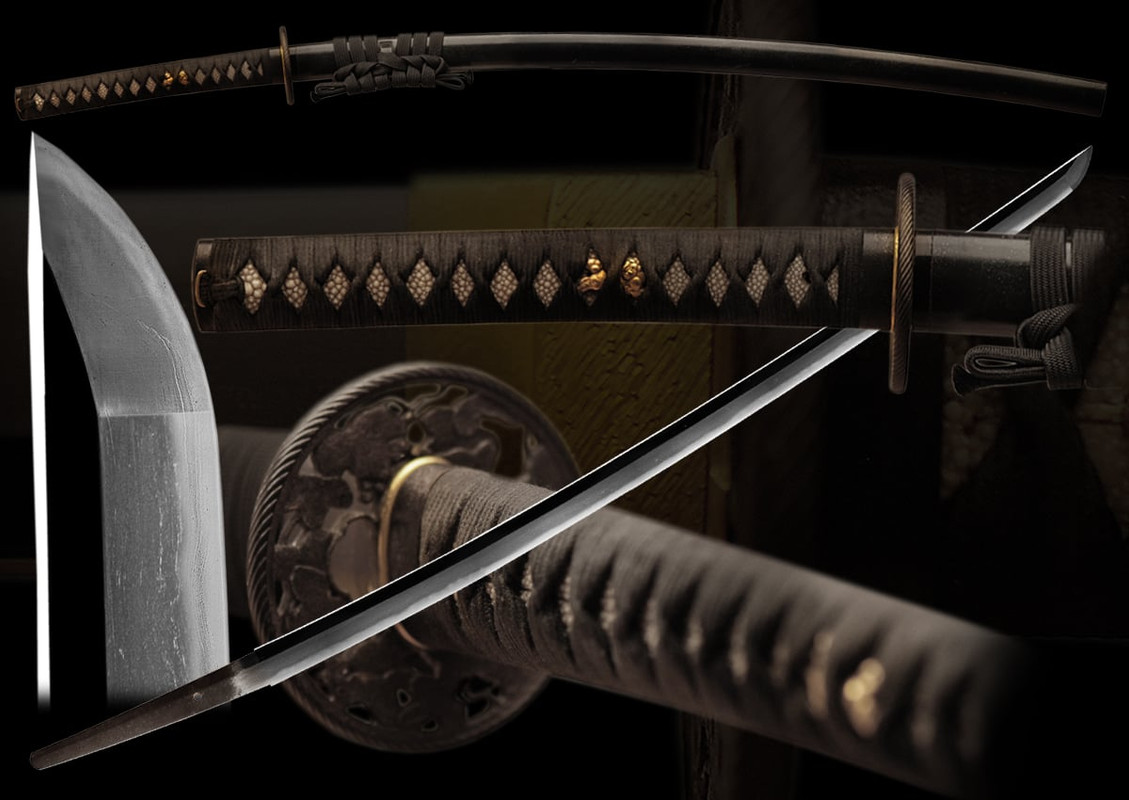 | 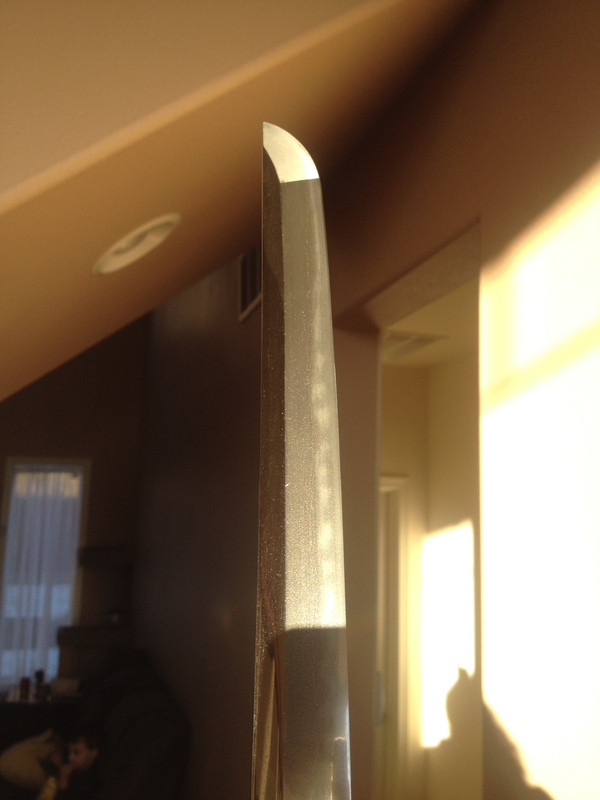 | |
 | 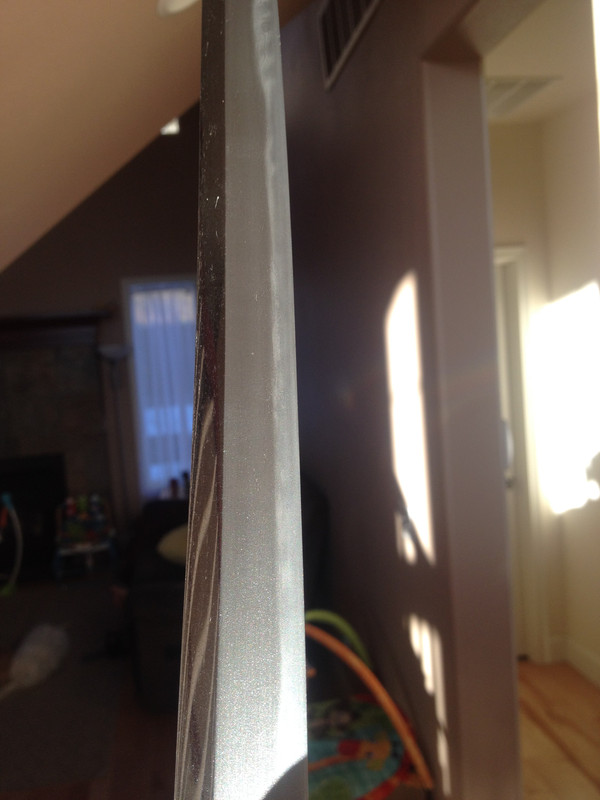 | 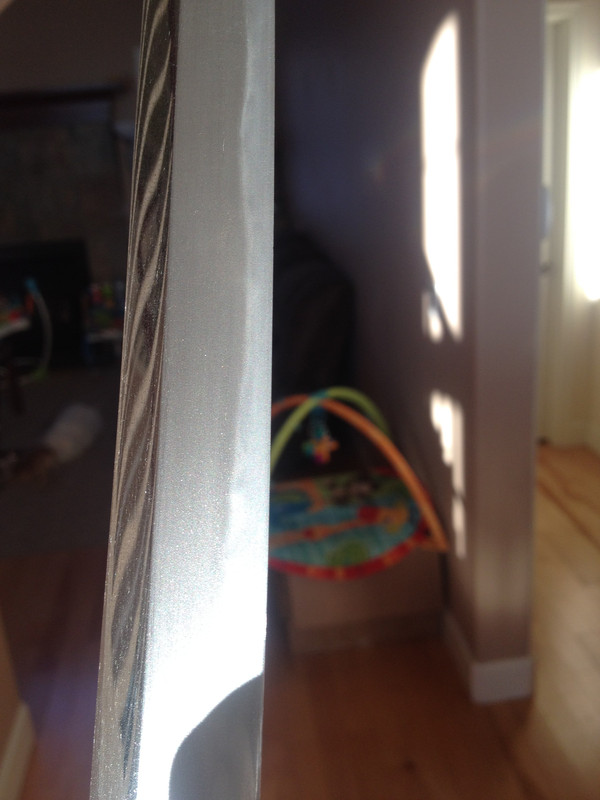 | ||
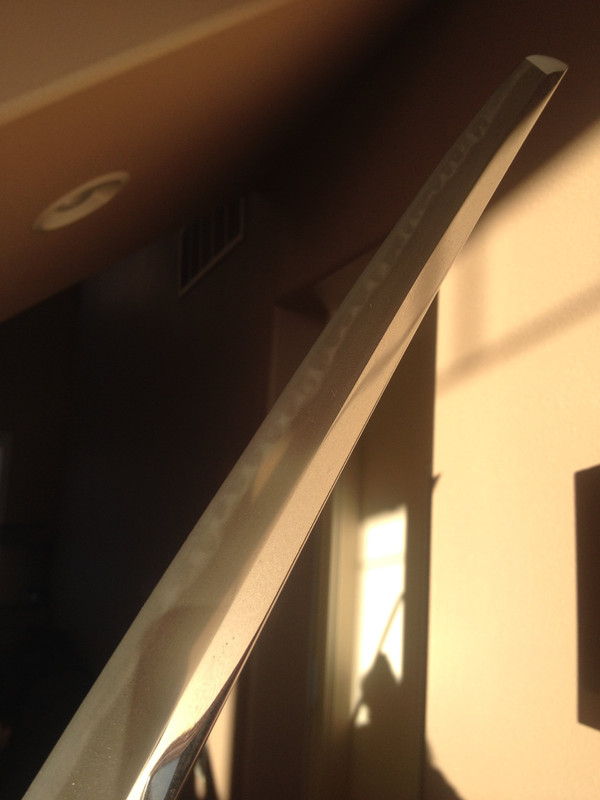 | 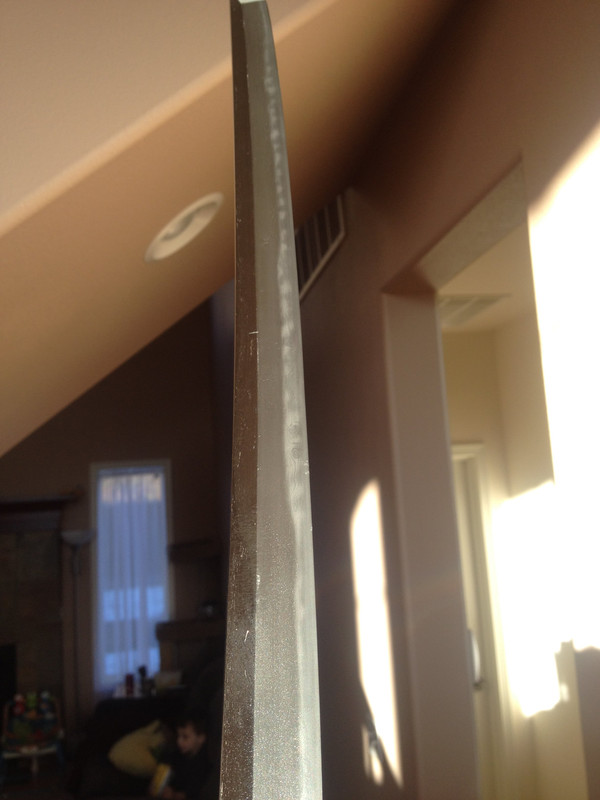 | 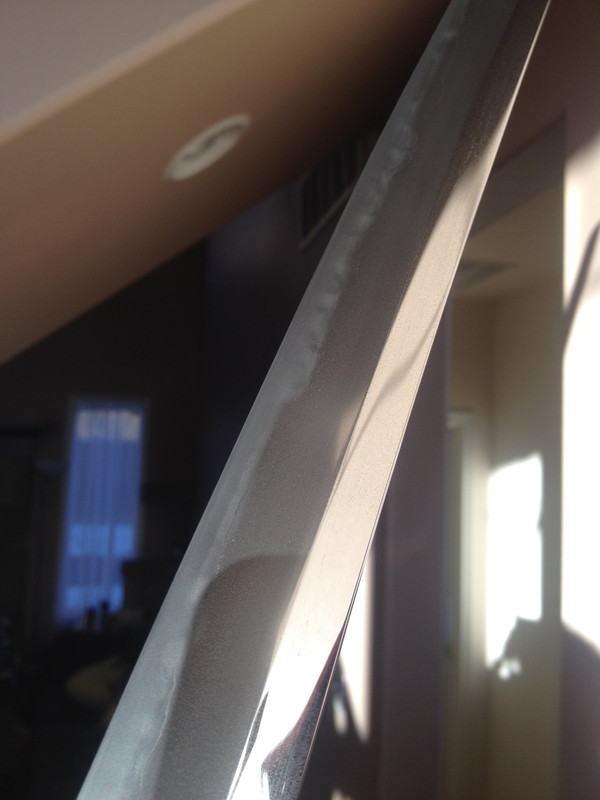 | ||
 | ||||
 | ||||
Mutsu no Kami Tameyasu Wakizashi. This is presumed to be Ishido school (specifically Kii Ishido). Approximately 350 years old. I think the big debate is whether the sayagaki (stating "Bichu no Kami Yasuhiro") is correct and this is by Yasuhiro or whether the sayagaki is incorrect. My current thinking (and Aoi Japan’s) is this blade is actually Yasuhiro's older brother Mutsu no Kami Tameyasu. 2nd generation Tameyasu shared traits with his brother but had the Ichimonji style hamon and flamboyance from his father's work. The father was one of the founders of the Kii Ishido school based in Osaka. The two brothers became key and notable early smiths from this school and their work is oft indistinguishable aside from Tameyasu’s tendency to have more flamboyant Ichimonji like activity in his blades’ hamon.
 |  | ||
 |  |  | |
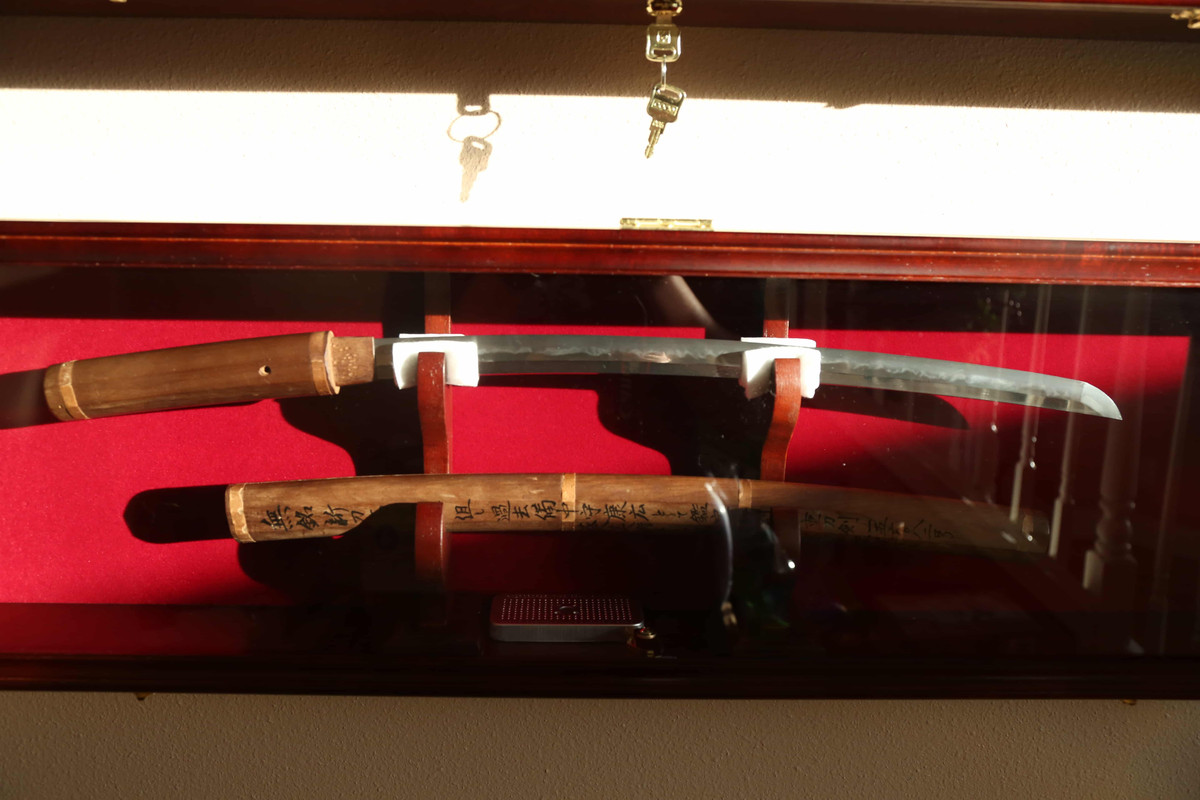 | 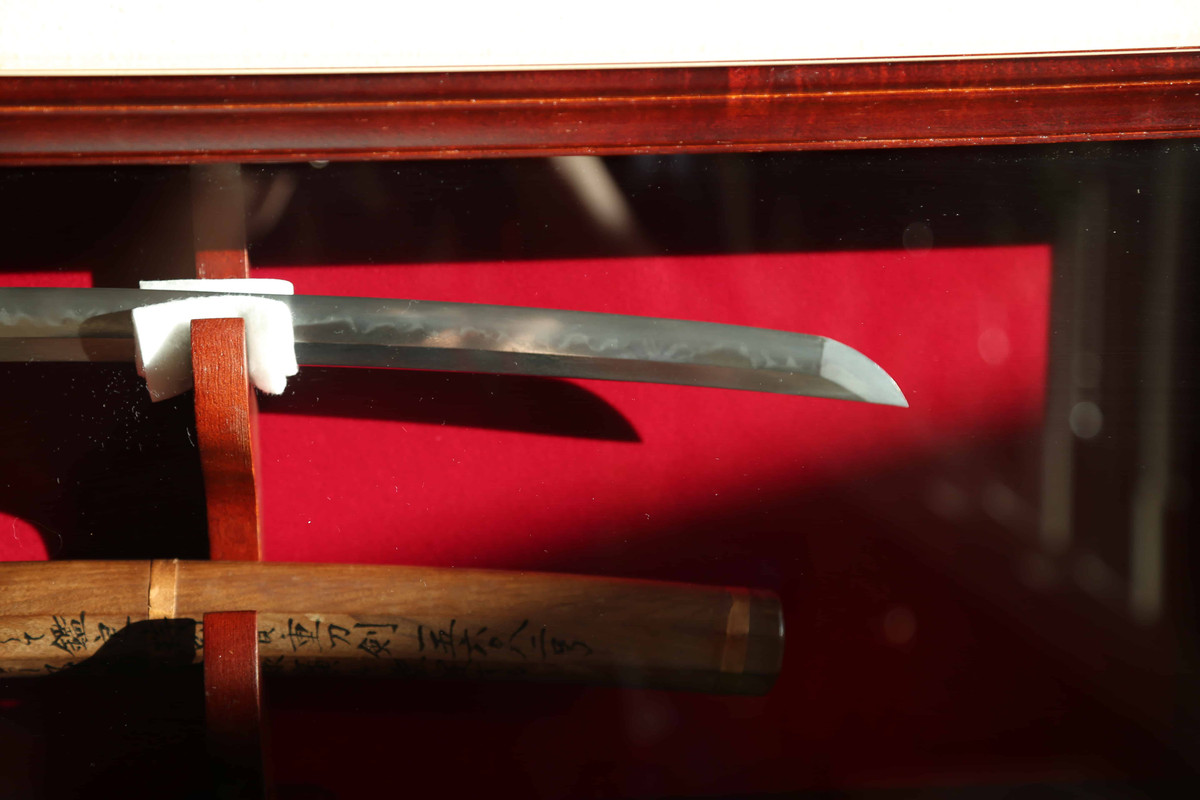 | 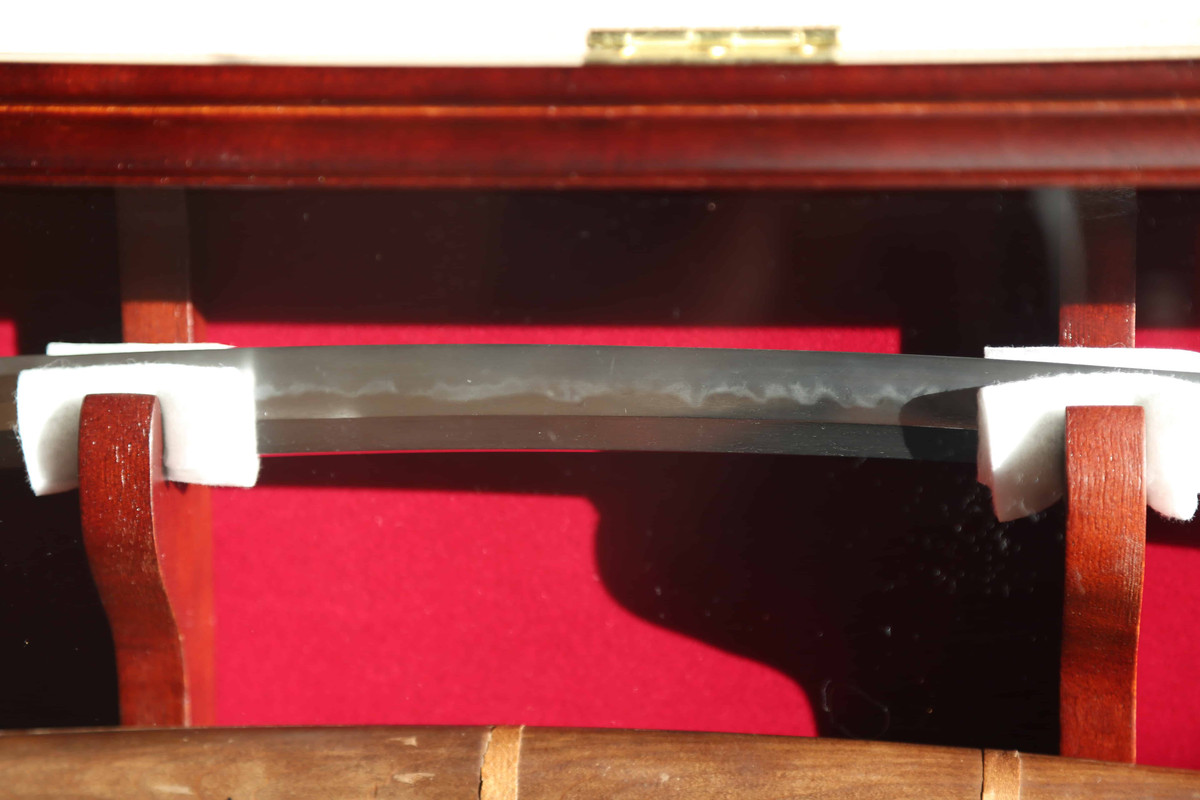 | |
Ko-Uda Wakizashi. Originally I had no idea as to what this was but suspected possibly Shinto Mino. Recently I took this blade in to Tatsuhiko Konno (a nearby friend who is also a longtime member of the NBTHK and one of the FEW certified NBTHK-sanctioned Togishi in the United States). He and another friend Stephen Colton (also a longtime member of the NBTHK and he does many lectures on nihonto) co-own a nearby Sword museum/gallery. Together they were able to provide me some shocking insights into this blade. It is older than Shinto. Much, much older. The blade is suspected to originate to EARLY KOTO and in fact the Nakago was misleading me due to the fact that IT was cut in during early Shinto. Presumably this was a much longer sword that broke and the blade was deemed valuable enough to convert into a wakizashi. This conversion occurred in early Shinto period but the blade steel and hada is Koto. Konno-san went so far as to surmise that this a Ko-Uda school piece.
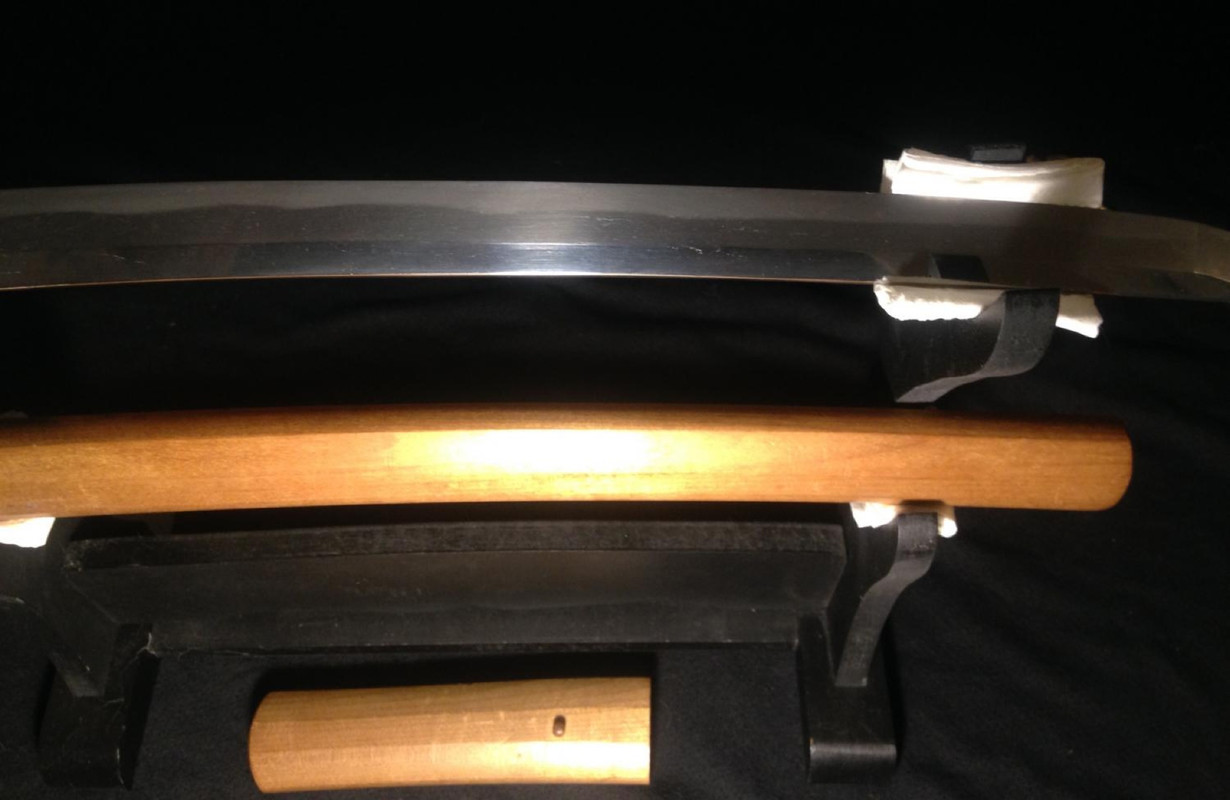 | ||
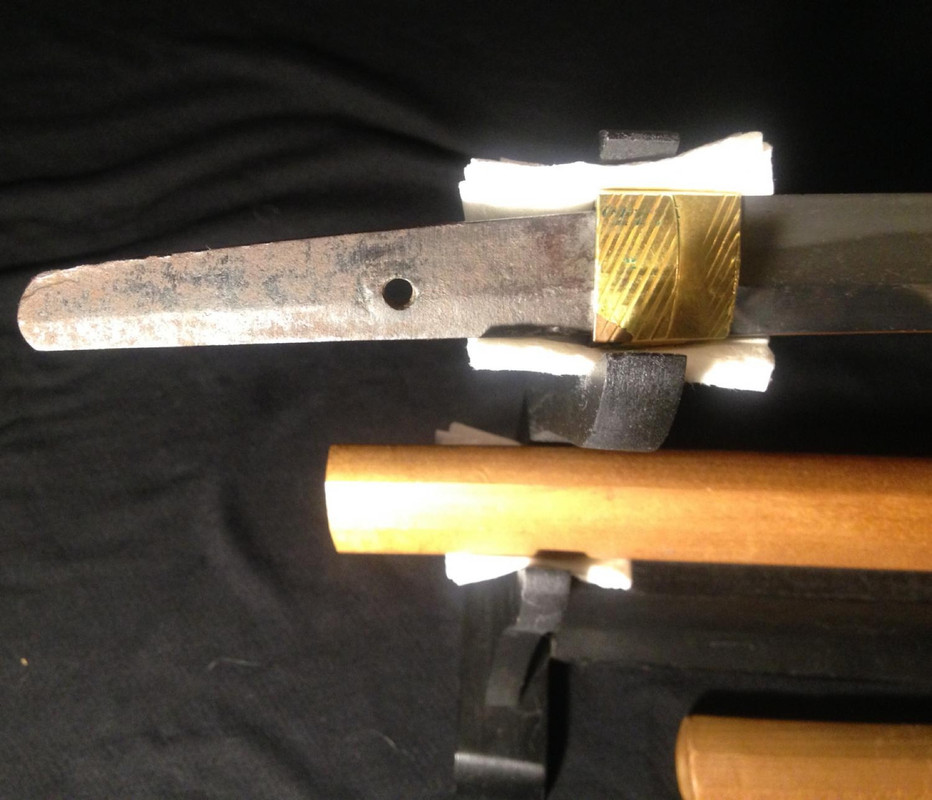 |  | 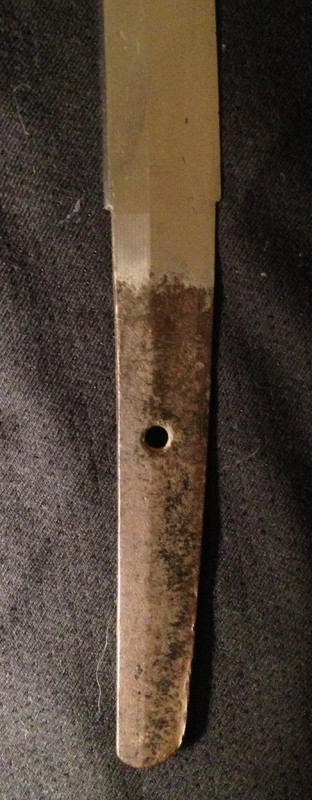 |
 | ||
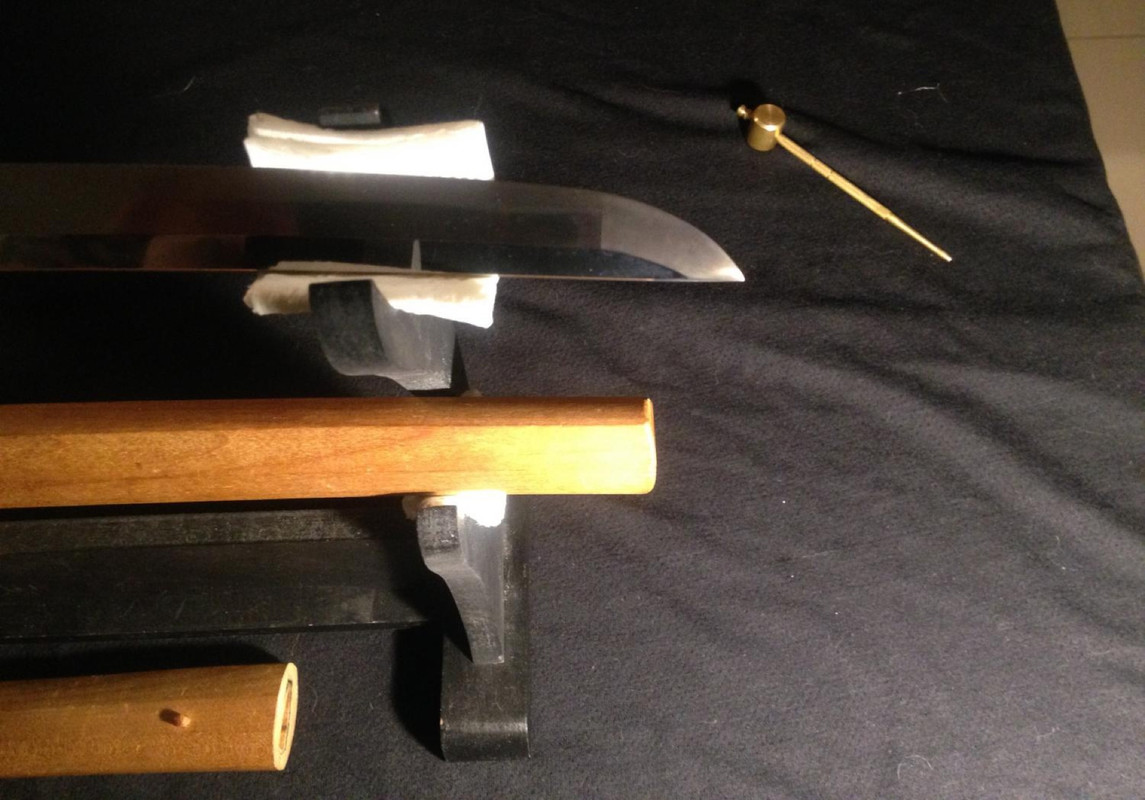 | ||
Kaga Ko-wakizashi. Length right on the border defining tanto/wakizashi. I believe given overall sugata this is a wakizashi (probably best called a ko-wakizashi). Approximately 300-400 years old. I am waiting to get this one polished (presuming it can be)at which point a shirasaya and habaki will be made for it. The blade has some significant pits on the ura side so it is unclear whether this blade can be brought back. The investment was small however and at worst it makes a good study piece and/or polishing project (which I would never do unless I can confirm a togi cannot resurrect it and it can never be papered).

Modern Swords
Valiant Armoury - Castile. Not much to say here as their site has all the info, other than this is the new(er) type XII profile and not the original type X profile. Personally, I like that this sword uses the type XII profile. I think that change was a good one. This one is peened vs the nut construction.

Valiant Armoury - Malatesta. Early version before they made the profile change in the blade. Hex nut construction. My "fastest" sword by far given the weight and balance. This is a fun fun cutter for light to medium targets and probably the one I would use if I wanted to overcome an opponent with sheer speed and agility in an unarmored dual.

Christian Fletcher - Winter Warden. I was the first to commission a complete kit for this, including it's specialized and dedicated scabbard. Incidentally his photos in his gallery are those of my exact sword.
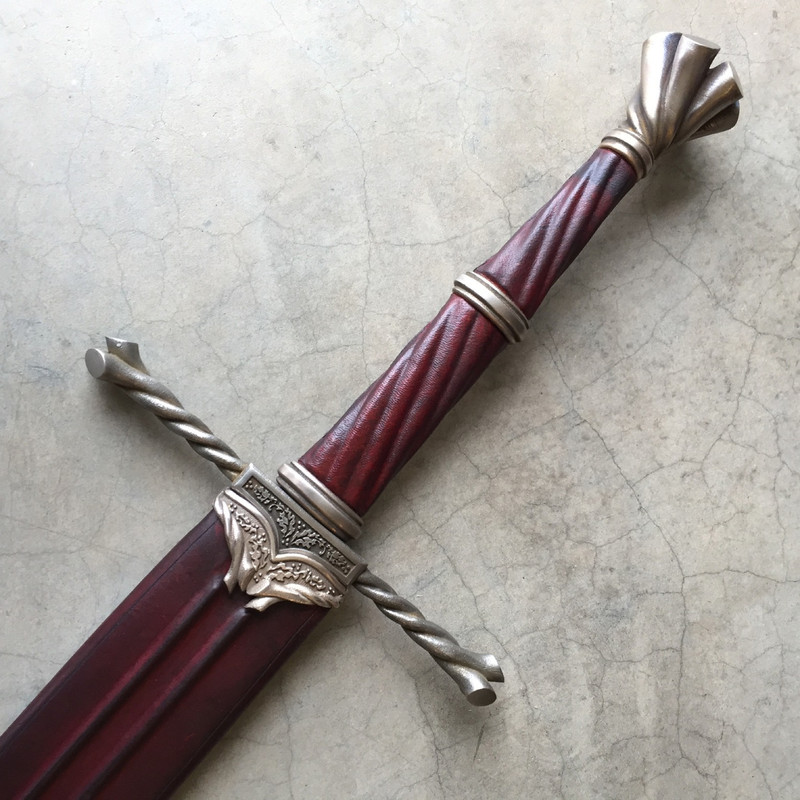 | 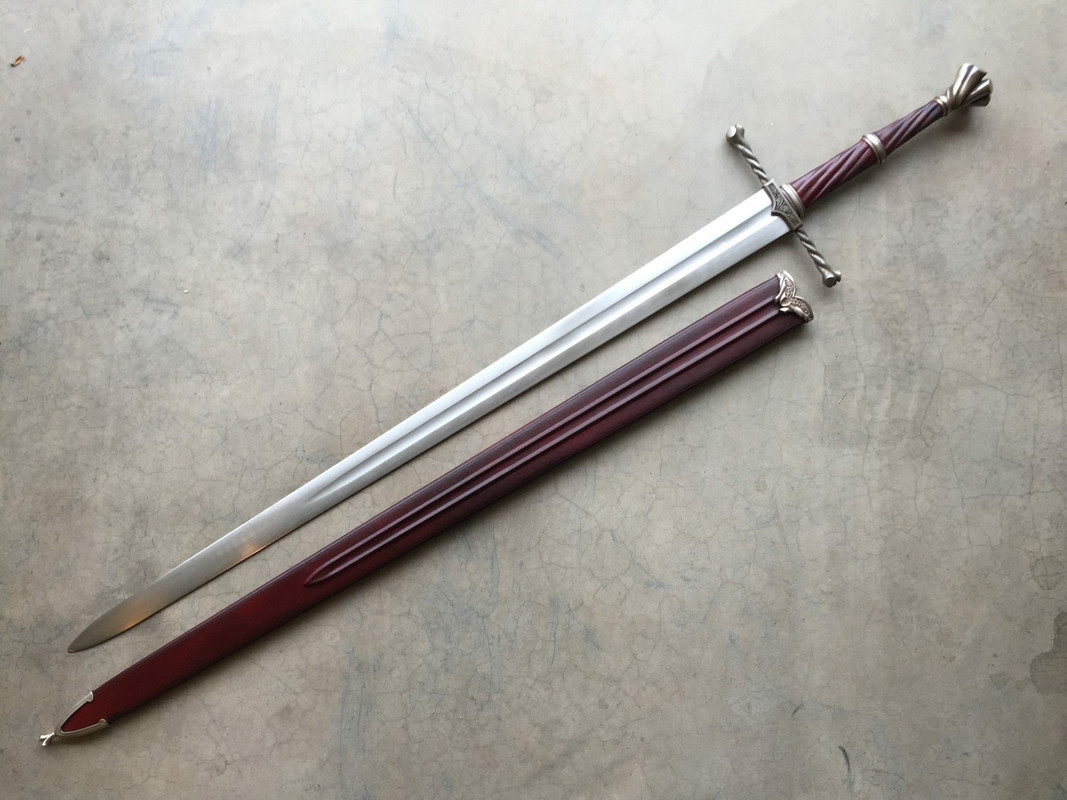 |
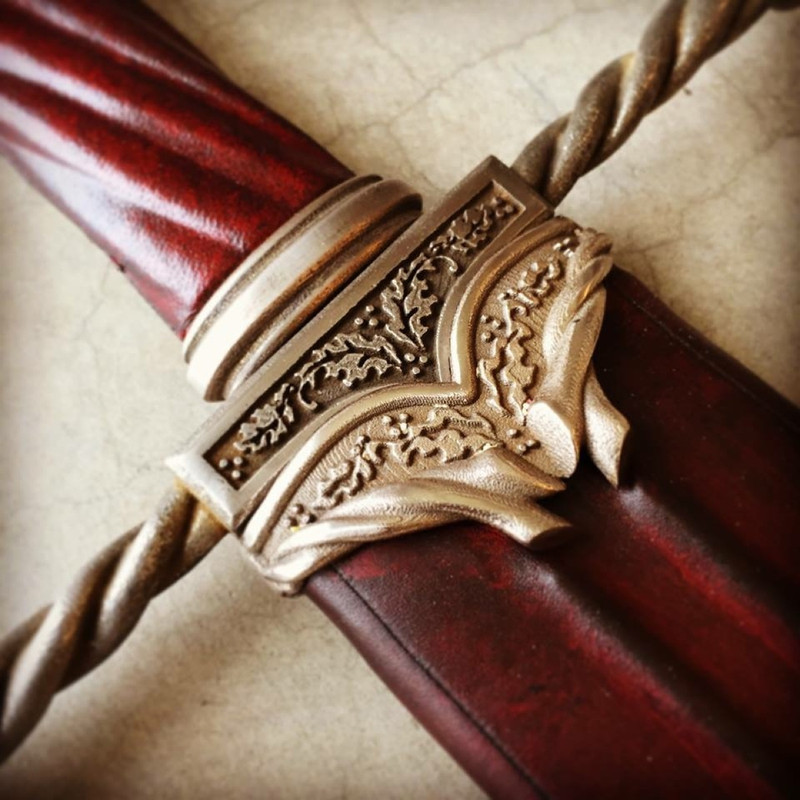 | 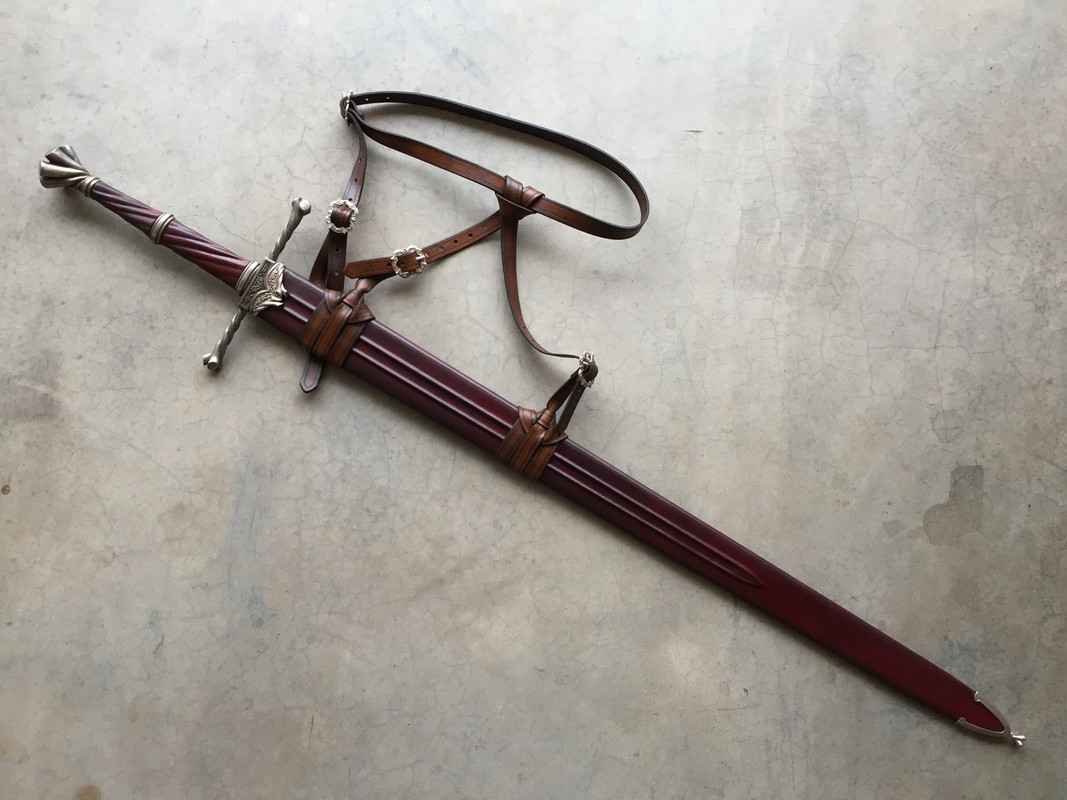 |
Angus Trim - Type XIIa.4 (dubbed "Blackwater") hilted by Tom Kinder with scabbard by Jonathan Sarge (Crusader Monk). I am like the 8-9th owner of this as far as I have been able to determine. This beauty has improved with each owner and now sports a Lonely Wolf Forge "god-cutting" edge. You can read my full review of this sword here.
 |  |  |  |
 | |||
Angus Trim - XVIa.3. Considered one of the best Angus Trim blades for the Fiore style. This blade is elegant, long and extremely agile. I personally have tended to favor the Type XIIa style previously but, while XIIa is still my favorite type, this XVIa is purely a delight to handle.

Angus Trim - XIIa.2. My third Atrim and I absolutely love it. It is not as authoritative as my XIIa.4 nor as agile as my XVIa.3, but it sits somewhere in between and makes a nice midpoint between the massive war sword and the agile Fiore-suited longsword. Grip and scabbard are custom work by Sonny Suttles at Valiant Armoury’s custom sword shoppe.
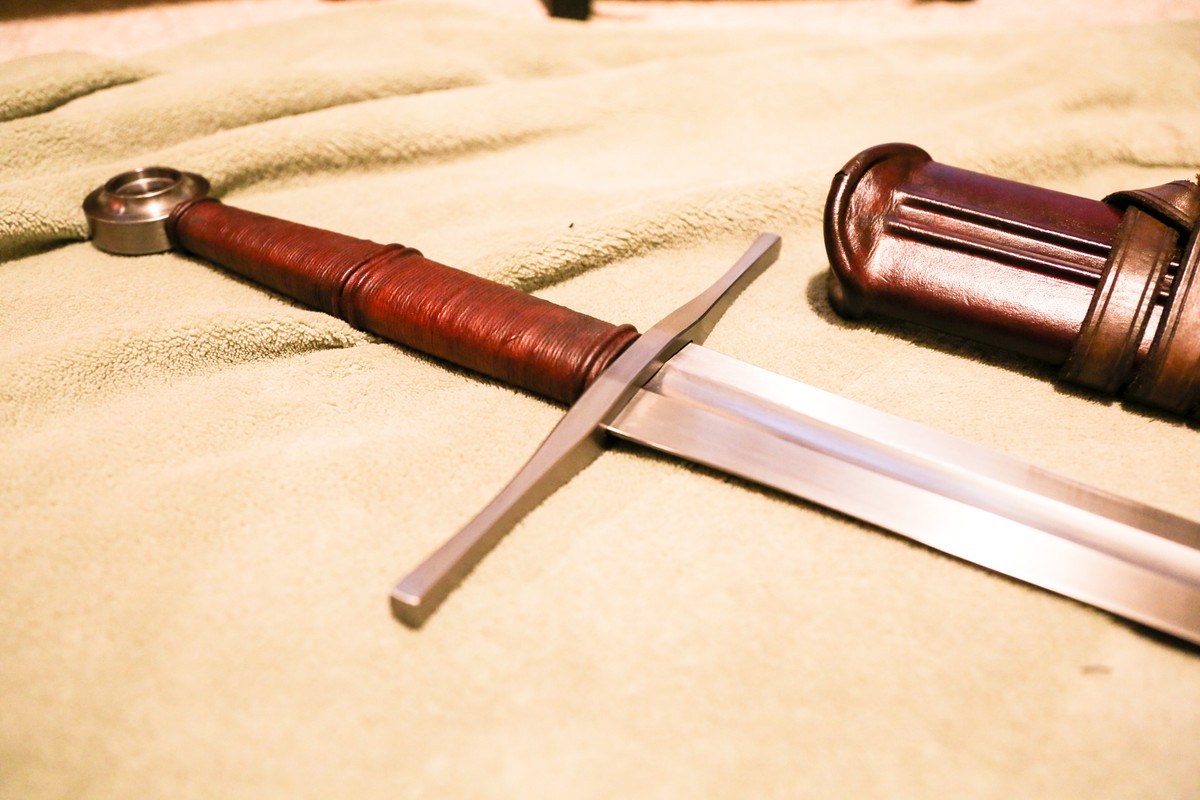 | 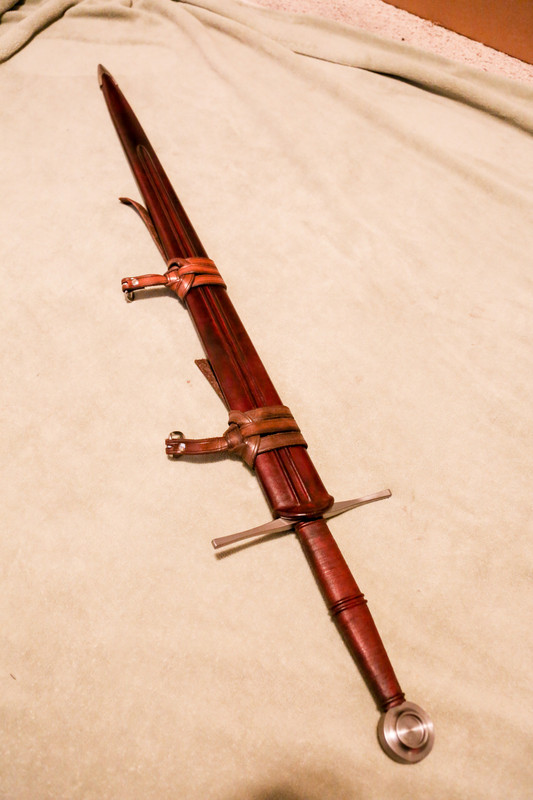 | 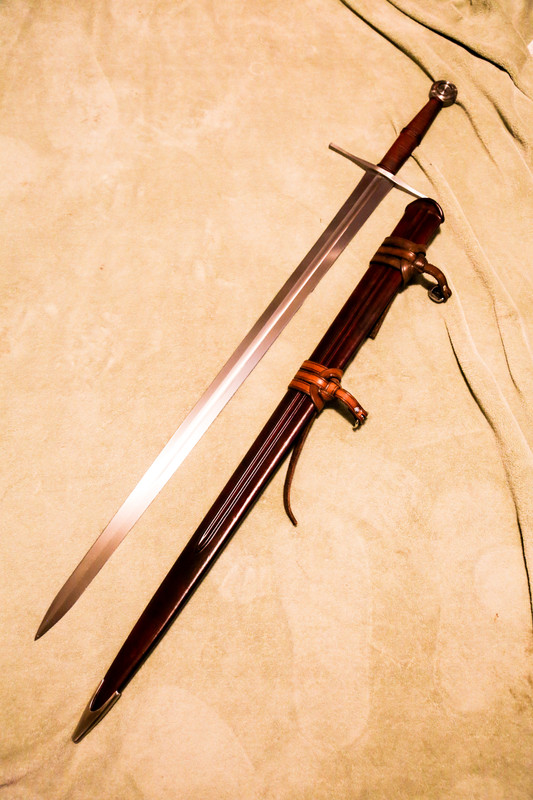 | |
 | 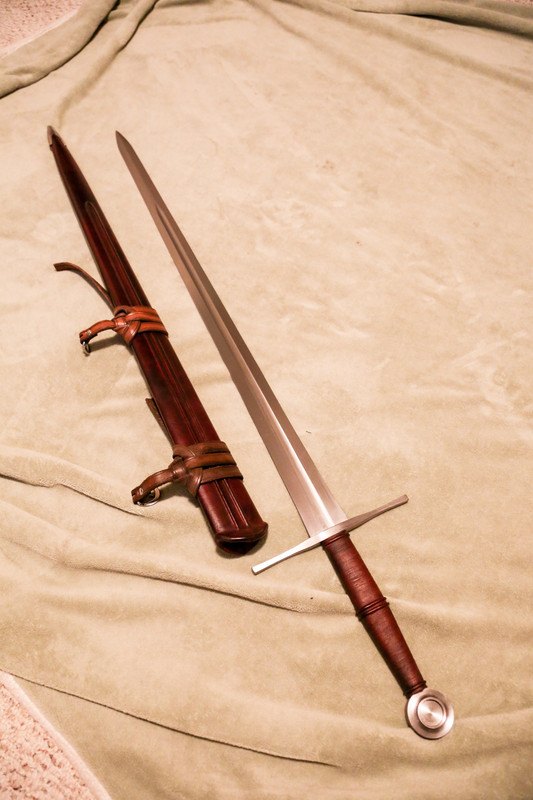 | 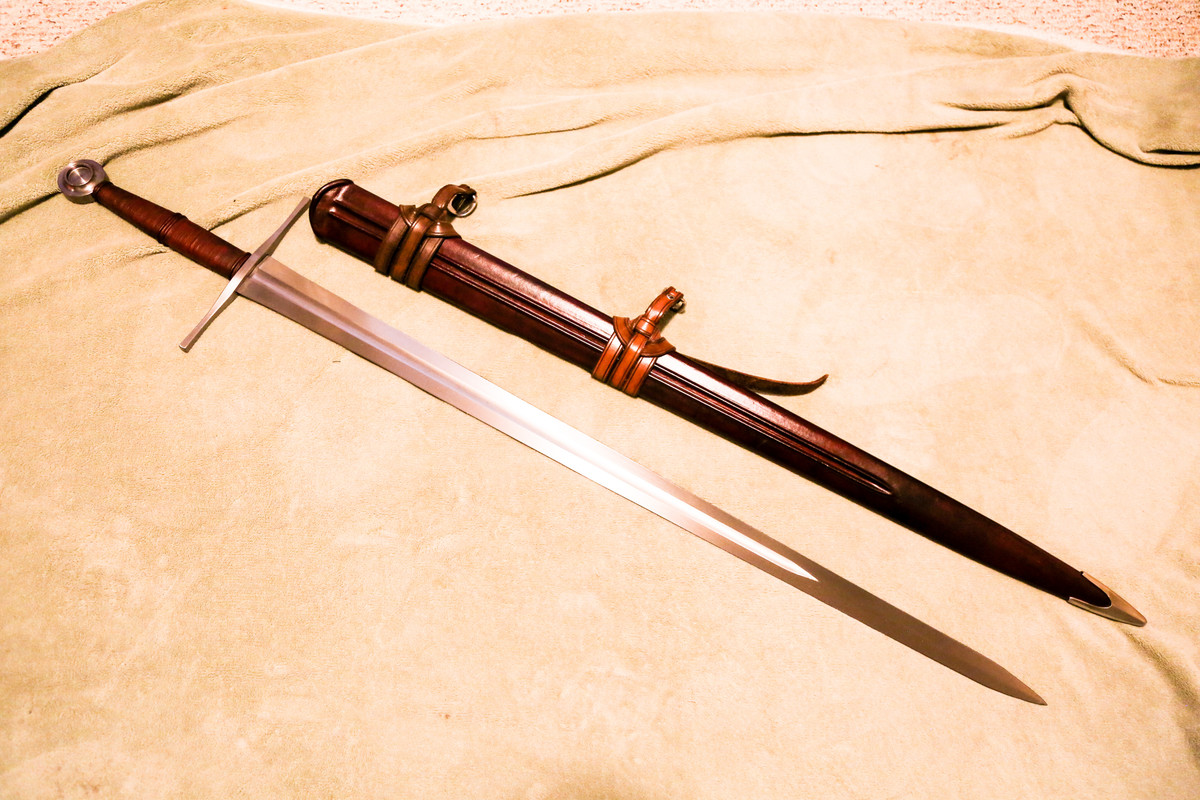 | |
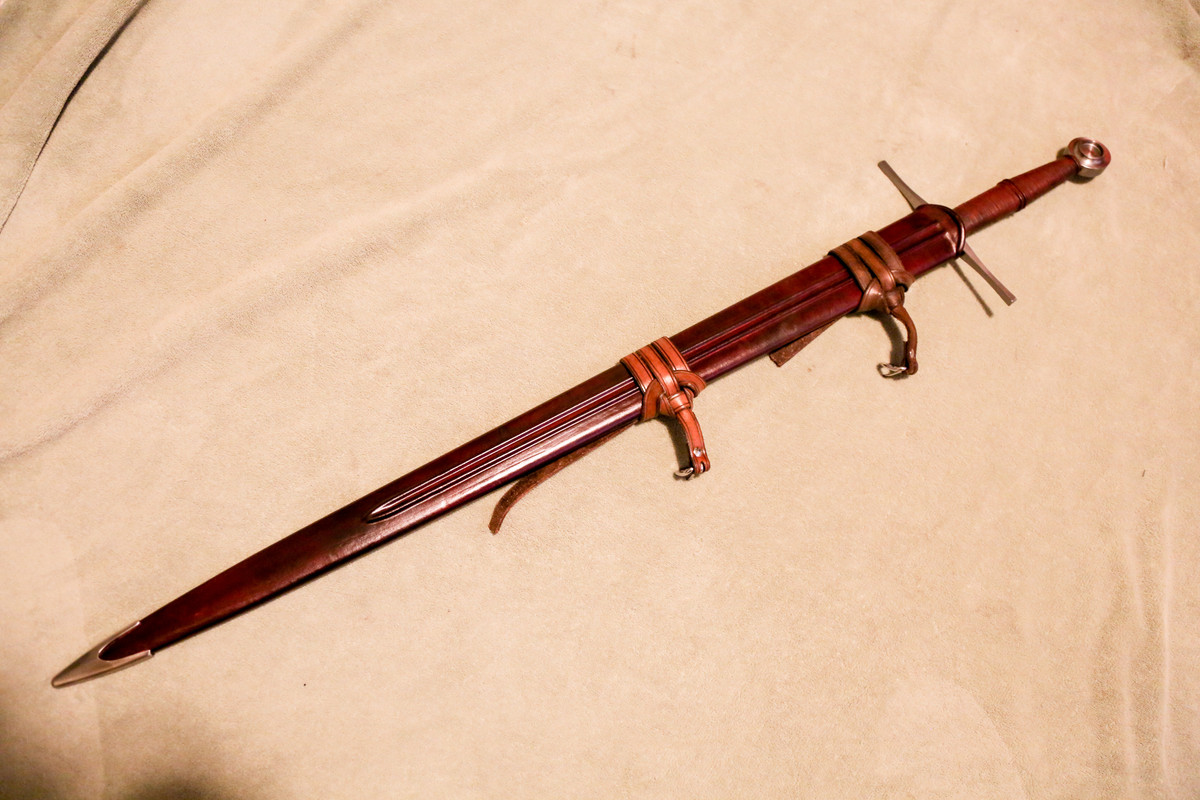 | 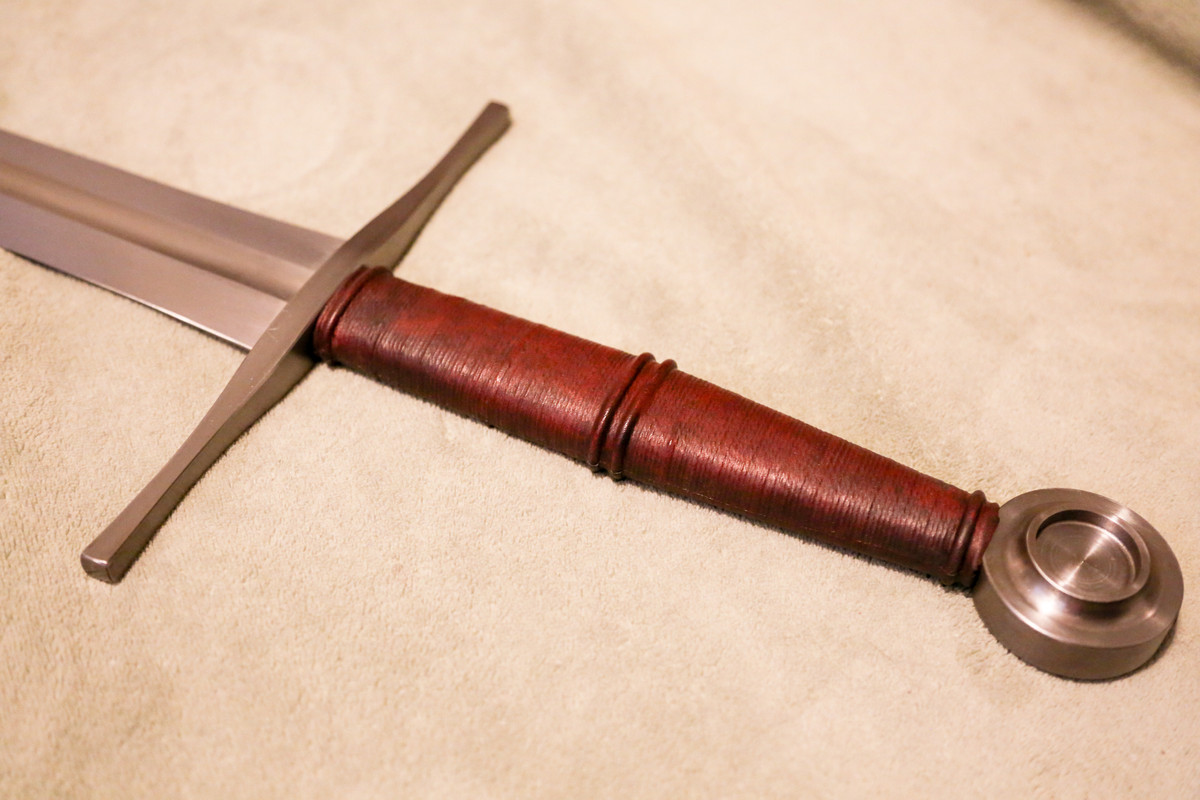 | ||
Christian Fletcher - Original Borderwatch built on an Angus Trim 1313 blade. One of Christian’s original Borderwatch swords built on an Angus Trim 1313 type XIIa blade. These predate the move to Albion as a blade supplier as well as the blade type change to the XVIa we know and love today. The beauty of this sword is the insanity that was collaborations between these two masters, with Christian’s hilts and Angus’ amazing performing blades. Fun fact: This sword is “famous”. This exact sword was photographed and appears on the cover of this book.
(Better pics coming later)
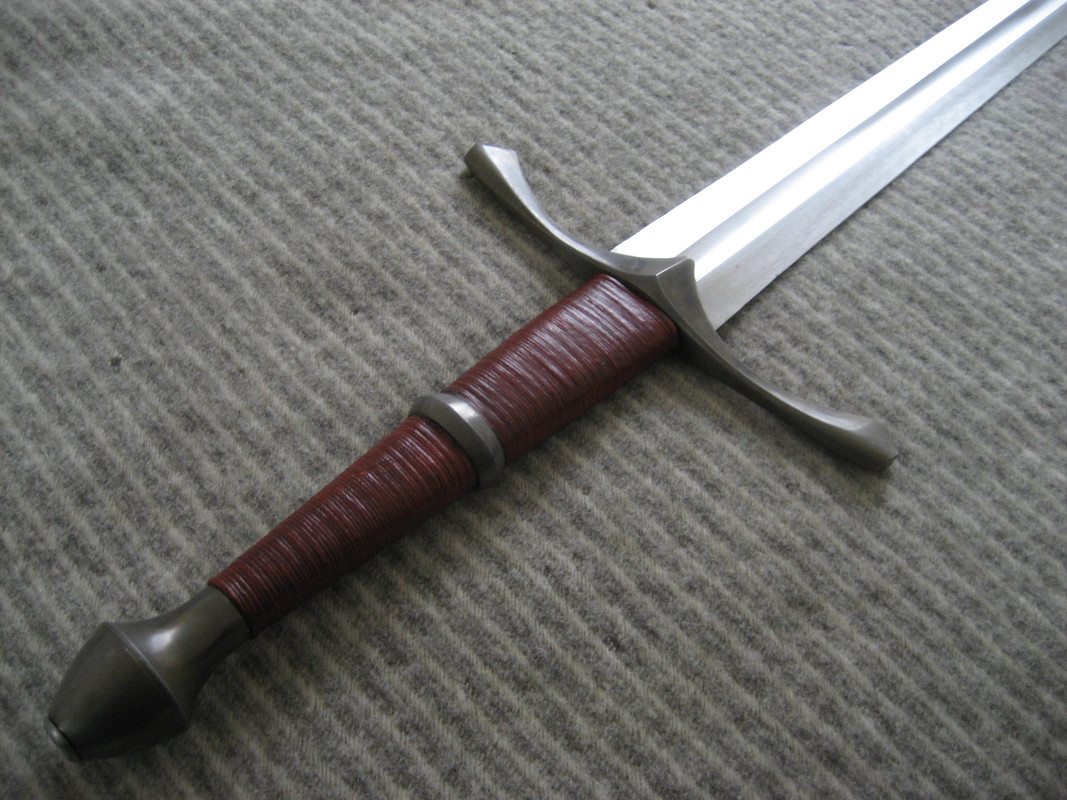 | 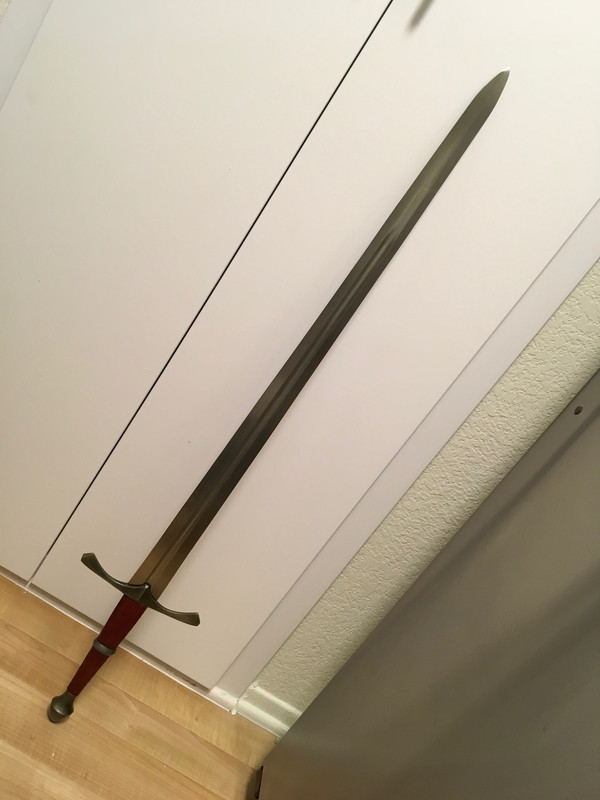 |
Tomas Diamante & Green Shield Workshop - Elven sword. Custom leaf-bladed bastard sword by Tomas Diamante with brass inlay fittings. This is my first piece by Tomas and it does not disappoint. Very quick and agile this sword absolutely has a Lord of the Rings feel to it. My full review of this sword is available here.
 | |
 |  |
 |  |
FableBlades - Blade of Evil's Bane. The first "Legend of Zelda" Master Sword made by Brendan. He and I co-designed this sword and iterated on specifications based on my own initial concept sketches. More info on FableBlades' site. Additionally, my full review of this sword is available here.
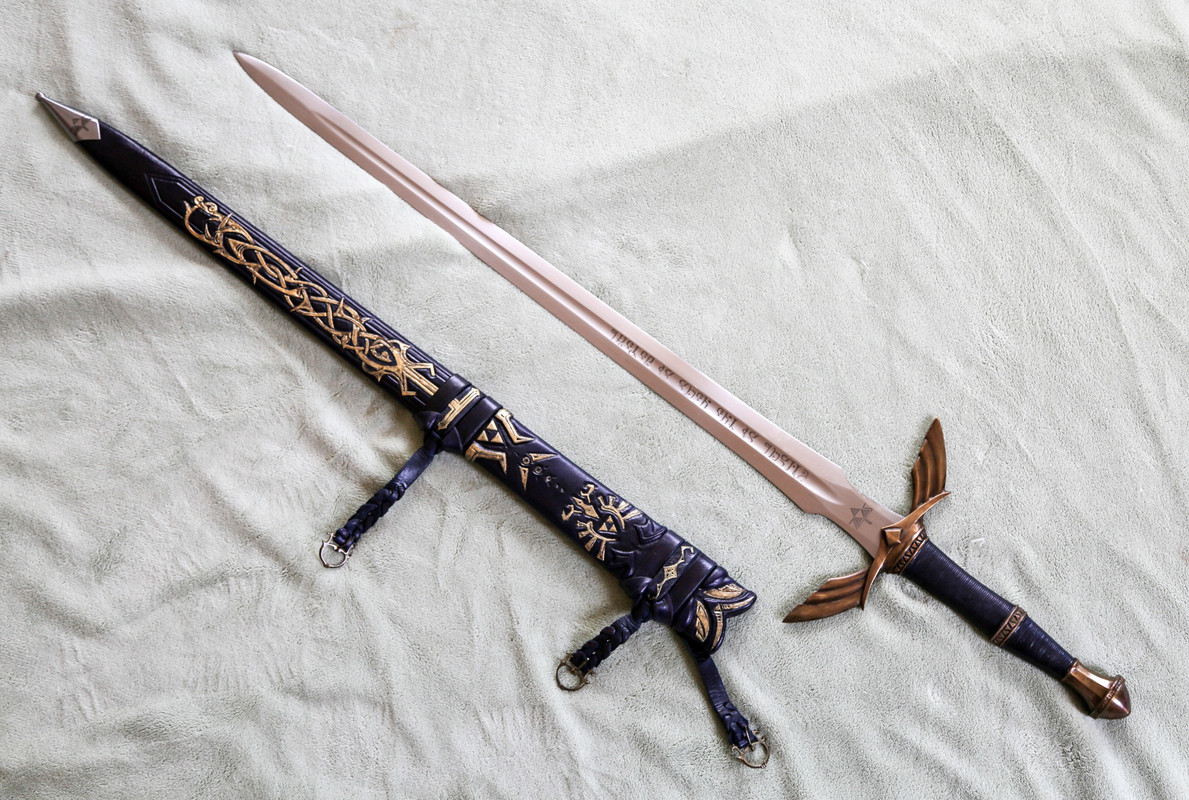 | |||
 |  |  | 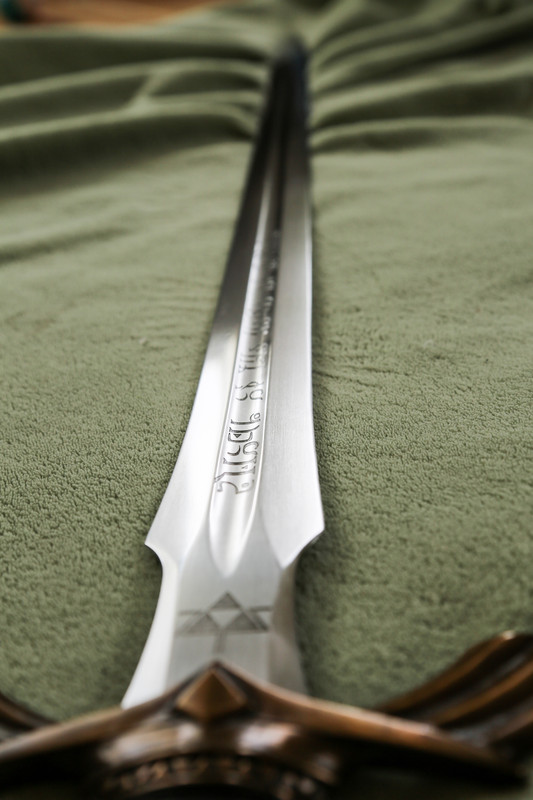 |
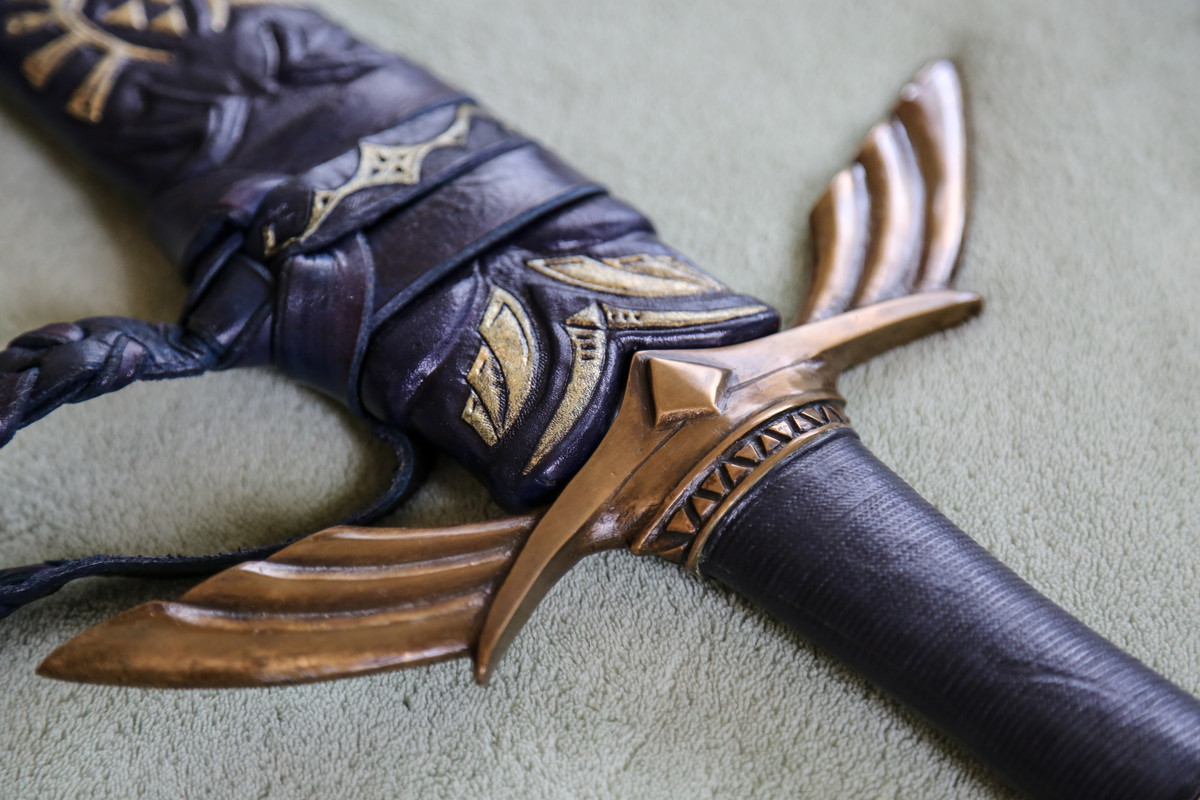 | |||
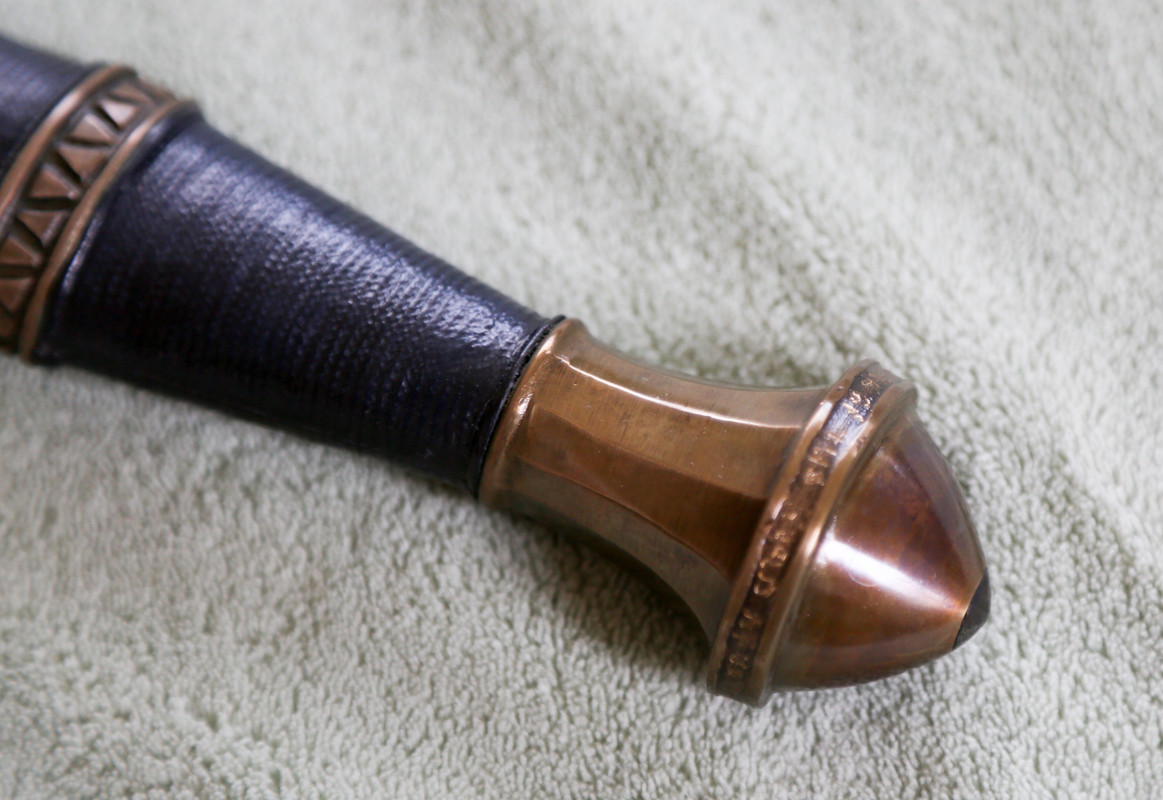 | 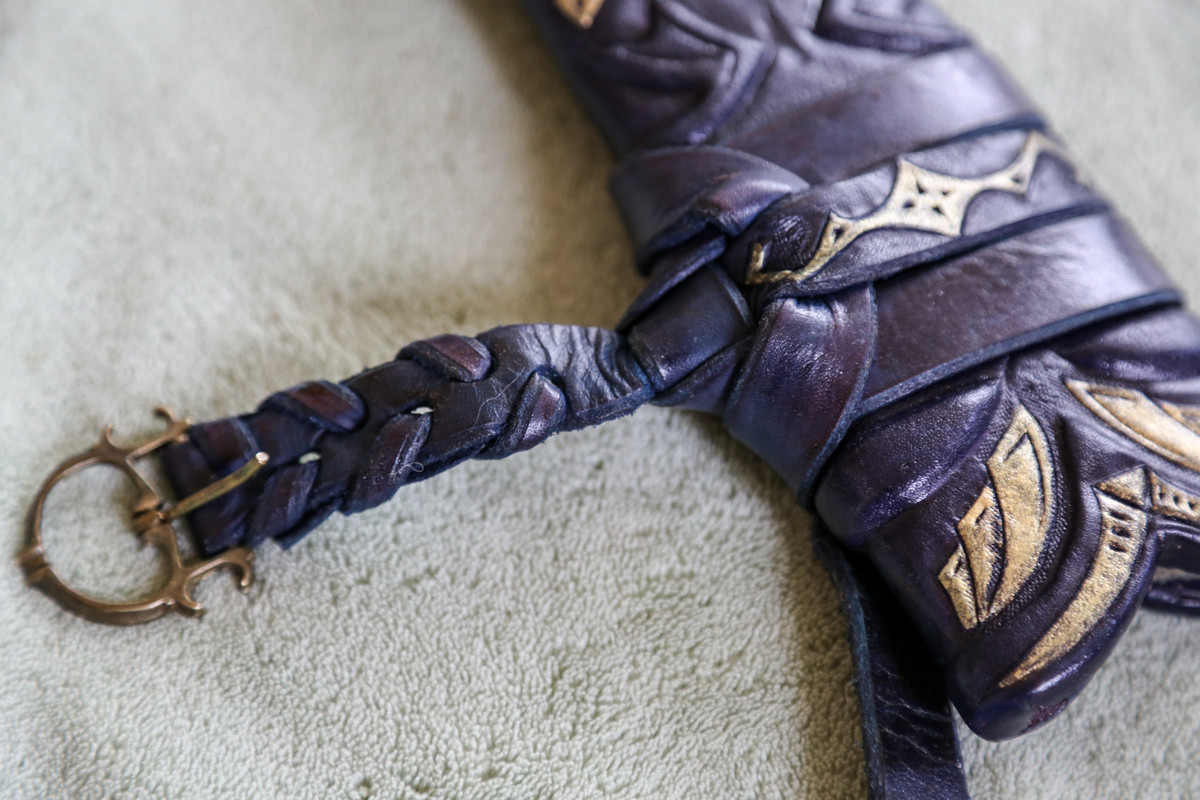 | ||
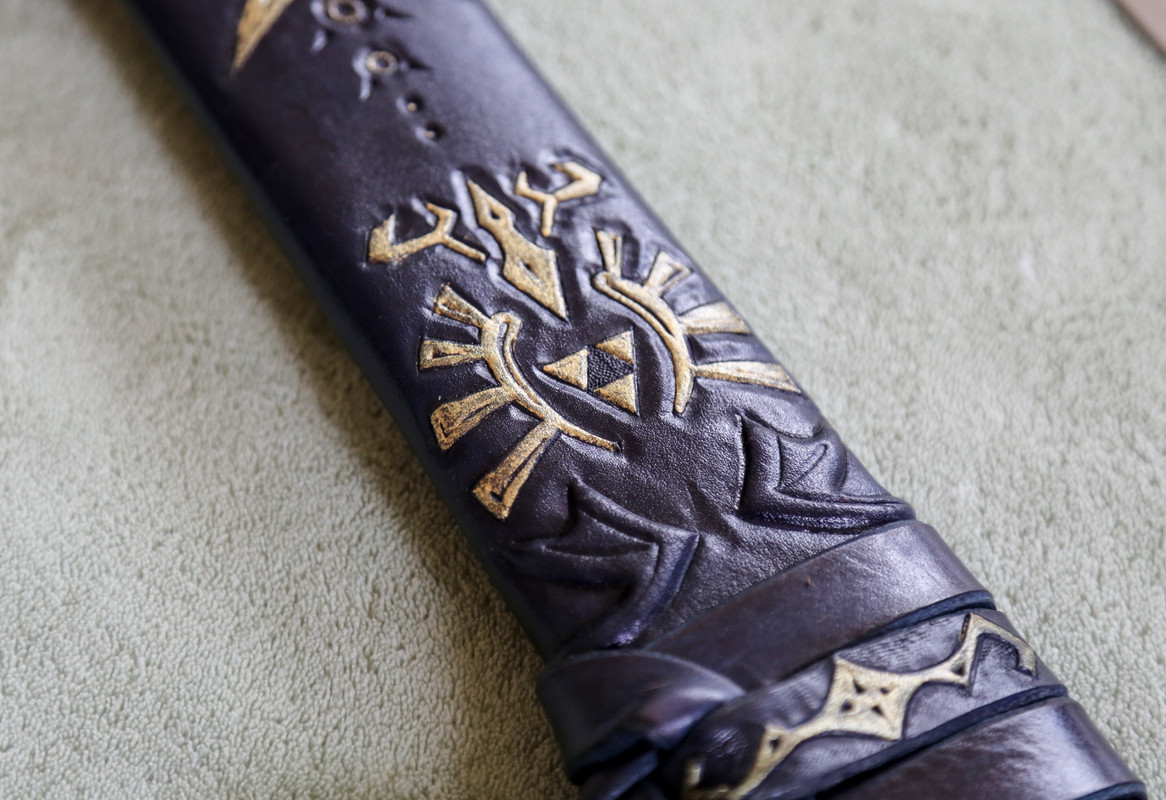 | 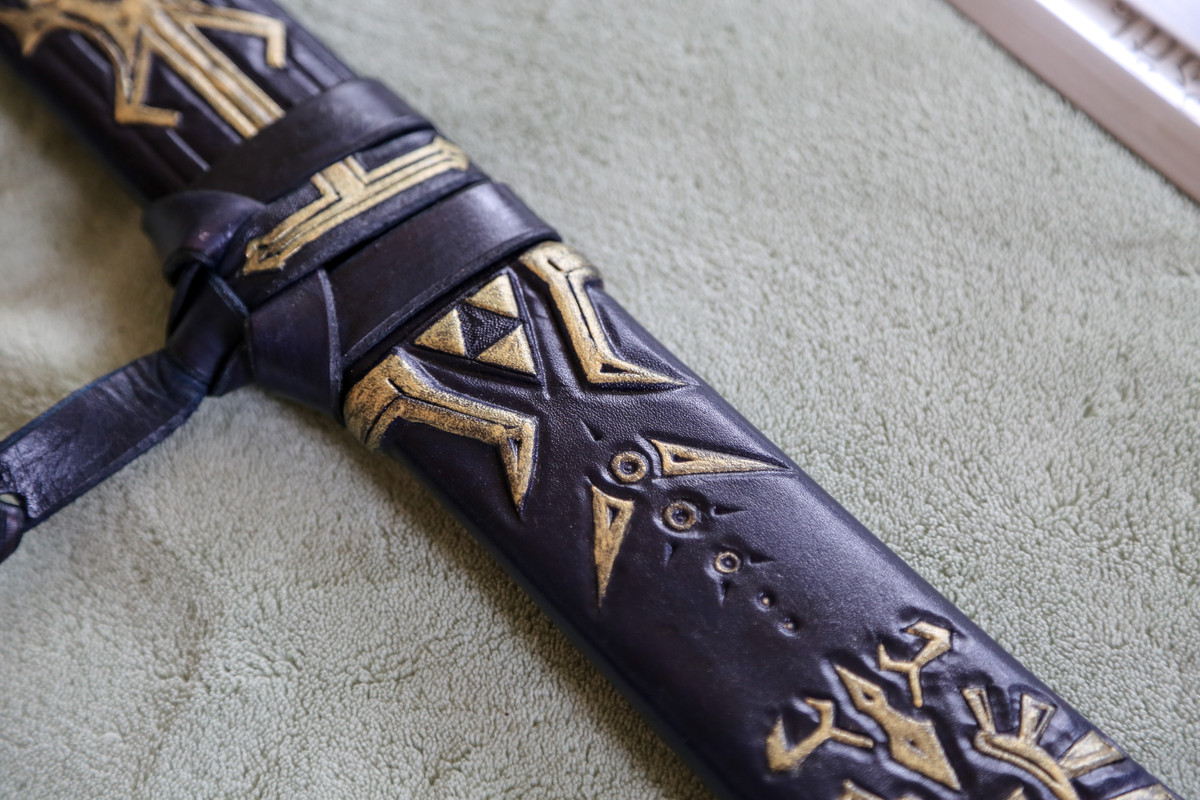 | ||
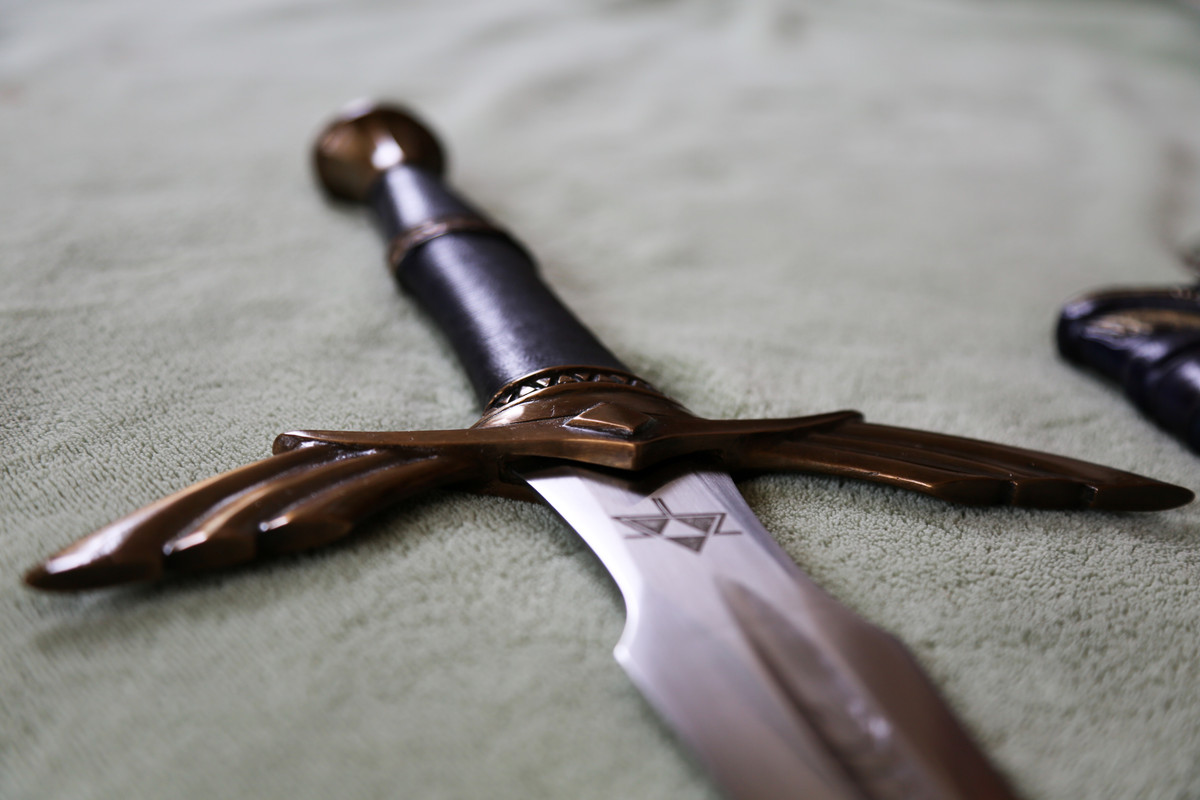 | 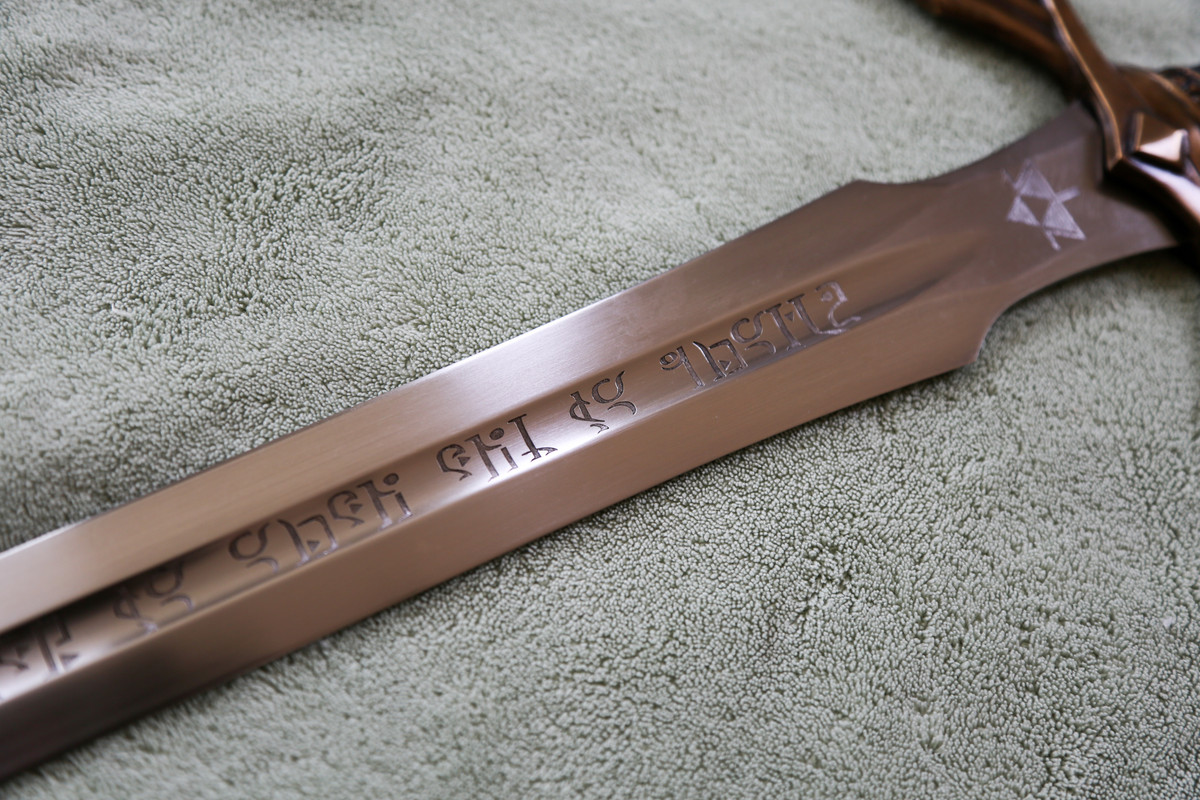 | ||
 |  | ||
FableBlades - Gladius Herois Aevi. The 2nd master sword made by Brendan. Upon its commission I got in touch with the owner and asked for first right of refusal if and when he ever sold it. When he did, I snatched it up. More info on FableBlades' site.
.jpg) | |
 | 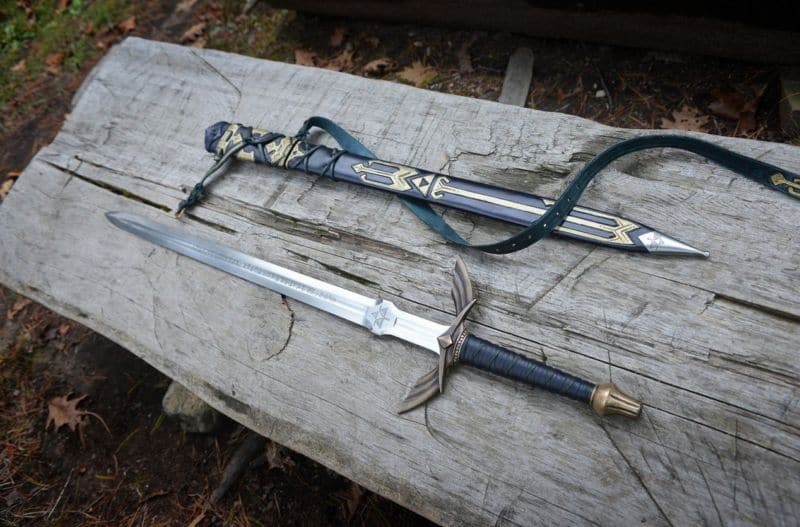 |
.jpg) | |
FableBlades - PeaceLily. The sword that made me notice Brendan's work to begin with. I recently was able to have a chance to acquire this fine blade and I jumped at it. I could not be more pleased. It handles like a dream and the fine details are amazing. I received it from its previous owner, polished her up some to clean off some tiny spots of rust and now she's looking once again pristine.
 |  | ||
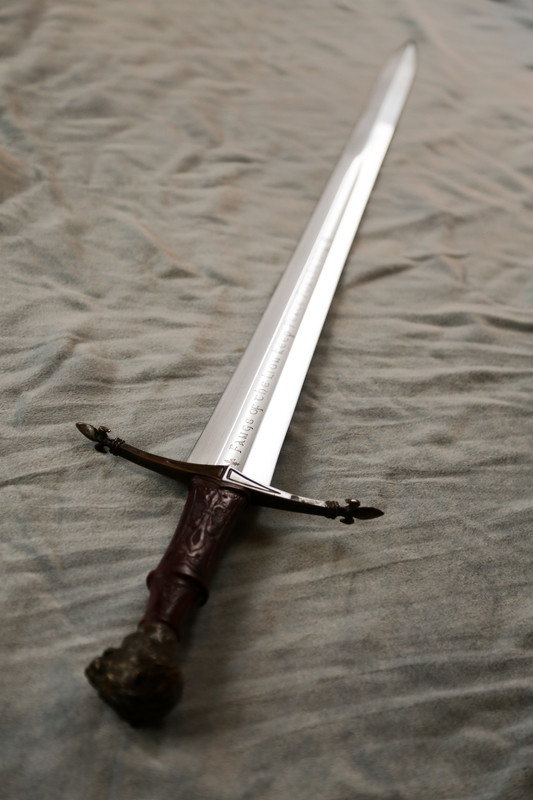 |  | ||
 | 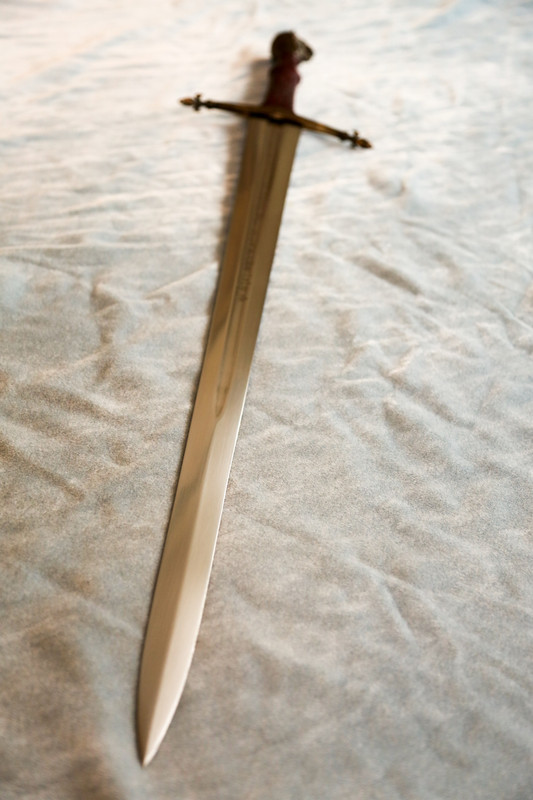 | 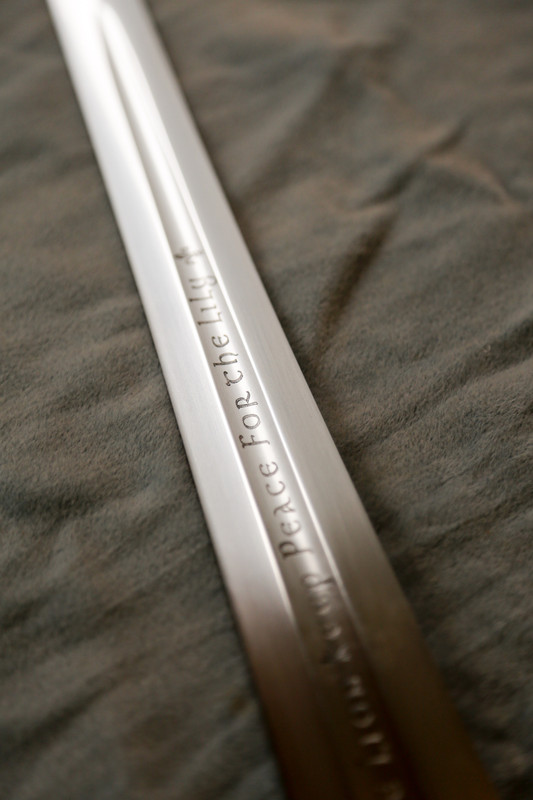 | |
FableBlades - Saber and Dirk of Dúathg'aul. These swords were originally commisioned by our SBG's own Shadowhowler (which is the translation of "Dúathg'aul"). More info on FableBlades' site and review by Shadowhowler here.

Windlass Steelcrafts - Knightly Hand & Half Sword. Old 90s era, purchased from MRL when I was younger. This sword will be the basis of a complete overhaul at some point to rehilt, build a scabbard. I am debating turning this into a Narsil (since I think it's probably better than a DSA one) and will likely be a revamp project in my future.
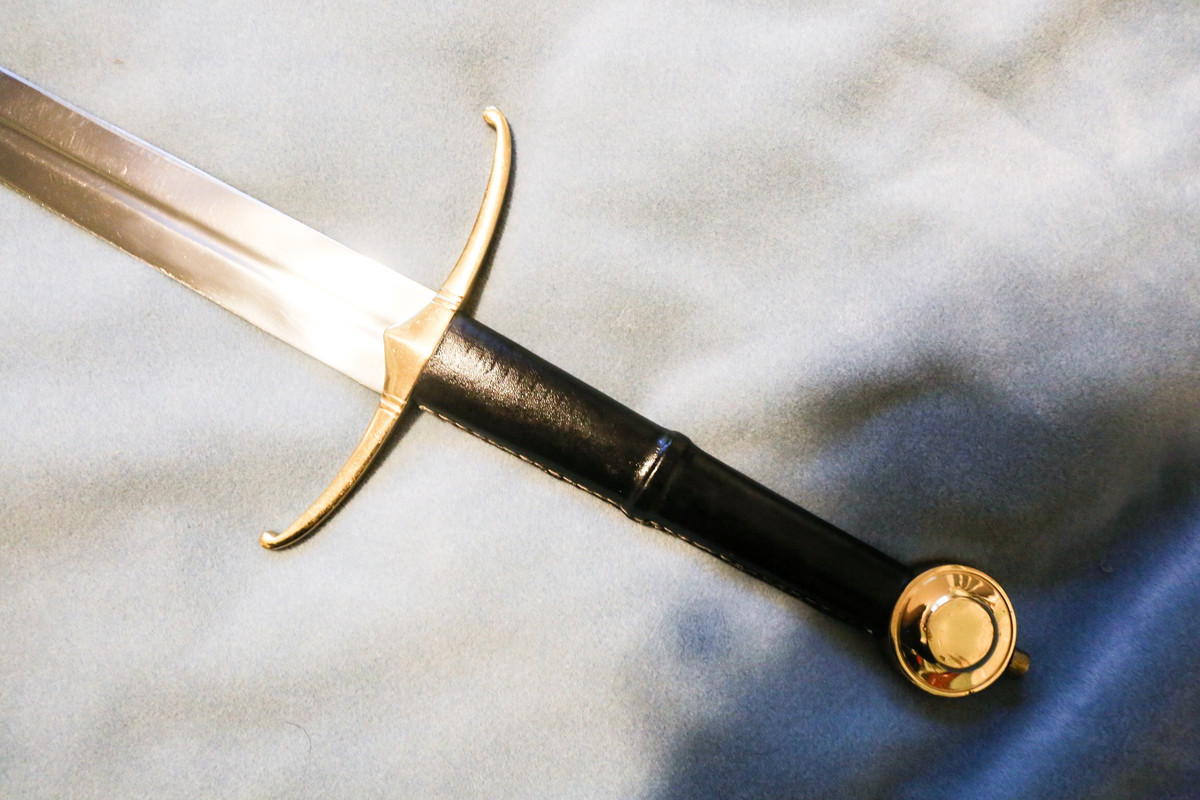 |
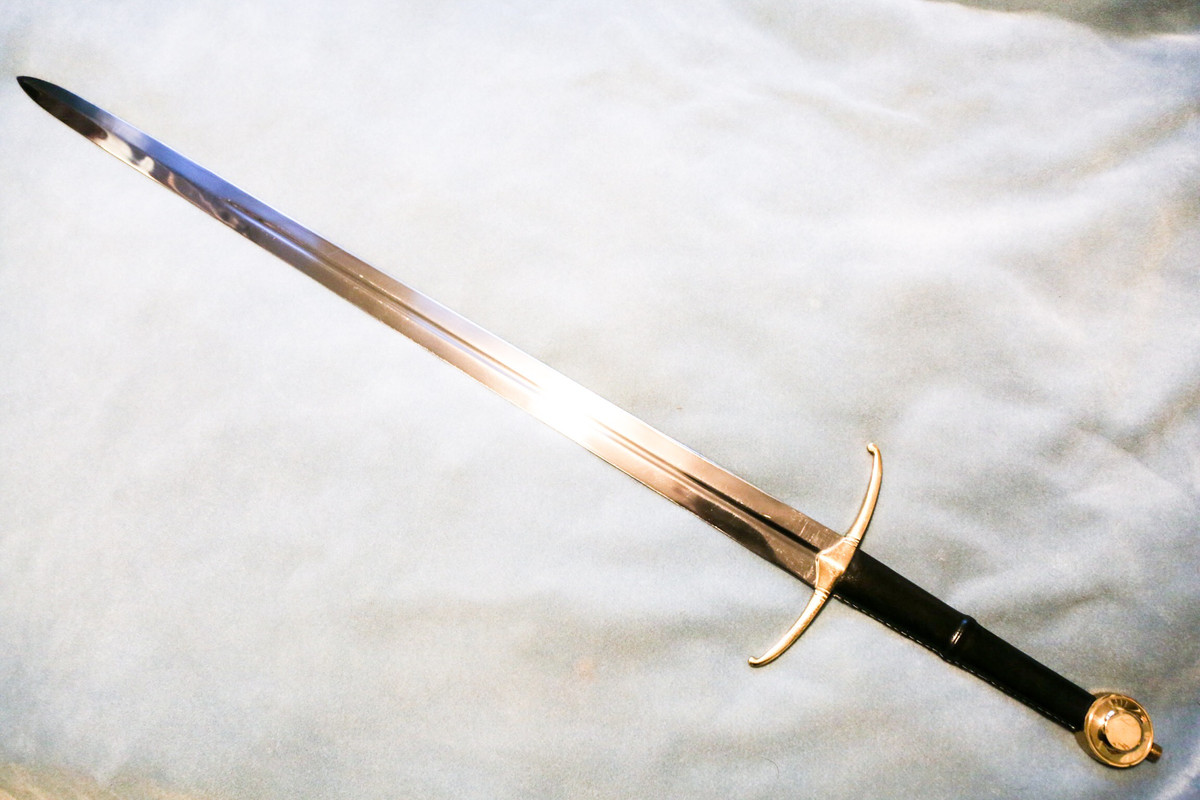 |
Del Tin - Unicorn Sword. The first sword I ever bought at age 12. Early MRL purchase that i saved ALL summer for working odd jobs. Made of CK-55 Krupp steel (I think a german AISI 1055 equivalent?). Fun little sword. Maybe will someday be a rehilt project as well but have been reticent to touch it because it was my first sword. You can read my full review of this sword here.
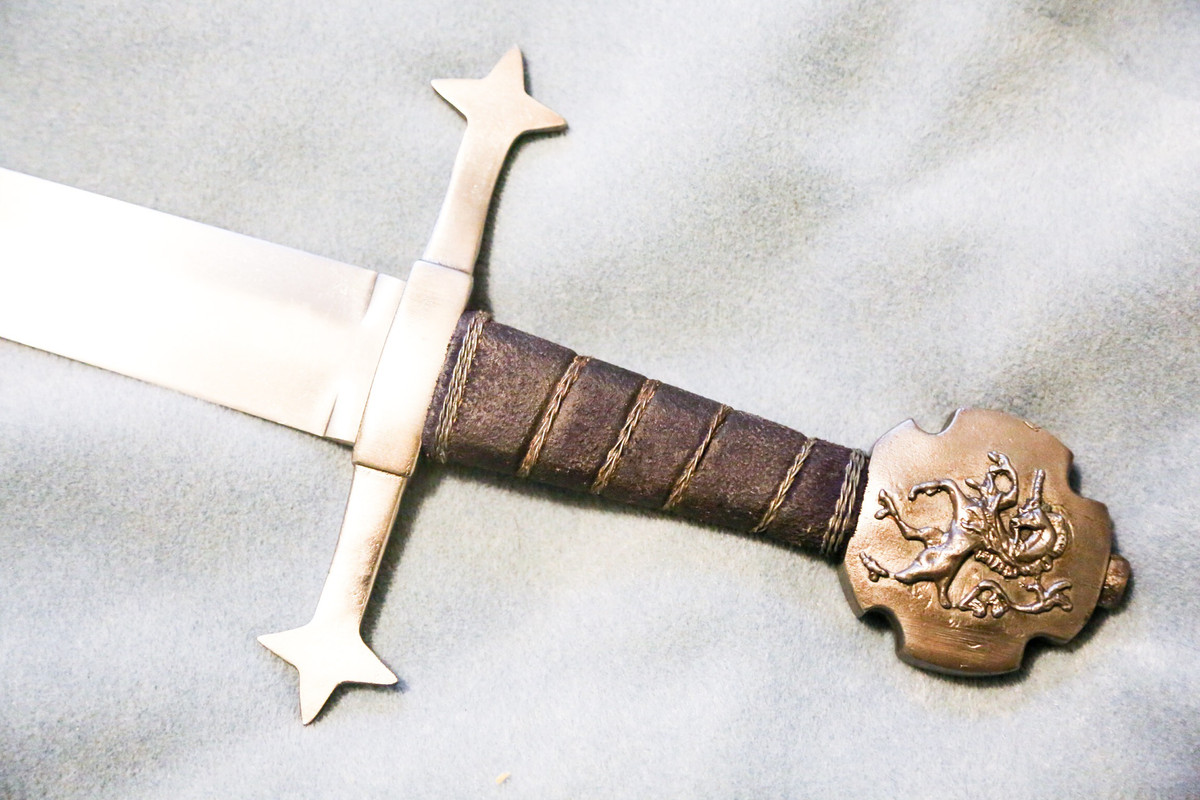 |
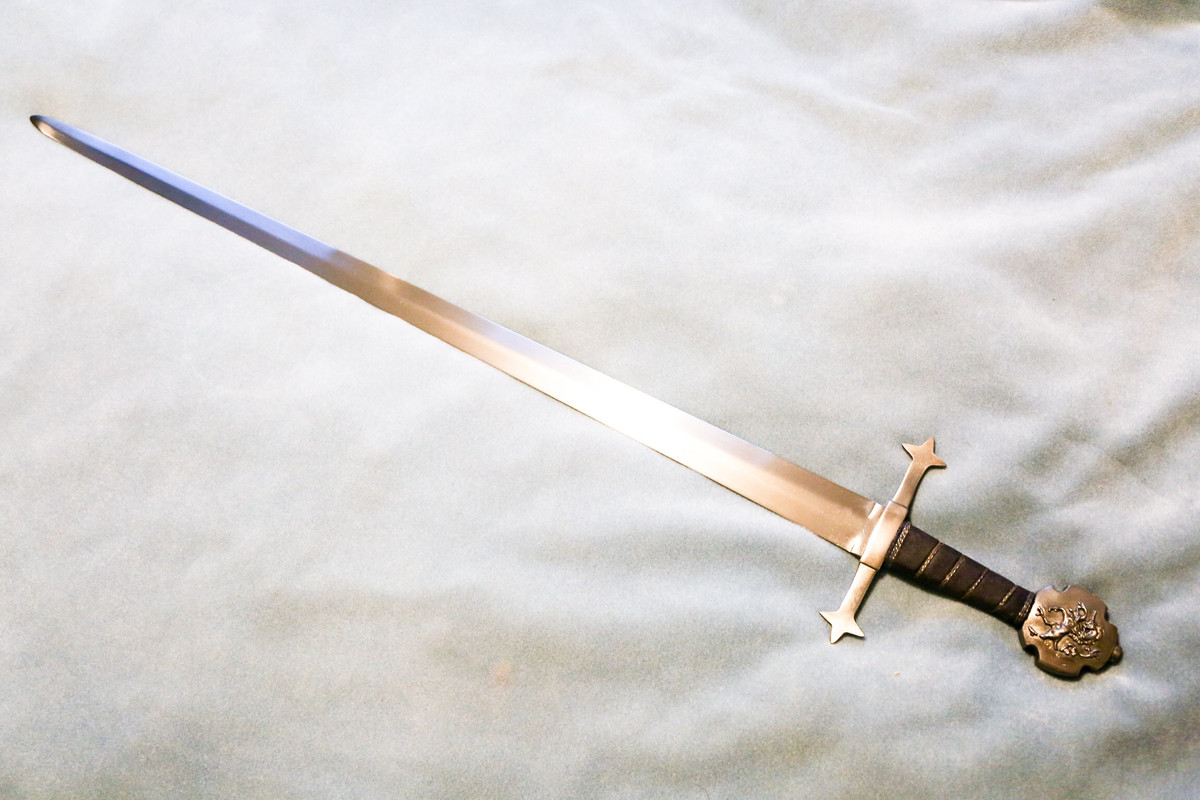 |
HSTS - Custom Katana. I'll not say much given conversation about this vendor is verboten, but some of my favorite reproduction katana. Differentially hardened 1095 steel with a good spring to help prevent taking a set. Excellent edge geometries. Very tight alternating ito with hishigami. Great cutters that have held up flawlessly.

HSTS - 1095 Budget Cutter Katana.

Hanwei - Shinto Katana. Early 2000s model that was originally a shirasaya no-bohi version purchased by Sanmarc Forge. It then underwent a complete revamp by SlavEdge including a hamon re-etch and a longer custom tsuka. This blade cuts like a freaking LIGHTSABER. I LOVE this sword. Sanmarc loves Shintos so much he went out and bought a Manchurian steel prototype one.
 | ||
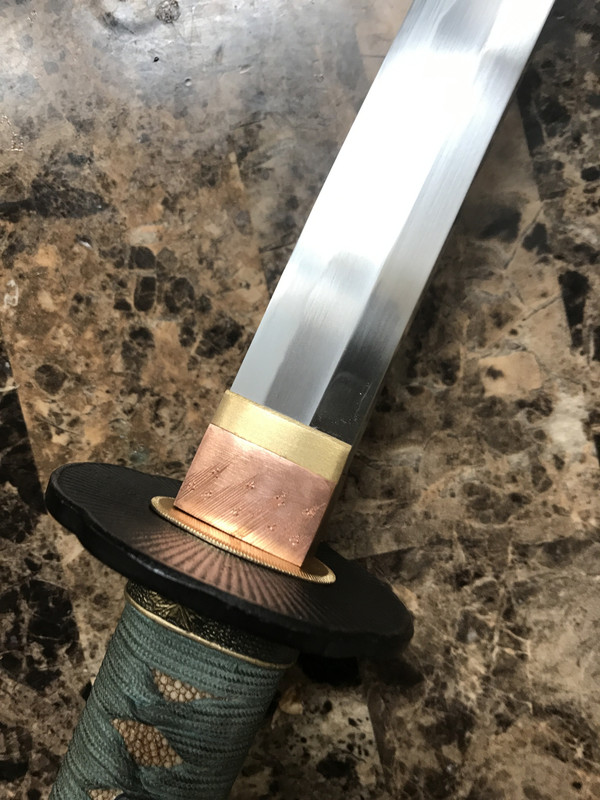 | 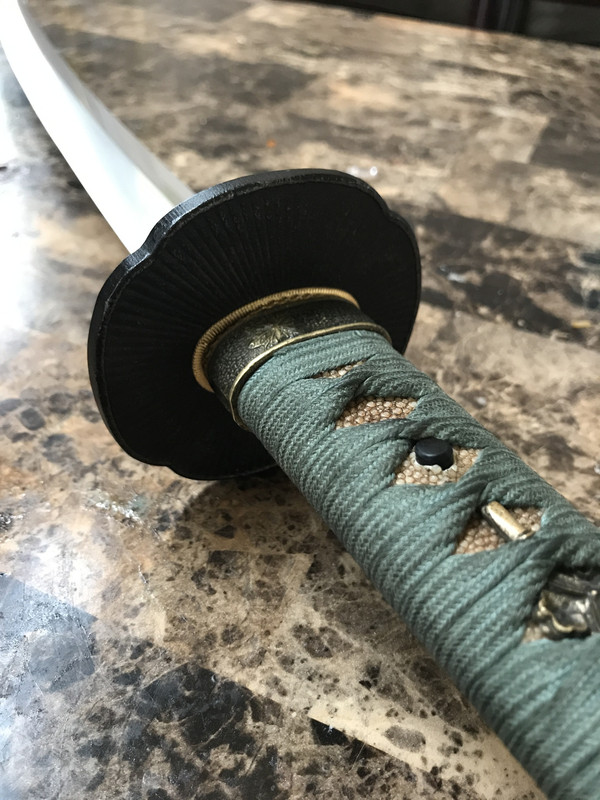 |  |
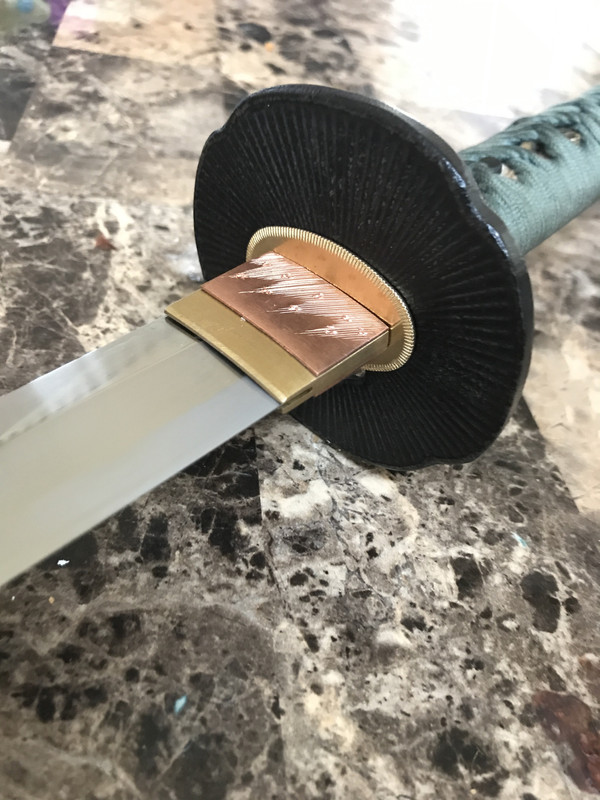 | 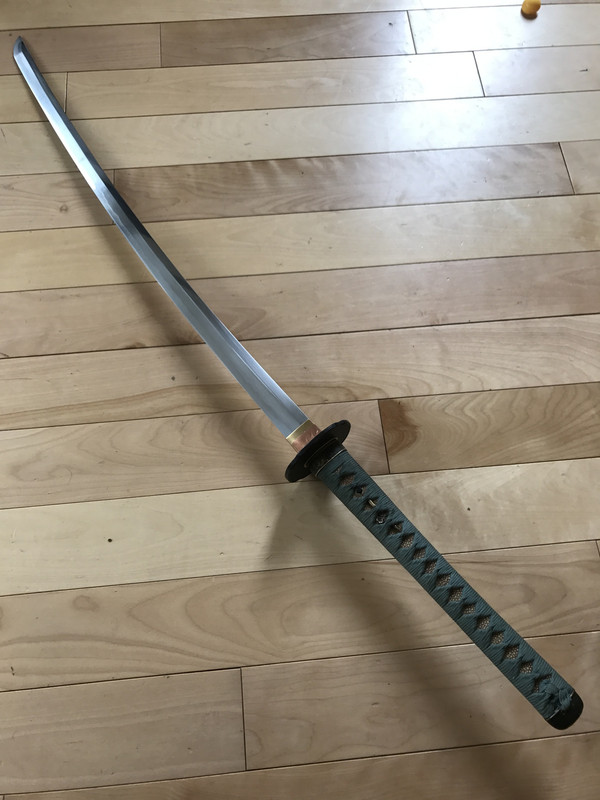 | 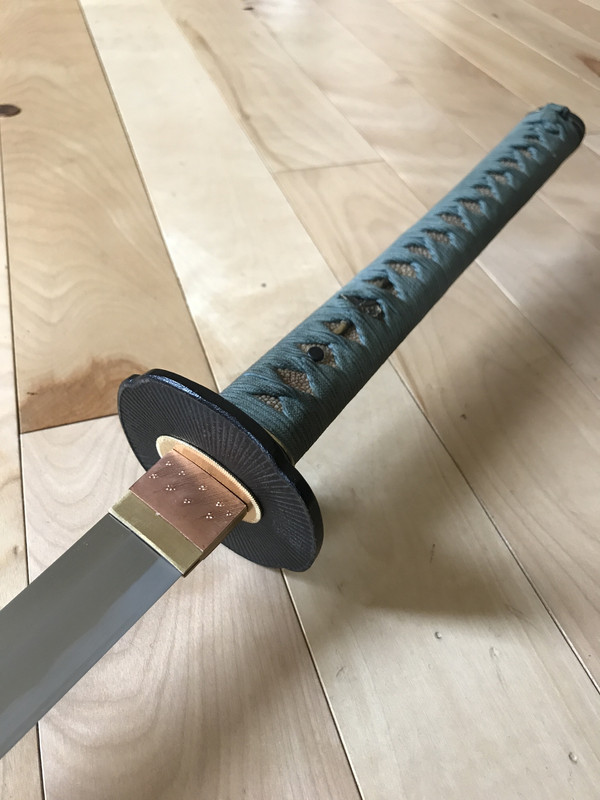 |
Huawei - T-10 Katana. Not their highest end model, but a decent middle of the road one with "geometric yakote" (don't get me started, as I own multiple nihonto and what most forges call geometric yakote are not exactly correct, yes technically they have a geometry change, but definitely NOT exactly historical in correctness). A fabulous blade with a gunome/midare hamon and hishigami itomaki. Razor sharp and is a wonderful cutter that has held up flawlessly.

Kawashima - Ko-Katana. Unclear yet on manufacturer but clearly a higher end blade when compared to other reproductions. I'd say of equivalent quality to a high end Paul Chen or such. It's mono steel of some kind, from the luster I'd say probably 1095. The tsuka is well executed and ito is tight. The saya is well made and fits the blade perfectly and is accented with a nice rattan wrap that is lacquered. If anyone knows what this might be I'd love to hear opinions. I am currently thinking this is a Kawashima of some sort. Possibly a custom Kawashima.
 |  | ||
 | 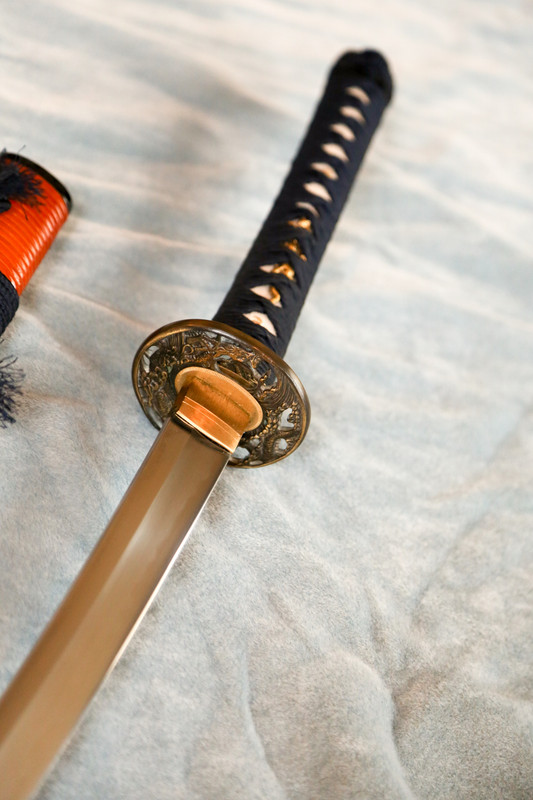 |  | |
 | 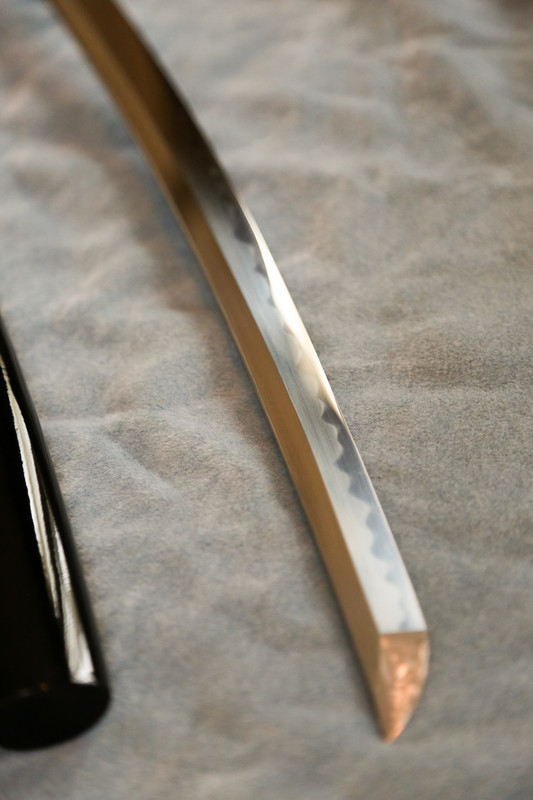 | 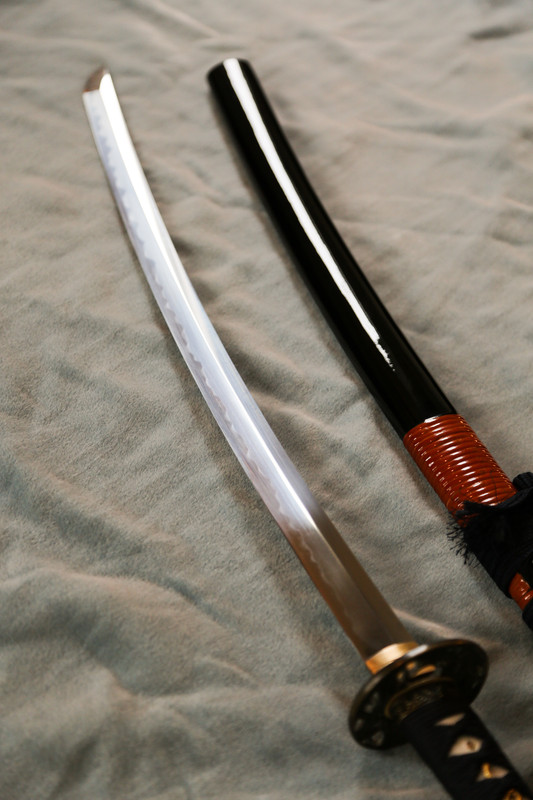 | |
Daishos
Ten Ryu - Daisho, Katana (model TR-004) and Wakizashi (TR-005). Personally my favorite sub $150 katana (these sell for about $125) and Wakizashi for under $100 ($85 current price). AISI 1045 differentially hardened steel so not the hardest, however, there are some details (most specifically the actual (magnetic) iron musashi style Tsuba which you NEVER find at this price point, a pretty decent hamon with lots of activity and while 1045 the heat treat seems solid. I've done lots of cutting with these and they are holding up VERY nicely.
 |  |
Unknown Daisho. I don't know much about these, other than they are clearly through hardened, double pegged and have pretty inexpensive ito. The fittings are low-end but decent ones you find on chinese forged blades. (No pics handy but will update later with photos).
I've a modest collection of knives too but nothing particularly interesting I don't think.
 (unless you guys want to see them)
(unless you guys want to see them)Display
Display-wise I tend to do the UV-protected case and a "picture collage" type wall layout in my home. This makes them nice displays and placates the Mrs. when it comes to swords everywhere (though she also likes swords, but wants our home to remain elegant looking). Also helps keep unwanted fingers off the blades.
Here are some examples of how I have my blades displayed:




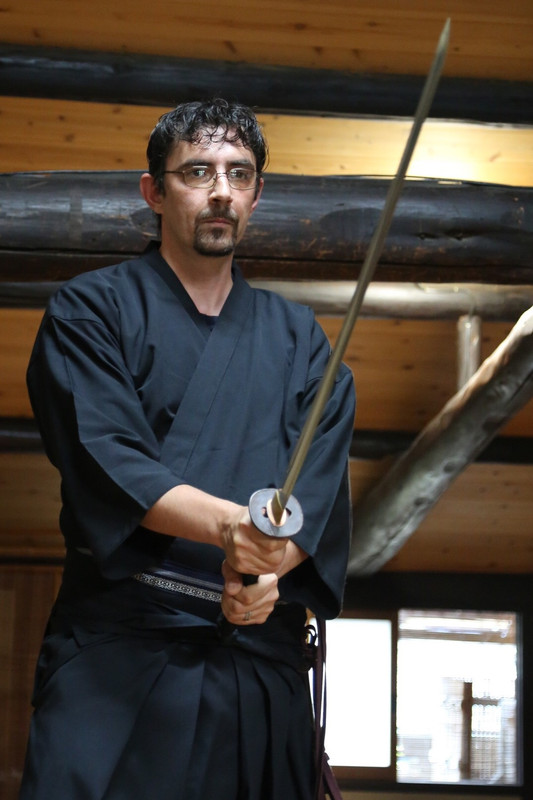


 Seriously though, your collection is amazing.
Seriously though, your collection is amazing.
